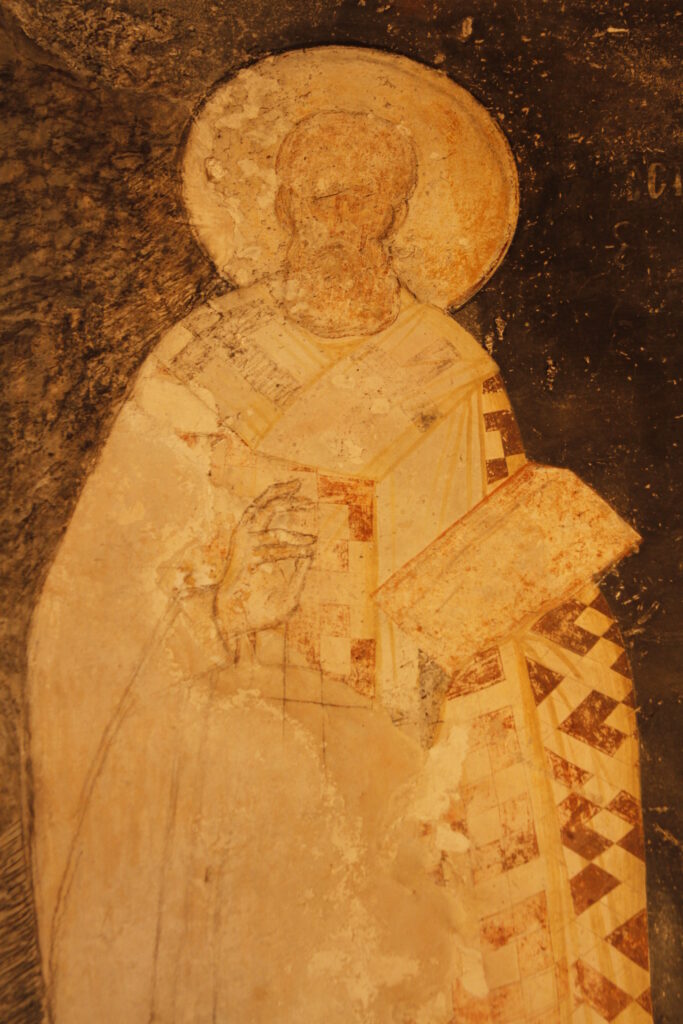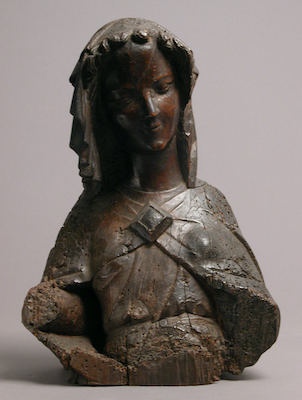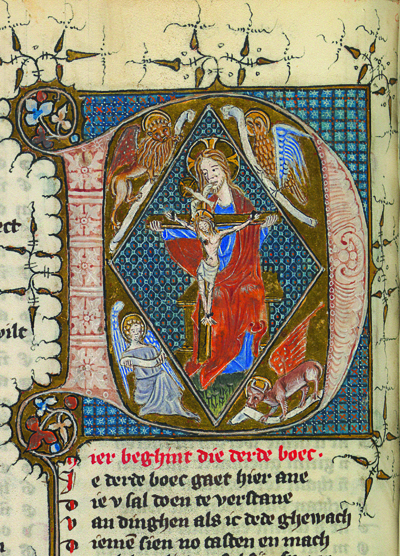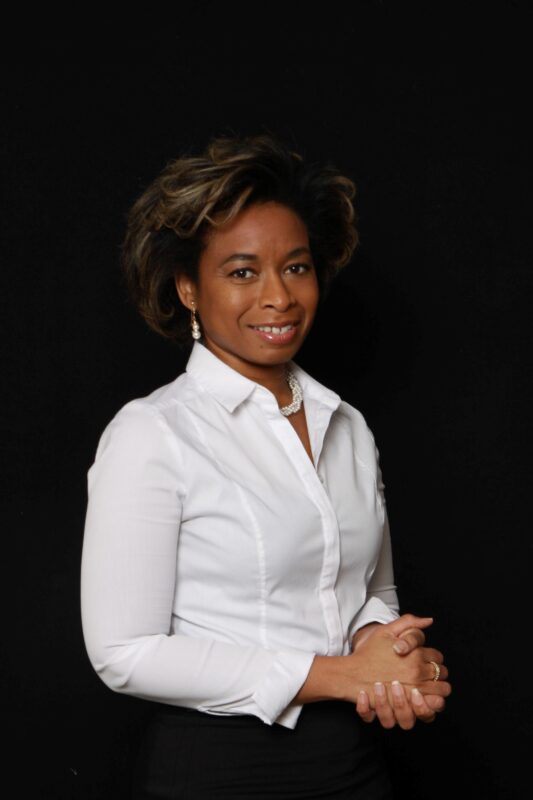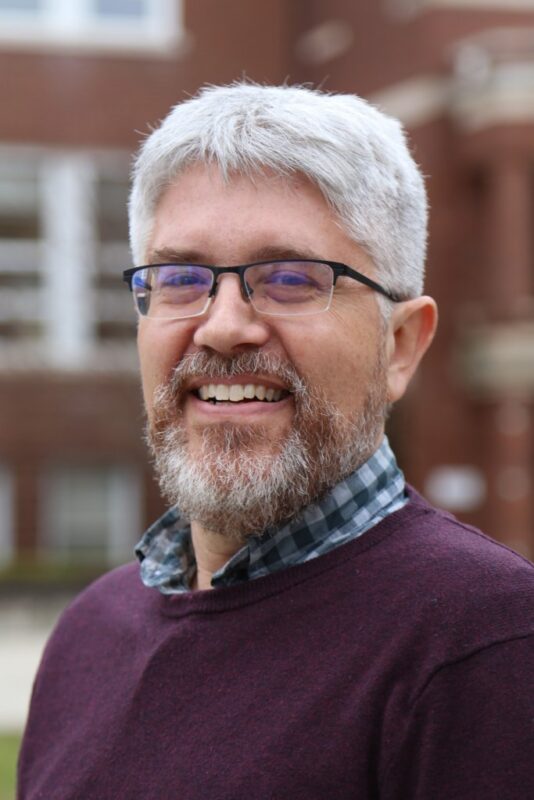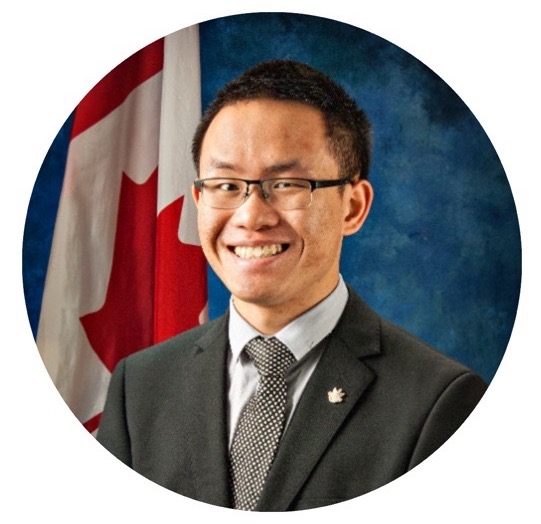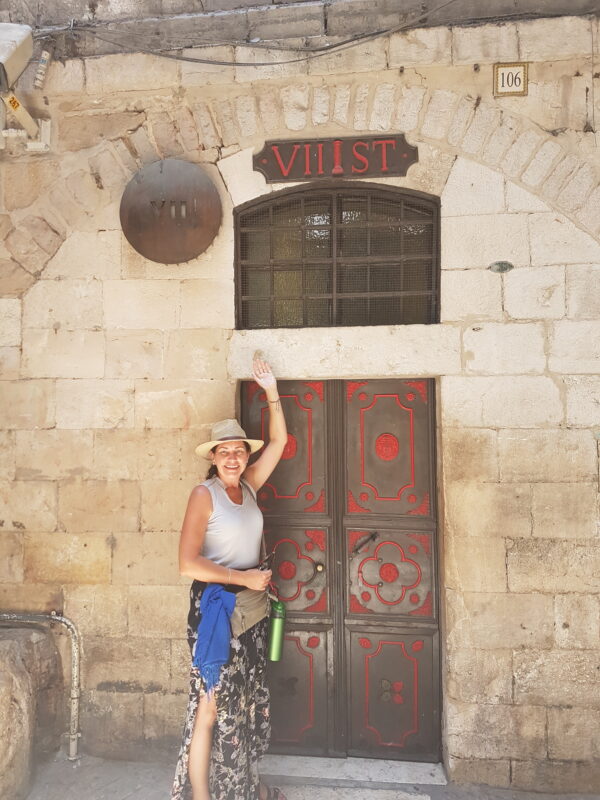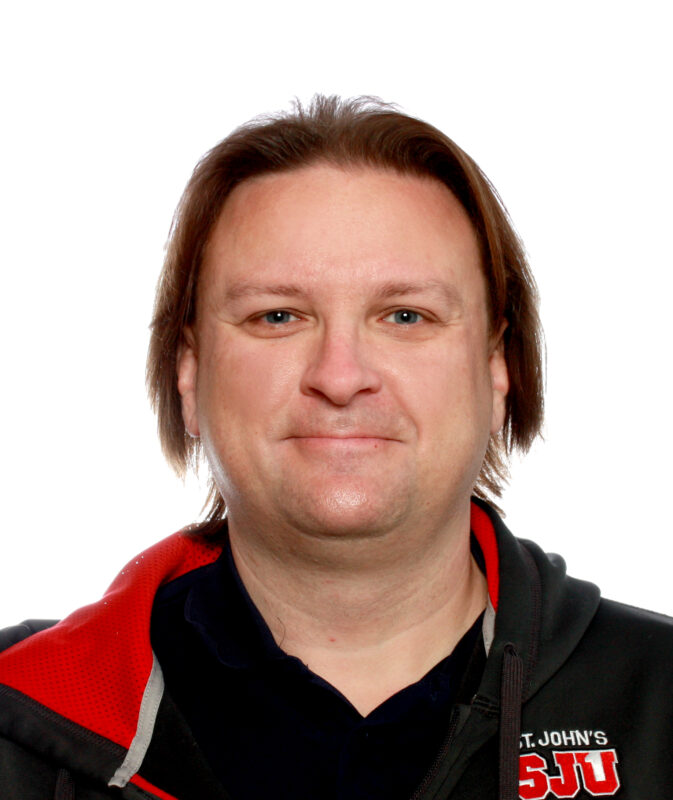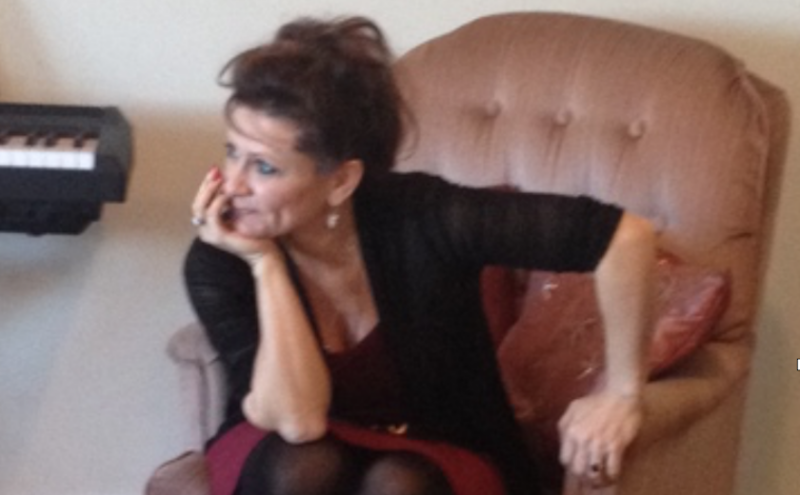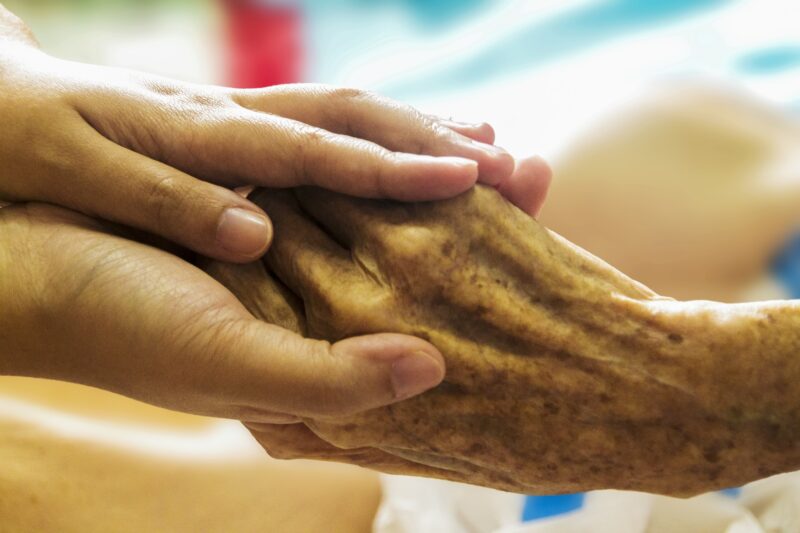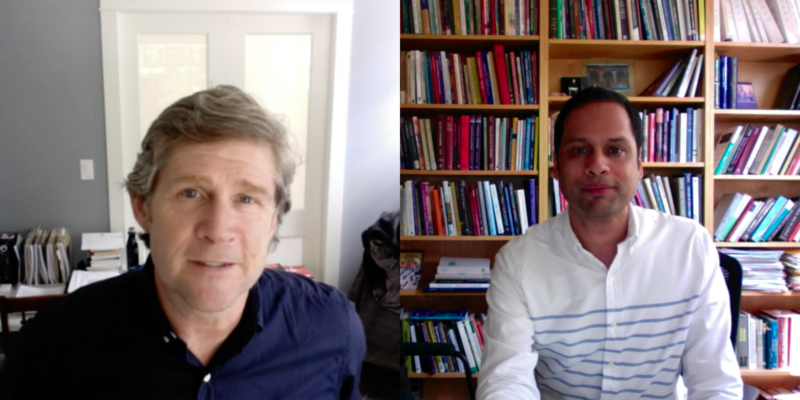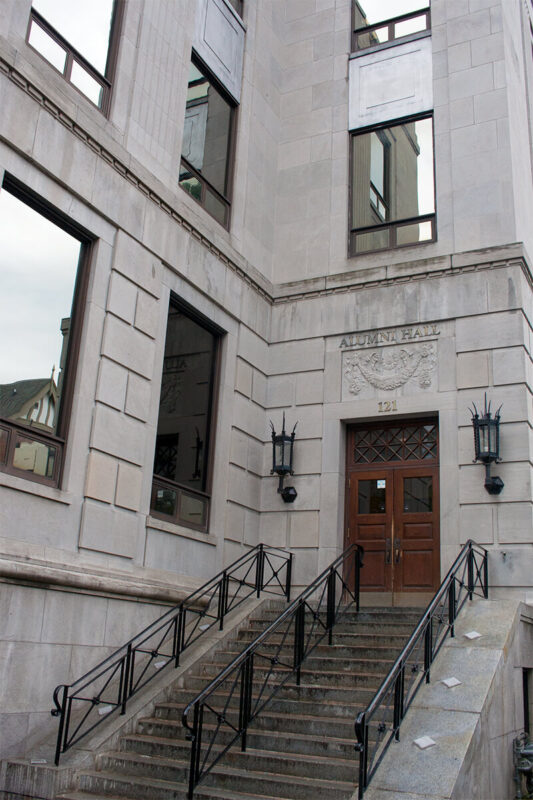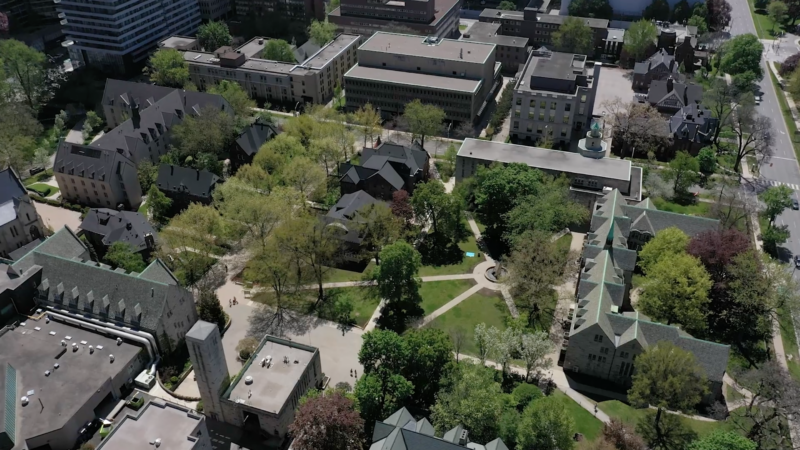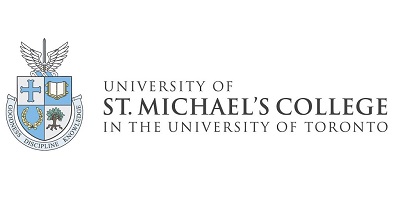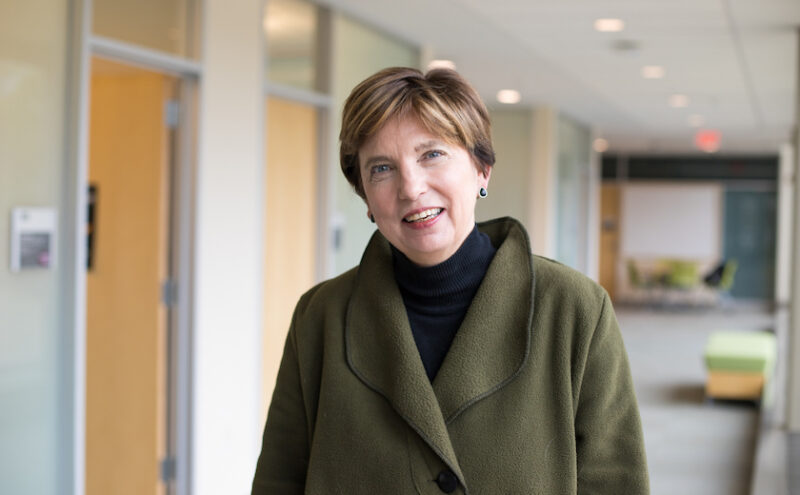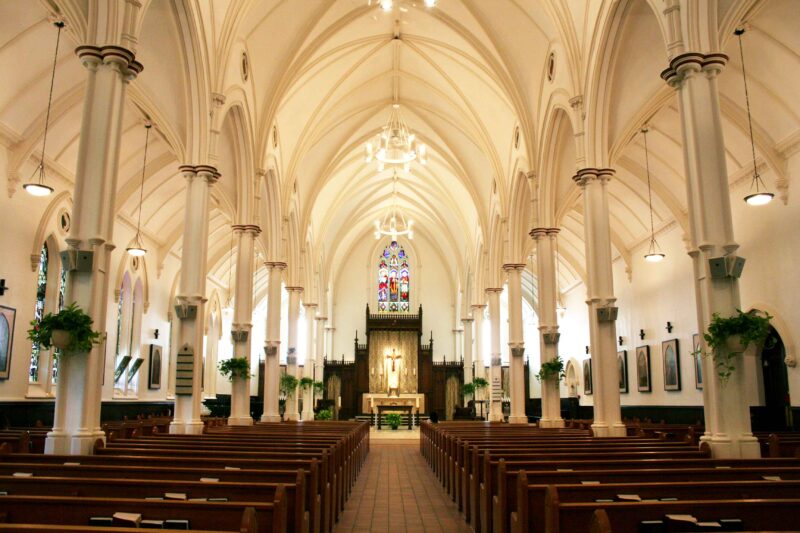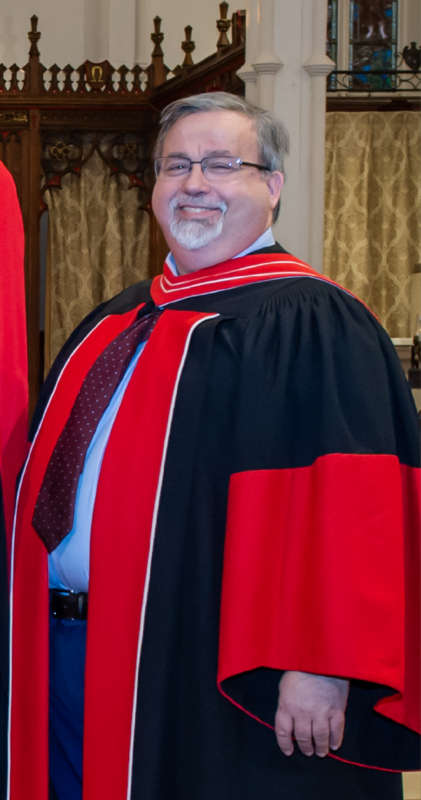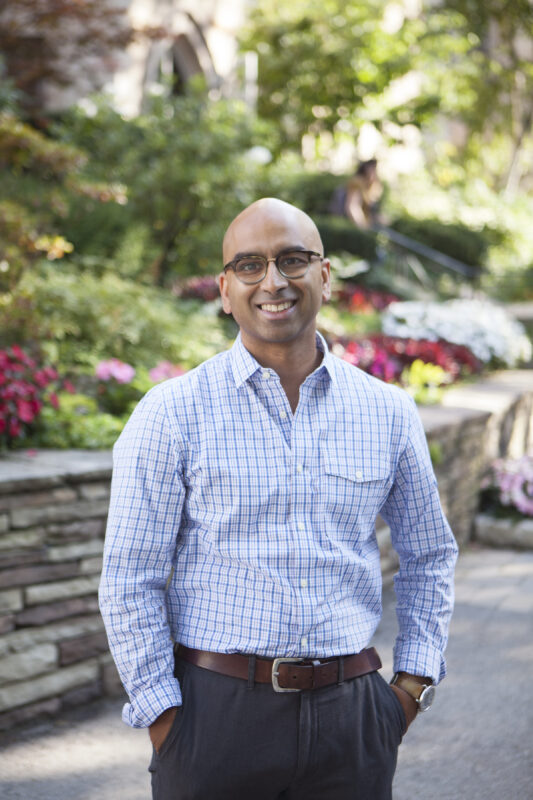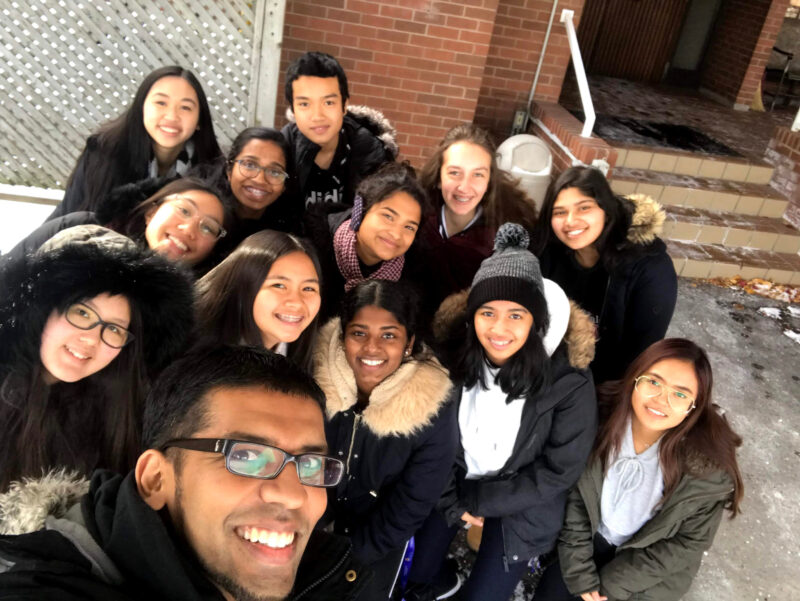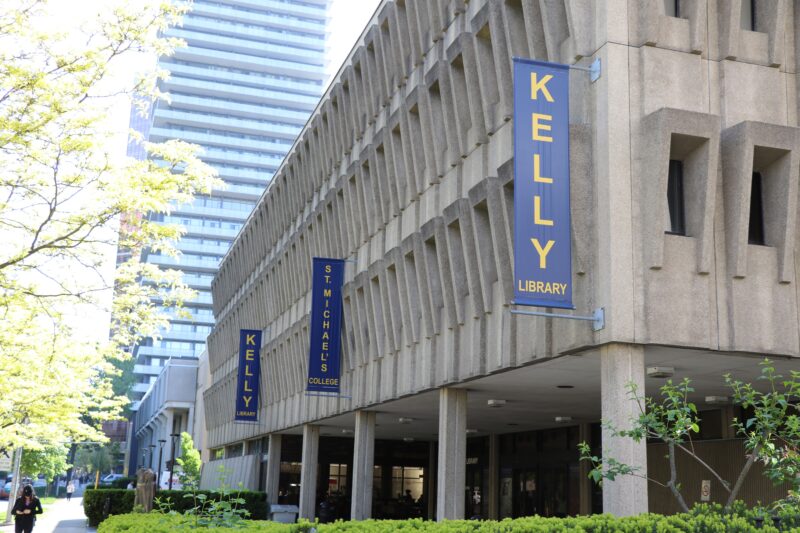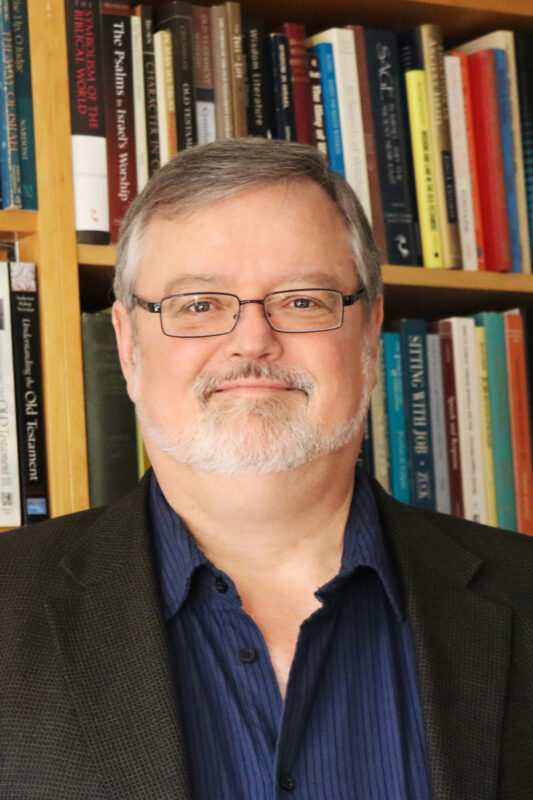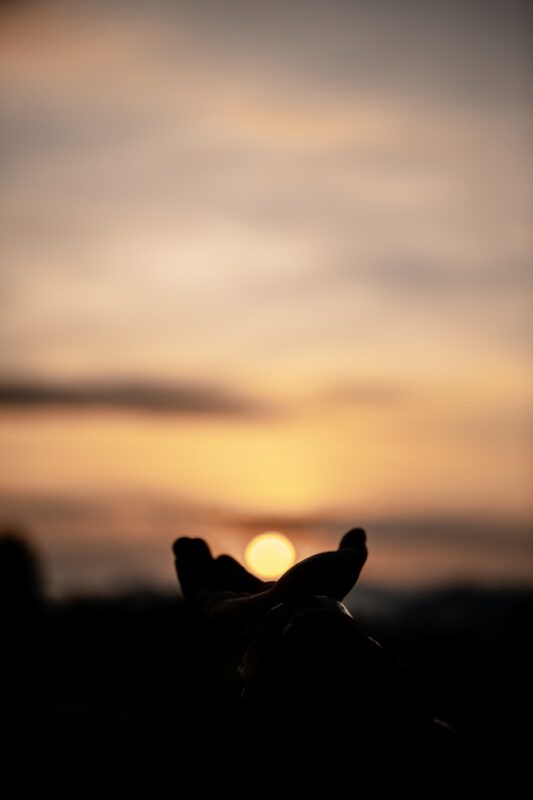Andrew Selvam is an alum of the Faculty of Theology who serves as a chaplaincy leader at St. Marguerite d’Youville Catholic Secondary School in Brampton, ON. In his spare time, he…works with kids, so there is no spare time, lol.
Not too long ago, around this time of year, it felt like we were in a different world – a world transformed, where everyone stood a distance apart, where the environment had an opportunity to reset, where you could only see a third of a person’s face and where the classroom was accessible through a computer screen. Fast forward four years and it seems as if life as returned back to normal, that hope has returned, when at times it didn’t seem that it would.
In the latter days of Lent, we are reminded of this beautiful season of prayer, fasting and almsgiving. The imagery of the season reminds us of the wilderness in which Jesus spends his time as he begins to embark on his ministry.
The season of Lent has always been an opportunity for me to reflect on mine. Now a little closer to home, but in a much larger school, the ministry God has called me to at St. Marguerite d’Youville Catholic Secondary School has changed from my time in South Mississauga. Still very much focused on building community, faith formation, and service opportunities, I get to work with a pretty dynamic community, diverse in nature and energetic to say the least. Every day is an opportunity to engage with students in a way that allows me to accompany them in the desert of whatever they might be going through, and their presence coincidentally does the same for me. No day in the wilderness of teenagers is ever the same, and I don’t think I would have it any other way.
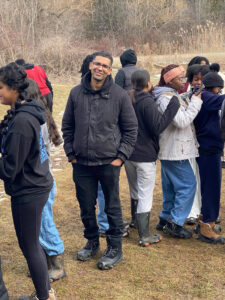
The last days of Lent slowly move towards Holy Week, a period of time where we reflect on the suffering and death of Jesus, but His immense love bursts forth in joy and victory when the stone is rolled away from his tomb three days later. It’s a reminder that Easter is anticipation, Easter is hope, Easter is true joy.
Every morning, I have kids without fail in my office, chatting it up, greeting their friends (they haven’t seen in less than 12 hours) and always asking for food. When I’m not in front of the computer or prepping for the next event in the school, I get the privilege of talking to kids about their lives, about what makes them tick, about their relationships and the status of them, not only about their struggles, but their joys. When I’m not in the office, you can guarantee I am reminded! But each day and most interactions are an opportunity for a little Easter on the daily, a reminder of the joy and hope of young people.
Asking students to commit to their faith is never an easy task. Our schools are the second parent of learning in all aspects for young people. But it’s a challenge that I’ve enjoyed for the last 18 years of education, where there is never a dull moment, and where the reward of seeing a young person change the world in their own way is its own Easter-like reward. The student who still comes to chaplaincy seven months later, the increasing number of students attending mass on a Friday morning at 7:30 am, the students willing to take up space as they embrace their culture and personal excellence, the students who make a school dance feel like a wholesome family celebration, and students ready to hear the cry of those who go without and respond in various ways.
It is said that we are called to be a resurrection people, a people of hope, and I think this becomes increasingly possible when young people are around. From the ones I encounter at school, in my parish youth choir, and youth ministry, I get reminded every day that there is hope, that there is love, and that there is joy! I am insistent on the fact that the Holy Spirit lurks through the walls of every school building, just waiting to get stirred and activated. It always gives me hope to know that young people make that happen. It doesn’t happen overnight, or in three days even, but when the spirit and glory of God is around, transformation happens everywhere, including for me. Hallelujah is a form of praise to God and while it’s a word, it truly encompasses the many ways young people have glorified him in their actions, regardless of their stories and histories. St. John Paul II reminds us firmly that we are an Easter people and hallelujah is our song. I am glad to say that I work with and serve Easter people every day and because of the young people I work with, hallelujah has become our jam!
Read other InsightOut posts.

Montreal, March 14, 2024 – The Society of Jesus (the Jesuits) announced the appointment of Father Jeffrey S. Burwell, SJ, as the next Provincial of the Jesuits of Canada. This appointment is the culmination of a thoughtful, prayerful process of consultation and discernment, marking a significant milestone for the Canadian Province.
Father Burwell will succeed Fr. Erik Oland, assuming his new responsibilities on July 31, 2024, with an inaugural Mass at Our Lady of Lourdes Parish in Toronto. A special celebration will also take place at the Jesuit infirmary in Richelieu, Quebec, on the Feast of the Assumption, August 15, 2024.
The University of St. Michael’s College congratulates Fr. Burwell on his appointment and gives thanks for the service of Fr. Erik Oland.
More information about the appointment is available on the Jesuits of Canada website.
On March 8, the world celebrates International Women’s Day. This year’s theme is “Inspire Inclusion.” Regis St. Michael’s female faculty members are contributing to this by hosting a luncheon on Friday for RSM female studies. In recognition of intersectionality and that female students tend to be the minority in theological studies, especially in the Advanced Degree level, Friday’s gathering hopes to help foster a sense of belonging and empowerment.
Regis College is working to “Inspire Inclusion” through raising the profile of RSM’s female
faculty members and other female theologians from historically marginalized groups, such as M. Shawn Copeland and Cristina Lledo-Gomez.
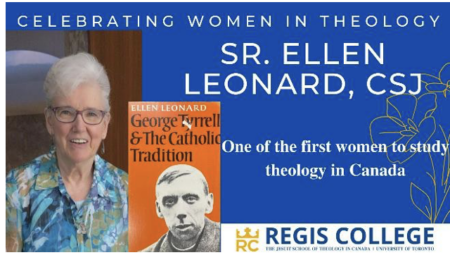
Each of these distinguished scholars are publicly recognized on our welcome slides at the South
Atrium Doors (facing Wellesley), and throughout the month, we will be sharing these slides on social media and thanking each individual for their contribution to theology. Among those recognized are Margaret Brennan, the first female theology professor at Regis College, and Ellen Leonard, one of the first women to study theology in Canada and to teach at the University of St. Michael’s College Faculty of Theology.
We are committed to inspiring and practicing inclusion. Let us journey in the synodal way with women of all walks of life and work towards a just society.
Catherine Mulroney is a double alumna of the University of St. Michael’s College and now serves as the
university’s Editorial Manager. She is almost ready to begin describing herself as a lifetime learner.
I’ve said it before and now I’m saying it again: I’m heading back to school.
Come the fall I’ll be working part-time on a Master of Theology (ThM) degree at the Regis St. Michael’s Faculty of Theology and I couldn’t be more delighted.
The first time I returned to school was 2004. I had four children at home, a busy freelance career, a full volunteer calendar, and a husband often described as a happy workaholic. Adding school into the mix was perhaps the most counter-intuitive thing I’d ever done.
My mother had died the year before and her death had given rise in me to many deep questions about life, as well as some surprising insights into my own beliefs. This was all so out of character that I felt called to do something about it. I decided I needed to study, without a clue as to what to expect. I assumed I’d get some questions answered, put in my time to earn another degree, and then return to my regularly scheduled life. My experience, however, was anything but.
Accepted into the Master of Theological Studies (MTS) program at St. Michael’s Faculty of Theology, I registered for two courses in the fall semester. Just weeks after my return, though, the occasional indicators of dementia my father had been manifesting turned into a full-blown crisis. Suddenly, school was not just something I did but a place where, for four hours a week, I could escape some inescapable pressures and responsibility, pouring myself into courses that at once allowed me to disconnect while also offering insights into how to handle my father’s illness. Weekly liturgies in the gorgeous Basilian Centre chapel offered respite and a way to shore up my emotions in a turbulent family time. I carved out reading time late in the evening. My studies became at once a safe space and an instruction manual into how to cope with life’s big issues.
As my father’s illness progressed, I yet again opted to swim upstream, switching my program from a 20-credit Master of Theological Studies degree to a 30-credit Master of Divinity (MDiv) degree. Every time I looked at the course catalogue there were more offerings than I could fit into my original plans, and I realized that the MDiv, with its pastoral focus, was really the degree I’d been looking for.
I could easily imagine myself back in the classroom and the Kelly Library, but I hadn’t anticipated all the value-addeds my time studying theology held out. I began to conquer a fear of public speaking that had arisen, unexpected, as an undergrad. The field placement requirement of the MDiv introduced me to my parish RCIA program. I agreed to run the program, thinking it would be a year-long commitment. Instead, I fell in love with the experience and continued running the program for another 10 years. And when it came time to return to the workforce full-time, I could place myself in one of the country’s smallest professional niches – a journalist with theological training.
It wasn’t always easy being in school at this point in my life. It took me six years to complete my degree, but I assure you – every second was worth it.
Thinking back on my MDiv experience, perhaps the most surprising thing about being back in school was the community I found myself in. I had been worried that I would be the oldest person in my classes but I was met by an impressive range of ages and experiences and soon found my own way to fit in because by its very nature – and its purpose – theology is a place where everyone fits in.
When it came time to place my father in long-term care, I was able to consult a professor of Catholic ethics on how to fill out the obligatory medical intervention form so that it would best reflect Dad’s wishes.
There was the invitation to a classmate’s ordination, an experience that left me unexpectedly teary-eyed when I watched his own ailing dad, very close to death, help his son don his vestments.
And when my husband died after a brief illness, several years after I graduated, I was beyond touched to look out at his memorial service and see not only former classmates but also Faculty staff and professors who had taught me. This community was still with me, and I was still a part of it.
Now here I am, 20 years after my first return to school, glancing through the course catalogue once again. Much has changed in the interim. Widowed, with just one adult child still at home, my time is freer. St. Michael’s Faculty of Theology is now the Regis St. Michael’s Faculty of Theology and the one online course I took, then deemed an experiment, has given way to a great deal of online learning, post-pandemic. Some of the professors with whom I studied have retired, while there are some new faces to get to know. And this time, I have a clear objective: to write a thesis on the negative impact social media can have on Catholic discourse.
Some things, though, will remain the same. Undoubtedly, rather than offering pat responses, my courses will open new avenues of thought and will leave me with even more questions than when I started. I can assure you that, when I graduate, the Trinity will still be a mystery. And that’s all okay, because now I know that the study of theology is open-ended, a lifetime occupation.
This time, I am heading back to school with my eyes wide open. My heart, meanwhile, is prepared for surprises.
Read other InsightOut posts.
Visit the Regis St. Michael’s Faculty of Theology website.
A new project from the Regis St. Michael’s Faculty of Theology (RSM) will offer educators the tools needed to help adolescents deal with the growing challenge of climate anxiety.
Climate anxiety – also known by such terms as eco-anxiety, climate grief, or climate trauma – refers to the negative impact climate change can have on mental health. Numerous surveys indicate the experience of worries and fears for the future brought on by climate change is growing and is particularly intense among adolescents and young adults.
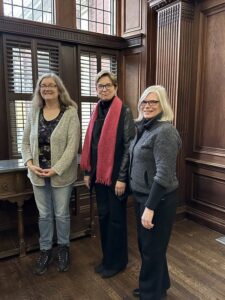
Now, RSM Professors Hilda Koster and Cynthia Cameron are launching Critical Conversations in Catholic Education: Climate Change and Eco-Social Resilience, a series of free workshops and a conference designed to engage educators in a conversation about how best to support adolescents and young adults in the face of a rapidly changing world.
“Young people are caught in a moment of feeling overwhelmed, and feeling hopelessness in the face of it all,” says Koster, who is an Associate Professor of Eco-Theology and the Director of the Elliott Allen Institute for Theology and Ecology. She also holds the Sisters of St. Joseph of Toronto Chair in Theology at RSM.
Climate anxiety “is a spiritual problem, and not just a problem of morals. It’s an existential issue,” she says, noting that the syndrome can result in apathy, isolation, and depression. “It’s hard to feel connected when you are anxious.”
Koster notes that while many Catholic schools now include Laudato Si’, Pope Francis’s groundbreaking encyclical on the environment, in their curriculum, there is a new but growing body of research and literature on climate anxiety that teachers may not be aware of yet. The two professors plan to draw on familiar spiritual resources such as Laudato Si’ (also referred to ‘On care for our common home’), which was promulgated in 2015, while also introducing newer materials specifically addressing climate anxiety.
“We want to help school boards and teachers connect the dots between the ecological, religious, and mental health aspects of this issue,” says Cameron, who is Assistant Professor of Catholic Education at RSM and holds the Patrick and Barbara Keenan Chair in Religious Education. Everyone working in a Catholic school is a religious educator, she notes, and so findings ways to help students develop resilience in the face of climate anxiety touches everyone from the chaplain to English, science and health teachers, for example, through to administrative staff.
The project is designed primarily to address issues emerging in the Grs. 7-12 range, with particular emphasis on the high school years, Cameron explains, noting there is a “confluence of anxiety and depression that begins to increase around the age of 11 or 12.”
While the Critical Conversations workshops will be presented through a Catholic lens, many of the lessons learned will be applicable to all students regardless of faith tradition, she adds.
Doctoral candidate Rosemary Boissonneau, who is also working on Critical Conversations, sees the project being particularly helpful to new teachers. While not the target age of the project, many young teachers are also facing their own climate fears, she says, questioning, for example, the risks their own children may face if climate change is not controlled. These personal worries come as they work with students who are extremely stressed by the topic – one of the factors that can lead to teacher burnout, says Boissonneau, a teacher herself.
The first workshop will be led by Cameron and Koster, focussing on the topic of “Climate Anxiety, Education, and Catholic Social Teaching” In addition, there will be a presentation by teacher and alumna Gabrielle Chan on her research for her Master of Theological Studies thesis on “Laudato Si’, Climate Anxiety and Youth.” Boissonneau will speak on her work as an educator, climate activist with “Fridays for Future” and “The Laudato Si’ Movement,” and a biblical scholar.
This workshop is co-sponsored by the Halton Catholic District School Board and the Dufferin-Peel Catholic District School Board and takes place on Wednesday, February 21 from 4:30-6 pm at St. Francis Xavier Secondary School, 1145 Bronte Street South, Milton, with an online option available.
The second workshop, “Science, Suffering, and Eco-Theology,” will be held on Wednesday, April 17, will include a presentation by Prof. Adam Hincks, S.J., who is Assistant Professor and the Sutton Family Chair in Science, Christianity and Cultures at St. Michael’s. He will be joined by RSM’s Prof. J.P. Fortin, who is Associate Professor of Practical Theology, and doctoral student Deanna Zantingh, whose research area focuses on Indigenous youth suicide and environmental devastation. Sr. Mary Anne Francalanza, fcJ, a science teacher who is working toward a diploma in Theology and Ecology will also be speaking. This second workshop is sponsored by the Durham Catholic District School Board at its Pope Francis Conference Centre, at 652 Rossland Rd. W. in Oshawa. This event will also be offered online.
While the workshops are designed primarily for teachers, the concluding day-long conference will have a broader audience, including students from the Toronto School of Theology and various faculties and departments at the University of Toronto. Youth, Climate Anxiety and Religious Education, which takes place on Saturday, Oct. 5 on campus, will feature Prof. Joyce Mercer, a professor of practical theology and pastoral care at the Yale Divinity School who has written on the topic of children and climate anxiety.
Along with a keynote address, the conference will include panel discussions, opportunities for networking, and tables of information.
“This project is a two-way street,” says Koster, who says that she and Cameron look forward to listening to and learning from the experiences of teachers working with adolescents to further their own work.
The Critical Conversations project is being funded by a Moving Forward in Mission grant from the Association of Theological Schools, RSM’s accrediting body. The professors note that the grant’s stated purpose reflects RSM’s commitment to serve the broader community, offering educational outreach to answer critical issues of the day.
The University of St. Michael’s College community is remembering Fr. William Irwin CSB as a gifted professor, an inspiring homilist, and a man of extraordinary pastoral skills who cared deeply for his students.
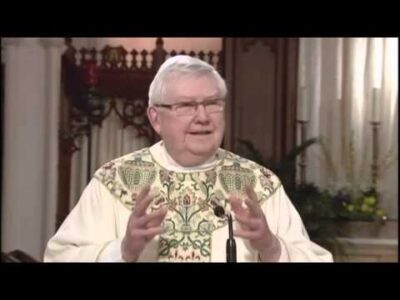
Fr. Irwin, who died on Dec. 6 at the age of 91, was a biblical scholar who specialized in in the Book of Isaiah and the Book of Psalms. He taught at St. Michael’s Faculty of Theology for decades, serving as Dean of the Faculty from 1981-1985. From 2001-2004 he was President of Assumption University in Windsor, On.
Born in Houston, Texas, Fr. Irwin earned a BA and an MA from the University of Toronto and a Baccalaureate in Sacred Theology from St. Michael’s before going on to further studies at the Angelicum and the Pontifical Biblical Institute in Rome. Ordained a priest in 1959, he joined the Faculty in 1965 and continued teaching part-time into his 80s, well past his formal retirement date.
“Fr. Irwin is one more example of the tremendous debt St. Michael’s owes to the Basilian Fathers,” said Prof. Jaroslav Skira, Dean of the Regis St. Michael’s Faculty of Theology. “I am particularly grateful for his dedication as Dean of the Faculty of Theology, for his scholarship in the Hebrew Scriptures, and for helping educate numerous graduates–some of whom we count as members of the Regis St. Michael’s Faculty of Theology.”
In an address to the Faculty of Theology convocation in 1985, Fr. Irwin spoke to those assembled about the importance of balancing study with lived experience, noting that “the Gospel not only enlightens but transforms,” and urging all to become engaged with the world, using their gifts to teach a message of hope. It is a model his former students recall well.
Doctoral candidate Sr. Carla Thomas O.P. who studied the Psalms with Fr. Irwin, remembers him as “a kind and gentle instructor. Fr. Bill taught by his personal presence as much as by his lecture,” she said. “I was struck that in his retirement years he still continued to teach students, in spite of all the demands that it must necessarily have made on him in so many ways. I remember him telling us that his favorite psalm was Psalm 73, and that God does not punish. Rather, God leaves people to their own counsel.”
Long-time Faculty Professor John L. McLaughlin also studied under Fr. Irwin.
“Bill Irwin was my Doktorvater, directing my Ph.D. dissertation, later was my colleague, and in both roles I considered him my friend,” recalled McLaughlin. “Bill combined insightful biblical scholarship with a deep pastoral sensitivity, both inside the classroom and outside. He was one of the best, if not the best, homilist I have ever heard from a number of religious traditions. In his teaching he combined careful detailed scholarly treatment of biblical texts with the relevance of the results for the Church and the world.”
But, adds McLaughlin, Fr. Irwin “was also attentive to what students were going through. Partway through an individual Reading and Research course in the first year of my doctoral studies, I lamented that I was feeling run down, not sleeping and feeling overwhelmed, ending with ‘I don’t think I can handle a Ph.D.’ He responded that most students felt that way in the first year, then told me not to read anything new for our next meeting, just review what I had read, and told me to take at least one day and sleep. When I walked into his office two weeks later, before I could say anything he asked, “Did you sleep?” He truly cared as much for the person as he did for the project.”
In 2015, Fr. Irwin delivered the Meagher Lecture at St. Michael’s, offering a talk entitled Between Church and Theology: The St. Michael’s Faculty of Theology at 60, to mark the Faculty’s six decades of granting degrees.
He also touched the lives of students he had never taught by endowing scholarships for dozens of students in the Faculty.
Visitation will be held in the chapel of Presentation Manor, 61 Fairfax Cres. in Scarborough, on Friday, December 15 from 9:30 a.m.-10:30 a.m., with a funeral immediately following.
The new vision for theological education underpinning the Regis St. Michael’s Faculty of Theology (RSM) has been given a significant boost with a major donation from the Basilian Fathers of the University of St. Michael’s College.
The funding supports the position of the Father Terrence Forestell CSB Dean of the Regis St. Michael’s Faculty of Theology. The Faculty’s current Dean, Prof. Jaroslav Skira, will be the first person to hold the new deanship.
“I am deeply honoured to serve in this role at such an important time for RSM,” Prof. Skira said. “It is thanks to the teaching and research of gifted Faculty members like Fr. Forestell that RSM continues to have a world-class profile. It is a privilege to build upon that legacy.”
The position’s title recognizes long-time Faculty member Fr. Terrence (Terry) Forestell CSB, who taught Old and New Testament at the Faculty from 1968 to 1985, eventually specializing in the latter.
Educated at Rome’s Pontifical Biblical Institute and École biblique in Jerusalem, Fr. Forestell was known as an innovative thinker. The entry on him in the Basilian Biography notes that his lectures while teaching at St. Basil’s Seminary prior to arriving at the Faculty were “inspiring” and “courageous.”
“The Basilian Fathers of USMC are pleased to provide financial support for the Father Terrence Forestell CSB Dean of the Regis St. Michael’s Faculty of Theology,” says Rev. T. Allan Smith CSB, who is Rector, Basilian Fathers of the University of St. Michael’s College. “Over the years, Regis and St. Michael’s have worked independently but collaboratively on ensuring the best theological education for future ordained and lay ministers, religious educators, and aspiring professional theologians. The recent happy federation of the two institutions will build on their past excellence to ensure a bright future. Our contribution, made in the name of the many Basilians who studied and taught at the Faculty of Theology, is a symbol of our confidence in this new venture.”
Now in its second year of operation, RSM is a federation of Regis College, rooted in the Jesuit-Ignatian tradition, and the University of St. Michael’s College, rooted in the Basilian tradition. The new, harmonized Faculty, with shared academic and administrative units, heightens the ability of RSM to address critical issues of the day while continuing to provide the essential foundational courses to prepare students for ministry, teaching, and service to the Church and the broader community.
“The University of St. Michael’s College remains grateful to the Basilian Fathers, and especially to the priests who have served on this campus since 1852,” said University President David Sylvester. “Their friendship and support will help Regis St. Michael’s continue in its goal of serving the Church and society in innovative ways and respond to Pope Francis’ call in Ad theologiam promovendam for a renewal in theological education to respond to the profound cultural changes the world faces.”
Paul Babic is a first year MDiv student at the Regis St. Michael’s Faculty of Theology with a background in Philosophy and Religious Studies from McMaster University. He, too, took part in the inaugural Catholic Perspectives on Ecumenical and Interreligious Movements course in Rome this past summer. With his MDiv, he hopes to help and serve those “who may feel as though God has abandoned them.” In his spare time, he enjoys blogging, lots of coffee, conversations with friends, and long walks.
I’ve tried many times to write about why I loved Rome. I think I’ve failed to do so because, truth be told, if I were to list everything that I loved about it—all the priceless works of art, the winding streets, the beautiful churches—then I wouldn’t be able to stop. My writing would be aimlessly adrift, with no point, and simply in awe of what I felt while I was there.
It’s certainly true that Rome lives up to her reputation: she is the Eternal City. She contains countless treasures to be adored, be it the Sistine Chapel or a Pope-approved gelato on Via Gregorio VII. Not to mention that, for the first time, I found myself at the heart of the Catholic Church and its faith, which is, of course, the faith that led us all there. To have not only studied large swaths of Christian history at the Centro Pro Unione but to have visited so many of the basilicas and sites of pilgrimage gave me a very intimate experience of just how ancient and incarnate Christ’s Church really is.
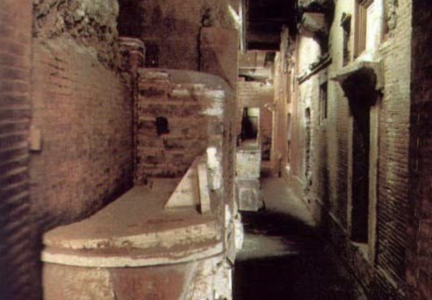
To give you just one example, I was deeply touched by our visit to St Peter’s tomb. This was not the only tomb of the Apostle that we would see, but it was the only one whose history was explained to us in great detail and, as we fought the humidity beneath that fabled basilica, we listened to how Christians kept track of Peter’s tomb for centuries. We heard how it was distinguished from the other graves, how Constantine encased it in marble, how it was eventually buried, and for long after seemed like nothing but an urban myth. Then, in the 20th century, it was discovered and excavated, and now it is possible to see as part of that lost necropolis today. As I saw it for my own eyes, I can remember thinking of how many pilgrims have done the same; I thought of how this was, in many ways, representative of the Church’s apostolic memory; and, of course, I thought of whose bones lay right in front of me, and who he gave them up for.
But amidst these enchanting experiences, aside from awe, I felt something else: I felt grateful, and I felt that way because, one year ago, I would have never imagined the opportunity for such an adventure. Rome was the kind of thing I would only see in films, and it felt very far away. Surely, for any Catholic who studies theology, studying in Rome—for any period—is like a dream come true, and when I saw the opportunity to do just that, I jumped at it. Had it not been for that, I might never have seen those sights in Rome for a few more years at least, if not many more than that, but even then, I’d certainly wouldn’t have had those experiences because I did not go alone. With me, there was a terrific cohort from Regis St Mike’s, and what fond memories we made together!
However, I’m not simply grateful to have had great travel companions. Leaving aside the spectacle for a moment, I also wanted to thank the University of St Michael’s College and the Centro Pro Unione for making it all possible. Additionally, I’d like to thank our President, David Sylvester, and his wife for coming to visit us; our Archbishop, Francis Leo, for the hospitality and kind words he shared with us at the Canadian Pontifical College; the kind funding for the program from donors and, of course, our professor, Mike Attridge, without whom none of this would have been possible.
All of that to say, I fell in love with Rome during my three weeks there, and for anyone doubting whether or not to give experiential learning a go, I’d urge them to put their doubts aside because I promise that you won’t regret it.
Read other InsightOut posts
Rosemary Boissonneau is a climate justice activist and a doctoral candidate at Regis St. Michael’s Faculty of Theology, where she studies ecotheology and scripture. Her research involves applying ecofeminist and decolonial methods to the interpretation of Old Testament texts in order to retrieve an understanding of the land as the mother of earthly life and the medium of God’s blessing. Before embarking on graduate studies, Rosemary enjoyed a long career as an elementary school French teacher.
When I decided to go back to my undergraduate alma mater, St. Michael’s College, to pursue theological studies after decades away from university life, I knew that I would enjoy returning to fondly remembered places from those bygone years, like the Kelly Library and the Coop. However, I never expected that being a St. Mike’s student again would lead me back to Rome, a city I had visited only once before, during the third year of my undergrad studies. Yet, thanks to St. Mike’s commitment to experiential learning and ecumenism, I found myself once again in Rome this past summer as one of eight lucky students participating in the Faculty of Theology’s new course, “Catholic Perspectives on Ecumenical and Interreligious Movements.”
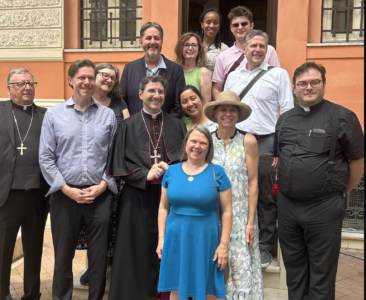
This intensive summer course is the brainchild of Professor Michael Attridge, and it is structured around three weeks of classes in ecumenical and interreligious dialogue at Rome’s Il Centro Pro Unione, an institute dedicated to the study and promotion of ecumenism. The Centro’s annual summer program consists of morning lectures by experts in ecumenism and interfaith relations followed by afternoon excursions to important historical Christian sites like St. Peter’s Basilica, St. John Lateran and St. Paul’s Outside the Walls. Students also visit the Grand Mosque of Rome and the city’s Great Synagogue as well as the Vatican dicastery offices for promoting Christian unity and interreligious dialogue. Aside from the programming provided by the Centro, Professor Attridge arranged many extra outings and experiences for us students in the St. Micheal’s course. Whether it was a tour of the Pontifical Biblical Institute, vespers and supper at the St. Egidio Society, or the Sunday Angelus led by the Pope in St. Peter’s Square, Professor Attridge was always there to guide us with his kindness, knowledge, and inexhaustible energy and enthusiasm.
Another significant perk of the course was that the students’ accommodations in Rome were paid for by a special St. Mike’s fund dedicated to ecumenical studies. This made the course accessible to cash-strapped students like me, but it also helped foster a great sense of community among the students and Professor Attridge as we all stayed at the same hotel atop a hill a short distance from St. Peter’s. We began our days communally with breakfast in the hotel’s restaurant and often capped off our evening by sharing wine and conversation in the hotel courtyard at sunset.
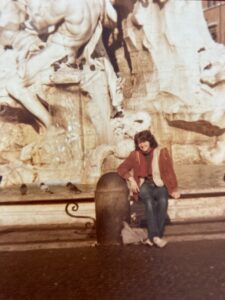
By contrast, my first visit to Rome almost four decades ago was a much less structured affair, but it, too, was very much shaped by my connections to St. Mike’s. Like this summer’s trip, my earlier stay in Rome would not have happened if I had not been a St. Mike’s student involved in experiential learning. With the intention of being a French major in university, I was drawn to do my studies at St. Mike’s because of its highly regarded French department and the possibility of completing my third year in the south of France as part of the University of Toronto’s now-defunct Study Abroad Program. Also, due in no small part to the strong Italian cultural presence at St. Mike’s, I chose to complement my French studies with a minor in Italian. Thus, I found myself in my third year as a St. Mike’s undergrad in Aix-en-Provence, France, near Italy, making plans to test out my Italian by spending the Christmas break in Rome along with another student from my course. My brother, who was doing a doctorate in theology at St. Mike’s at the time, had studied in Rome a couple of years earlier, and he was very excited for me when I wrote him (in an actual posted letter!) about my upcoming trip. This past winter, my brother was equally enthusiastic when I discussed with him the idea of taking the newly announced St. Mike’s Rome course. In fact, I might not have enrolled in the course without his ardent encouragement. “Rosemary, it will change your life!” he said, and he was right. This summer’s course was a life altering event filled with unforgettable moments, just like my undergrad year studying abroad had been.
Among my many memorable experiences in Rome this summer, the one that stands out the most is attending the Pallium Mass celebrated by Pope Francis in St. Peter’s Basilica, during which Archbishop Leo received his pallium as the new archbishop of Toronto. Following the Mass, our St. Mike’s group were guests of the Canadian College at a lovely reception that it hosted in honour of Archbishop Leo, who also happens to be USMC’s Chancellor. Located near the Vatican, the Canadian College serves as a home for Canadian clergy studying in Rome. The Mass and reception were extra-special for me because they mirrored the most memorable part of my first trip to Rome so many years ago. Back then, my ever-protective brother managed from afar to put me in contact with the folks at the Canadian College, where he himself had lived during his studies a few years earlier. The director and students there made us feel very welcomed when my friend and I came knocking on their door a few days before Christmas. They arranged for us to attend Christmas morning Mass at St. Peter’s celebrated by Pope John Paul II, and after Mass we walked over to the College to have Christmas lunch as their invited guests. What an unforgettably wonderful day!
Fast forward from Christmas 1985 to June 2023, and there I was again, a St. Mike’s student attending a Papal Mass at St. Peter’s Basilica and celebrating with a meal afterwards at the Canadian College. But this time, the moments were all the more special because I shared them with so many fellow students and others from the St. Mike’s community, including even my brother, who had come to Rome as part of Archbishop Leo’s contingent. Thanks, St. Mike’s, for the memories, old and new!
Read other InsightOut posts
An innovative new course from Regis St. Michael’s Faculty of Theology will see students travel to Rome this summer to focus on a theological and historical overview of the issues that divide Christians, as well as the bonds that unite them.
Catholic Perspectives on the Ecumenical and Interreligious Movements, taught by Dr. Michael Attridge, will be held at Centro Pro Unione, an institution located in central Rome run by the Friars of the Atonement, an order with a charism devoted to actively promoting Christian unity and the founders of what is now known as the Week of Prayer for Christian Unity.
During the course, which runs Mondays to Fridays from June 26 to July 14, students will engage with experts from the Angelicum (the Pontifical University of St. Thomas Aquinas) and other Roman universities, as well as from the Vatican’s Dicastery for Inter-Religious Dialogue. Participants will stay at Casa Tra Noi, a hotel close to the Vatican that earmarks its profits for charity, including supporting single mothers, those with dependence issues, and the terminally ill. Costs are generously supported by the Driscoll fund, donor money earmarked for the study of ecumenism.
The course includes lectures, seminars, workshops, and excursions. Along with outings to Santa Maria Maggiore and other sites with a key place in Roman Catholic/Christian life, students will also visit the city’s Jewish ghetto and a mosque, as well as meet with a variety of communities, including a visit to Sant’Egidio, a lay community working with the homeless, migrants, refugees, and people with developmental delays.

One of the highlights of the trip will be attending the Mass of Sts. Peter and Paul, also known as the Pallium Mass, on June 29th. Tradition sees pallia, a vestment article worn only by archbishops and the Pope, conferred on new archbishops on this day, so St. Michael’s students will witness Archbishop Francis Leo, Toronto’s new archbishop and the new Chancellor of the University of St. Michael’s College, receive his pallium, and then have a chance to chat with him.
“As Regis-St. Michael’s works to expand its experiential learning opportunities, this is an exciting chance for our students to learn about the ecumenical and interfaith work of the Catholic Church from those working in and associated with the Vatican’s dicasteries,” says Attridge. “I can’t think of a better venue either: the historic Centro Pro Unione – located in the heart of Rome on one of its most famous squares, the Piazza Navona. The Centro played a key role at the time of Vatican II in hosting weekly gatherings of theologians and ecumenical observers who helped shape the final documents of the Council. In every respect, these three weeks should be an unforgettable experience for our students.”
Along with participation in class and weekly roundtable sessions on the key learning of the week, participants will submit written work and contribute to a blog on the course, Rome 2023, with each student responsible for five posts.
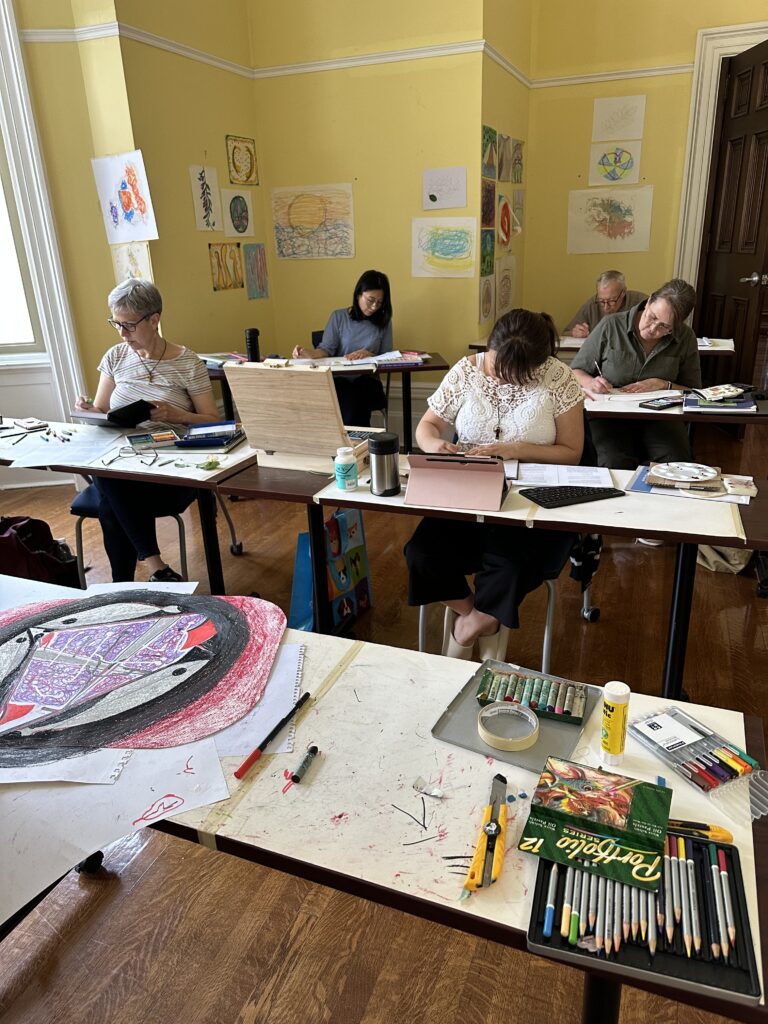
The Catholic Perspectives course is the latest in a long line of experiential courses, classes that involve travel to relevant sites or include hands-on learning. Consider, for example, Prayer and Meditation Through Pencil, Pastel and Ink Sketching, offered at Regis College, which explores the theory and practice of various types of prayer through drawing, or St. Michael’s A Journey Through History – The Jesuit Missions in Early Modern Canada, which is taught at the heart of the former Wendat (Huron) nation (present-day Martyrs’ Shrine.) Another experiential course offered during the summer is Interfaith in the City, which sees students visit various houses of worship to learn more about interfaith dialogue. This course is particularly popular with teachers who are responsible for World Religions course.
While experiential learning courses take place throughout the academic year and are open to all students, the summer courses are particularly helpful to Master of Religious Education students, for whom the condensed scheduling and the inspiration for future lesson planning offer great opportunities and support, says RSM Dean Jaroslav Skira.“Supporting our students is always top of mind for us,” Skira says. “We know people lead busy lives but value a theological education, both personally and professionally. One of our goals, therefore, is to help make our courses accessible to more people while ensuring we are addressing topics that are of interest to our students and serve their personal and professional goals, all while engaging in memorable, inspiring ways.”
To learn more about course offerings – including experiential courses – at Regis St. Michael’s, or to talk about enrolling in one of our programs, please contact erica.figueiredo@utoronto.ca or visit https://theology.stmikes.utoronto.ca/.
Regis St. Michael’s Faculty of Theology members Cynthia Cameron and Hilda Koster have received a “Moving Foward in Mission” grant from the Association of Theological Schools for US$ 25,000.
The “Critical Conversations in Catholic Education: Educating Towards Ecological Resilience in a Climate Justice Curriculum” project aims to foster robust conversation around important theological and social issues facing Catholic educators in ways that empower these educators to think in theologically and pedagogically creative ways. The climate crisis, in particular, impels people of faith to engage the griefs and anxieties of students and teachers as we come together to build communities committed to socio-ecological resilience. As a Faculty of Theology, building conversation about climate anxiety, resilience, and place-based pedagogy enables us to better serve those who teach the next generations of Catholics committed to climate justice.
This grant will fund a series of three events, both in-person and live-streamed, at school board sites around the GTA during the 2023-24 school year with a final half-day conference on the University of St. Michael’s College campus in early summer 2024.
The project is co-directed by Dr. Cynthia Cameron, Patrick and Barbara Keenan Chair of Religious Education and Assistant Professor of Religious Education and Dr. Hilda Koster, Sisters of St. Joseph of Toronto Associate Professor in Ecological Theology and Director of the Elliott Allen Institute for Theology and Ecology, Regis St. Michael’s Faculty of Theology, University of St. Michael’s College.
On first glance, a doctoral student, a university administrator, a lawyer, and a high school teacher might not have a great deal in common on a day-to-day basis. But four alumni who came together recently to talk about life after graduating from the Christianity & Culture program at the University of St. Michael’s College were bound together by their respect for the program, as well as for the people teaching in it, noting that their studies gave them a unique lens through which to view the world.
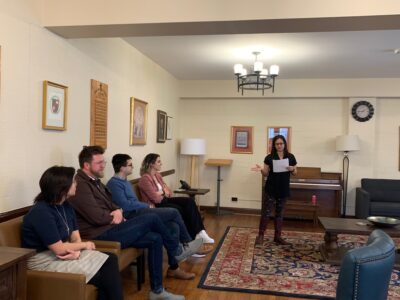
An added dimension to the alumni panel, held in the Basilian Fathers Common Room, was the fact that three of the four participants went on to advanced theological studies, and so attendees were given a great idea of how C & C meshes with further theological studies, as well as what to expect at the graduate level.
Alumna Therese Hassan, for example, credits her time in both the Christianity and Culture program and St. Michael’s Faculty of Theology, where she earned a Master of Theological Studies degree, with helping prepare her more effectively to meet the needs of the secondary students she teaches today.
“Our students yearn for a connection to their faith and not every teacher they encounter has had the experience that I’ve had,” Hassan, who teaches for the Dufferin Peel Catholic School Board.
She describes her time at St. Mike’s as “super valuable,” allowing her students to have a different experience in her class because she is able to speak with confidence about topics such as the teachings of the Catholic Church and sensitive moral issues.
“My theology degree allowed me to grow and build on what I had learned in Christianity & Culture by taking a more in-depth look. And while my C & C classes were small and allowed me to participate, my theology classes were even smaller. I am confident that when my students tell me they have a different experience in my classes it is due to my own academic experience,” Hassan says. “Theology courses were so in-depth that they really allowed me to grow.”
Patrick Nolin, a graduate of the Christianity & Culture program now engaged in doctoral studies at Regis College also cites small classes as helping him become more involved in his classes – an area of study, incidentally, in which he had never intended to become so engaged.
“I didn’t know I’d join C & C because I was into history in high school and that was my planned major but then I took a first-year seminar course on Catholicism and that was it, hook, line, and sinker,” he laughs.
One of the aspects of the program he really appreciated was how its interdisciplinary nature helped create new lines of study, noting, for example, the growth in eco-theology that has taken place since the days he first encountered the subject area in his undergraduate years.
“Christianity & Culture taught me to figure out what questions that need to be asked,” he said, adding he often uses the transferable skills gained in his undergraduate years. Communicating to a small group, for example, has been a help both the past work in sales and his current life as a doctoral student.
Panelist Andrea Nicole Carandang found herself unable to imagine the experience of many of her university peers, who spoke of impersonal classes of 300 students, given the seminar-like size of many of her C & C classes. There, she found the ability to enter into conversations with her professors and her peers, allowing her to gain the confidence to debate respectfully and to tackle life’s most challenging questions.
She recalls, for example, that in 2015 when the Truth and Reconciliation Commission report came out, she was struck by an awareness that, “My faith was big part of the residential school system,” she says.
But she adds, as she delved deeper into the impact of the TRC report she comfort in a lesson she says she had learned again and again as a C & C student.
“It’s not wrong to ask hard questions,” she says.
Carandang, who returned to Toronto to work on a Master of Divinity degree at Regis College, says she often uses the skills and experiences gathered in her student years in many ways in her current role as Administrative Assistant in the office of the President of Regis College, from the practical work of doing research through to brainstorming to resolve numerous challenges that arise.
C & C grad Adam Giancola, who is now a lawyer, says “education is for life,” adding that an interest in canon law from his C & C days, for example, was one of the factors that played into his decision to go to law school.
He deeply values the time taken in his C & C classes to study what the church has proposed about issues over the centuries.
“It’s a program of looking at human issues and I do this every day,” says Giancola, who has worked for Ontario’s Office of the Children’s Lawyer as well as the Office of the Public Guardian and Trustee, offices designed to protect the legal, personal, and financial interests of people who face potential vulnerabilities at the hands of others.
Today, Giancola works in private practice but often engages on matters involving children and other vulnerable clients.
Thanks in part to his Christianity & Culture studies, he says he has learned to “look at people with charity and mercy. I exercise prudence and judgment. Christianity & Culture prepared me for life.”
(Above photo L-R: St. Mike’s alumni: Andrea Carandang, Patrick Nolan, Adam Giancola, Therese Hassan and RSM Theology Recruitment and Enrolment Officer Erica Figueiredo.)
For more information about St. Mike’s Christianity & Culture program, including queries about enrollment and completion, contact smc.programs@utoronto.ca.
For information about Regis St. Michael’s Faculty of Theology programs, email inquiry.usmctheology@utoronto.ca.
Cynthia Cameron, Assistant Professor of Religious Education and the Patrick and Barbara Keenan Chair in Religious Education, has received a US$2500 fellowship grant from the Wabash Center for Teaching and Learning in Theology and Religion in Crawfordsville IN. The grant follows her participation in the 2022 Hybrid Workshop for Early Career Theological School Faculty and supports her continued exploration of liberatory learning in graduate theological education.
Her funded project, entitled “Canadian Indigenous Pedagogies for Theological and Religious Education,” explores best practices informed by Indigenous scholars of critical pedagogy with an eye towards cultivating a stance of ally-ship in the struggle for reconciliation. Her goal in learning about Indigenous pedagogies is not only to incorporate them into her regular practice of teaching at the Regis St. Michael’s Faculty of Theology, but to invite her students to think theologically and pedagogically about their own practices of religious education, faith formation, and pastoral ministry.
Fiona Li is a proud alumna of St. Michael’s Christianity & Culture program as well as of the University of St. Michael’s Faculty of Theology (MTS 2015; ThM 2018). She is now a PhD candidate at Regis College and Associate Director of the Fraser Centre for Practical Theology. Her dissertation seeks to propose an inculturated understanding of Mary for Canadian-born-Chinese Roman Catholic women, such as herself.
In celebration of Women’s Day on March 8, the Regis St. Michael’s Faculty of Theology (RSM) will be hosting a Liturgy of the Word in remembrance of Dr. Ellen Leonard, CSJ. Sr. Ellen was one of the first women to study theology in Canada and taught for many years at the University of St. Michael’s College Faculty of Theology. She taught courses on Roman Catholic Modernism, feminist theology, and ecological Christology. She also founded the Catholic Network for Women’s Equality (CNWE), which continues to work towards “justice and equality for women in the Catholic Church and in the world.”
Along with Sr. Ellen, we also say goodbye and thank you to other female pioneers in theology who walked so we can run: Sr. Margaret Brennan IHM, the first female theology professor at Regis College; Margaret O’Gara; Rosemary Radford Ruether; Delores Williams, Sallie McFague; Mary Daly; and many others.
In remembering the past, we are also given the chance to imagine the future. Since this is the first official year of the RSM federation, it is the perfect time for all those involved—students, staff, faculty, and alumni—to dialogue with one another regarding what they envision the future of RSM to look like.
Like many students, faculty, and staff, my hope for RSM is that it not only survives but thrives; that it becomes a beacon of light and hope for theology. What this means, especially in a city like Toronto, is that RSM will need to speak to the contemporary and systemic issues in society. RSM is situated in a very advantageous position, both within Canada and, more specifically, in the city. Toronto is one of the most culturally diverse cities. With many first- and second-generation Canadians calling Toronto home, RSM is in a privileged position theologically to speak on topics that emerge from the encounters between different cultures and religions with one another. For example, with a great number of Catholics identifying with non-Western cultures and countries of origin, the Western normative systems of thinking about God and theology will need to be renegotiated. And what does it mean to be a Catholic in a multi-religious society such as Toronto? Moreover, as Toronto is home to many persons of colour, RSM is also constantly reminded of intersectionality. RSM can become a leader in decolonizing theology and thinking of theology intersectionally: how does theology written by white males affect persons of colour differently than their white peers? How has the traditional mainstream theology been used to subjugate vulnerable groups of people in society?
To this point, my second hope for RSM is that there will be more women of colour in the student, staff, and faculty populations. By appealing to and preparing women of colour for ministry or further theological studies, RSM will be providing the Toronto Church with competent workers for the harvest. But it is not enough to have women of colour in the student population. It is also important to have representation in the faculty population. Out of all the listed faculty members at the Toronto School of Theology, there are approximately eight women of colour, and only three are regular faculty members. Representation matters because it visually demonstrates to the female students of colour that they belong in academia; that their voices and experiences matter in Theology. As one of the groups that have been historically marginalized due to intersecting systems of power, women of colour have much to contribute to discussions of faith and how Theology can be reclaimed to help and empower people in vulnerable positions.
I think–especially in celebration of International Women’s Day– it is proper to say that the future for RSM is women of colour, along with other marginalized groups, with male and white women’s voices as allies. May we, those who identify as women and in Theology, follow in the legacy of all the women who have come before us, and run, so that those who follow us can walk.
The March 8 Liturgy of the Word takes place at 1:30 in chapel in the Cardinal Flahiff Basilian Centre at 81 St. Joseph St., Toronto.
Read other InsightOut posts
(memo from Regis St. Michael’s Dean Jaroslav Skira)
I am very pleased to announce the appointment of Emil Iruthayathas, as the first Director, Office of the Dean of Theology of the newly federated Regis St. Michael’s Faculty of Theology.
Emil has served in various capacities at USMC in the past 20 years, most centrally for the last 14 years as the Student Services Officer & Registrar for the St. Michael’s Faculty of Theology. He assumes the Director’s role with a wealth of experience in administration in higher education, with a dedication to enriching student experience and an unwavering commitment to advancing the mission of St. Michael’s and, now, the new Regis St. Michael’s federation. I think you all know of his admirable leadership qualities and what a pleasure it is to work with him.
In this inaugural year of the Regis St. Michael’s Faculty of Theology, our student services staff have been envisioning ways in which we can creatively imagine working together as a single academic unit. As the new Director, Emil will help us further advance excellence in the student experience and help us solidify our new federation as a leading centre in Catholic theological education.
The University of St. Michael’s College recently hosted the Canadian launch of the research findings from a key pillar of Pope Francis’s ongoing synodal process, work that offers a voice to those often invisible and unheard in church communities and society.
More than 300 people, including St. Michael’s Chancellor Thomas Cardinal Collins, gathered in person and online on Thursday, November 10 to hear about a report from an international theological research project, Doing Theology From the Existential Peripheries, created and overseen by the Dicastery on Promoting Integral Human Development, Holy See. The aim of the project, which has divided the world into six regions for research purposes, is to deepen the teachings of Pope Francis, as well as to renew theology by listening to those on the margins of society and of the church.
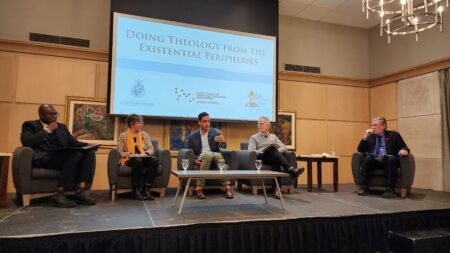
Taking part in the discussion at St. Michael’s were two members of the North American research team: panel lead and St. Michael’s alumnus Fr. Stan Chu Ilo, of Chicago’s De Paul University, and Dr. Darren Dias, OP, a member of St. Michael’s Faculty of Theology and the executive director of the Toronto School of Theology.
Two of the dozens of participants interviewed for the project also sat on the event panel, sharing their experiences: Mary Ellen Chown, a member of the Canadian Network for Women’s Equality (CNWE), and Carl O’Byrne, a coordinator of All Inclusive Ministries
The project began as a response to COVID, seeking input from parishes on the impact the pandemic was having, but Fr. Ilo noted that it was a conversation that couldn’t be had without noting the walls that exist in the church, including those related to gender, sexuality, and socioeconomic stature, and thus the project became a study in creating a depolarizing space, a way to address questions such as racism in the church.
Quoting a participant who was interviewed in Mexico, he said, “The church should never give up on anyone,” adding, “we must embrace the culture of encounter in order to break the walls that are rising in the world today. …Who are those who are not at the table?”
Dias explained the methodology used by the reseach team to the crowd, noting that each of the six teams was to identify the particular ways in which people were marginalized in their part of the world. For the North American team, discussions included meetings with Indigenous people, those in holding centres on the US-Mexico border, people in prisons, member of LGBTQI2S communities, the poor, women excluded from church office, and refugees and migrants, were an exercise in listening to help theologians learn “how we draw people out of their imposed invisibility.”
“What are the questions that arise?” he asked, noting that rather than being akin to “an echo chamber” the process was to hear from those who often don’t have a voice, thus helping to move the church closer to the task of theology, which is to help name grace. Part of the responsibility of a Catholic university, he added, is to listen, including to opposing views, as it is through listening that key insights can be gained in order to shape a theological agenda that is relevant to people’s experience.
Chown referenced the work of the late Dr. Margaret Ellen Leonard, CSJ, USMC professor emerita and co-founder of CNWE, who considered the experiences of women in the Catholic church as a source for doing theology. Chown also spoke to the ways in which the exclusion of women from ministry and leadership in the Church impoverishes the whole church. She said that the members of the CNWE focus group find hope in continuing to advocate for church reform. Through this project, and the Vatican synodal process, they hear Wisdom calling Catholics to a radically new way of ‘being church.’
Quoting Dr. Leonard, she said, “The reality of our lives is fertile ground for theology.”
Speaking of the value of respect, compassion and sensitivity, O’Byrne said that while members of the LGBTQ community would “like to think we are not on the periphery” many see themselves as outliers, even though “we’re here, and we’re going to stay.”
The North American report has now been received by the Vatican. Fr. Ilo noted that when people involved with the project met with him, Pope Francis’s message was simple but direct: “Keep moving forward. All will be well.”
- Final reports from the peripheries project are available online: https://migrants-refugees.va/resource-center/publications.
- The panel discussion is available on YouTube: https://youtu.be/yRA7WeoBv2M
The University of St. Michael’s College is planning for related events in the coming months. Please check our website, stmikes.utoronto.ca, for information about future events.

The University of St. Michael’s College will host a key event in Pope Francis’s Synod on Synodality process with the findings from a North American report commissioned by the Vatican as part of the Doing Theology from the Existential Peripheries project to be presented during a panel discussion on campus.
The panel, moderated by Dr. Mark McGowan, will take place Thursday, November 10 from 7-9 p.m. and will also be made available online.
Dr. Darren Dias, OP, an Associate Professor in St. Michael’s Faculty of Theology who also serves as Executive Director of the Toronto School of Theology, was appointed last December by Rome’s Dicastery on Human Integral Development to join the project’s North American working group, with similar exercises conducted around the world. The eight theologians conducting the research listening to the concerns of those on the margins were led by Stan Chu Ilo, a St. Michael’s alumnus who is a professor of World Christianity, Ecclesiology, and African Studies at Chicago’s De Paul University.
“We have presented our findings in the context of a conversation,” says Dias, who explains that there is an ongoing commitment on the part of the working group–and Pope Francis–to listen to the experience of people, and especially to those who often find themselves without a voice. Each of the six working groups around the world is invited to hold some sort of event to share their initial findings as part of an ongoing conversation/listening process to ensure that the findings are known to the general public.
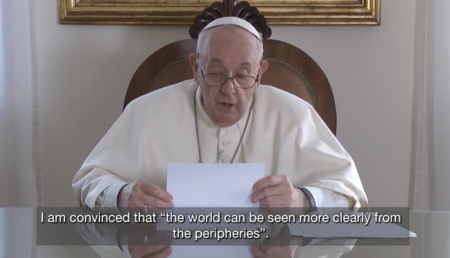
The groups were assigned themes from Pope Francis’s teachings such as migration, ecology, and vulnerability. As the North American report explains, “we take readers into the world of so many people whose voices are not often heard in our churches and society,” with members of the working group visiting prisons, refugee and immigration centres, national borders, convents, holding centres, seniors’ residence, rehabilitation centres, churches and social and pastoral centres, to name a few.
“We are committed to bolstering ways in which theology can support engaging the peripheries,” Dias says. “This is a research project, an academic exercise, and we will report our findings to the bishops, theologians, pastoral workers, and the faithful in service to the Church. This is the business of a Catholic university, to be at the margins. We are committed to bolstering a theology that supports the theological renewal proposed by Pope Francis.”
Pope Francis launched the synodal process in 2021 to help the Church to listen to its constituents and learn from them. The pope has since extended the window during which the synodal process takes place until 2024.
Earlier this year the University of St. Michael’s College Synodal Working Group held seven listening circles for students, staff, and faculty, and conducted 25 one-one-one interviews before submitting a report to Rome on the findings. University President David Sylvester presented a brief summary on the methods used at St. Michael’s to Nathalie Becquart, XMCJ, undersecretary and consultor to the Synod at meetings in Rome in June.
Final reports from the peripheries project are available online: https://migrants-refugees.va/resource-center/publications.
Watch the video for additional context: Wisdom from the Margins
RSVP to attend in person: https://bit.ly/3CIOLEt
RSVP to participate online: https://bit.ly/3yUKKvw
A new partnership with Indspire has created the “University of St. Michael’s College in the University of Toronto” award for Indigenous students.
First Nations, Inuit, and Métis students enrolled at St. Michael’s in undergraduate programs, the Regis-St. Michael’s Faculty of Theology, and the diploma in Social Responsibility & Sustainability are all eligible to apply.
Eight awards of $4,400 each will be granted annually. The funds go directly to the students, to be used for tuition, residence fees, or other expenses.
Applications are made via Indspire, which will oversee the selection and award process.
“We are grateful for the opportunity to partner with Indspire to provide support for our Indigenous students,” says University President David Sylvester. “This is a significant moment for St. Michael’s.”
Indspire is a national Indigenous registered charity that invests in the education of First Nations, Inuit and Métis people for the long term benefit of these individuals, their families and communities, and Canada.
Please see the Indspire website for more information on how to apply for the “University of St. Michael’s College in the University of Toronto” award.
Dr. Cynthia Cameron holds the Keenan Chair of Religious Education and is an Assistant Professor of Religious Education in the Faculty of Theology. Prior to coming to St. Mike’s, she taught undergraduate students at Rivier University and graduate students at Boston College and Loyola University New Orleans. Her research focuses on adolescence, particularly female adolescence, and the history and mission of Catholic schools.
Based on the title of this post, you’d be forgiven for thinking that I am about to offer deep spiritual insights from the matriarchs and patriarchs of the Bible. But I am not. In this case, Levi and Hannah are my dogs. And while they are awfully adorable, they are not, by nature or vocation, spiritual guides. Except that they have taught me a great deal about what it means to try to cultivate a spiritual life.
As do many people, I often find it a bit of a challenge to maintain my spiritual journey in the midst of the busy-ness of modern life. Writing syllabi and planning class sessions; writing for publication; tending to my personal relationships with family and friends; keeping up with the mundane tasks of day-to-day life. And, while attending Mass is a part of my regular schedule, the other aspects of a spiritual life can sometimes fall through the cracks. But, I find that living with dogs is deeply connected to my spiritual life. Lots of other folks have reflected on daily walks (with or without dogs) as a spiritual discipline and others have noted the ways that dogs invite us into the dynamic of spirituality. What I find is that my two dogs teach me two different things about cultivating a spiritual life.
Levi is my nine-year-old, blonde, goldendoodle; I adopted him when he was about a year old. Levi is an easy-going, calm, snuggly dog. He mostly just wants to be where I am. He sits next to me on the sofa when I watch TV, sleeps under my desk when I’m working, and snuggles up on the bed at night. He is predictable: he pees and poops at the same times every day; he loves meeting new people; he hates thunderstorms. And Levi is gentle; when he wants a pat, he lays his head in your lap.

Levi reminds me of the times when the spiritual life is relatively easy. When prayer comes easily and regularly and when things are predictable. Levi is the mascot of a spiritual life that is both uncomplicated and full of the rich experiences of love. It is a spiritual life that brings warmth and comfort to my life. It is a spiritual journey that reminds me of God’s love for me and that is full of joy in healthy relationships, satisfaction in my work, and a focus on the day-to-day-ness of life.
Hannah is my standard poodle; she is five years old and I have had her since she was a small puppy. Hannah is a princess. All of those stereotypes about poodles being divas are embodied in this dog. On the one hand, she is bouncy and energetic and silly; she loves to run and play and she always has an eye peeled for squirrels. On the other hand, she is weird and high-maintenance. Yesterday, she would only pee on the sidewalk; today, she will only pee on the grass. She doesn’t like her feet to get wet (except for when she wants to play in a puddle) and every day is like the first day she’s ever had to wear a leash. Hannah likes meeting new people, but, when she is done with being adored, she walks away.
Hannah reminds me of the times when cultivating a spiritual life feels slippery or hard to catch hold of. When the regular practices don’t work, when no one seems to be listening to my prayers, when things seem bouncy and a tiny bit out of control. Hannah teaches me that the spiritual life isn’t always easy and snuggly and predictable; that sometimes I need patience to find that thread between me and God. She reminds me to try new things and to walk away from practices that don’t work. She also reminds me that a practice that doesn’t seem productive today might be productive tomorrow. She is calls me to be more patient, kind, and self-controlled. These are the virtues that I need when Hannah’s diva-ness plucks at my nerves or when my spiritual life seems disjointed and unproductive.
And both dogs together teach me – on a daily basis – that the spiritual life is never all one thing. It is never all comfort and warmth and rainbows; it is also never all challenge and frustration. It is both. And, like walking these two dogs together, the spiritual journey is sometimes comfort and frustration at the same time. I never thought I could learn so much about myself and about my spiritual journey from two silly and delightful dogs.
Read other InsightOut posts.
Systematic theologian Sr. Ellen Leonard, CSJ, is being remembered by the St. Michael’s community as a groundbreaking theologian of “irrepressible joy” who cared deeply for the Church, her students, the role of women, and her religious community.
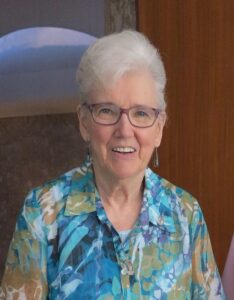
Sr. Ellen died Thursday, August 18 at the age of 88, in her 71st year of religious life. Entering the Sisters of St. Joseph at the age of 17, she taught elementary school for many years before becoming one of the first women in Canada to study theology, earning her doctorate from St. Michael’s Faculty of Theology in 1978. Having served as a lecturer during the last year of her doctoral studies, Sr. Ellen became an assistant professor in 1978, an associate professor in 1982, and a full professor in 1991. She would remain a fulltime member of the Faculty of Theology until her retirement in 1999, at which time she became an emerita professor.
Her teaching and research focused on Roman Catholic modernism, and feminist and ecological Christologies. Her many publications include three books focusing on the modernist movement of the early 20th century: George Tyrrell and the Catholic Tradition; Unresting Transformation: The Theology and Spirituality of Maude Petre; and Creative Tension: The Spiritual Legacy of Friedrich von Hugel.
“Sr. Ellen Leonard was a great woman in many ways–in her teaching and leadership at the Faculty of Theology, and in her advocacy for greater inclusivity of women in the Church,” says Regis-St. Michael’s Dean Jaroslav Skira. “She was also a deeply kind person and I feel very privileged to have known her.”
Former student Mary Ellen Chown, who has written a chapter on Sr. Ellen in the work Claiming Notability for Women Activists in Religion, says, “I had the privilege of being a student in Ellen’s course on ‘Feminist Approaches to Systematic Theology’ in the fall of 2000. What stays with me is Ellen’s deep respect for each of her students and her enthusiasm in sharing the rich diversity of global voices in feminist theology. Ellen’s teaching methodology encouraged us to reflect on our own life experience as a source of theology while integrating an academically rigorous feminist critique into our understanding.”
Sr. Ellen’s colleague, eco-theologian Dr. Dennis O’Hara, wrote the citation when the University of St. Michael’s College awarded her an Honorary Doctorate of Sacred Letters in 2014.
“For me, Ellen was an outstanding and compassionate educator, a skillful and kind mentor, a thoughtful and experienced colleague, and a dear and valued friend,” O’Hara recalls. “She was an extraordinary positive influence in so many lives.”
Former University president Dr. Anne Anderson, CSJ, says it was “a pleasure and a privilege” while serving as the Faculty of Theology’s Dean to have Leonard as a member of the Faculty.
“Ellen coupled her studies in Modernism with the teachings of Vatican Two and began to write and publish in the area of ‘Experience as a Source for Theology.’ The injunction of Vatican Two to “read the signs of the times” supported her life-long interest in the development of feminist theology as well as the scholarship of those who were writing and researching in this area,” Sr. Anne says. “Ellen also viewed ecological issues as one of the signs of the times that required careful attention. As a colleague, Ellen was an unfailingly generous supporter of the Faculty of Theology and its mission. Her many students received her full attention and support as well as the benefit of her continued scholarship.”
Sr. Ellen’s efforts will continue to inspire those who knew her and her work, says Chown.
“Ellen’s prophetic wisdom abides in her significant body of work, in her ongoing inspiration in the lives of her students and in the work of the Catholic Network for Women’s Equality (CNWE), which she founded in 1981, and for which she remained a lifelong mentor and supporter,” she says. “I will remember Ellen as a woman of transforming faith and grace who embodied hope for a renewing, inclusive Catholic Church, for justice in the world and for the flourishing of all creation – a woman who engaged this sacred work with integrity and an irrepressible joy.”
In lieu of flowers, donations may be made to Fontbonne Ministries and you can click here for more information.
The Toronto School of Theology (TST) is pleased to announce the appointment of Rev. Dr. Darren Dias, O.P. as the new Executive Director of TST. A long-time member of the University of St. Michael’s College community where he has served in its Faculty of Theology since 2008, Dr. Dias will assume his duties as Executive Director on September 1, 2022, while continuing his research and teaching as an Associate Professor of Systematic Theology in the newly formed Regis St. Michael’s Faculty of Theology.
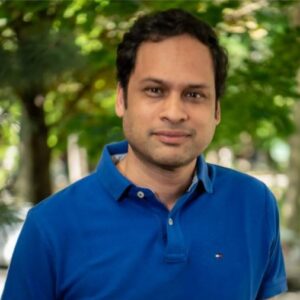
“Dr. Dias is a firm believer in the ecumenical mandate of the Toronto School of Theology and will offer strong leadership to our unique consortium of theologates,” says Rev. Dr. George Smith, CSB, who is Chair of TST’s Board of Trustees. “The board was unanimous in its decision and I am pleased to welcome him to TST.”
The first Faculty member from St. Michael’s to hold the position, Dr. Dias’s appointment to TST comes just as the theological faculties of USMC and Regis College are brought together, an exciting new venture in TST’s 52-year history, notes Regis St. Michael’s Dean, Jaroslav Skira.
“This is a positive development for all,” says Skira.
Dr. Dias earned his doctorate under the supervision of Prof. Robert M. Doran, S.J., where he received the Governor General’s Gold Medal for Academic Excellence. Dr. Dias’ current research and publications revolve around interreligious dialogue, relations and decoloniality.
Currently the President of the Canadian Theological Society, he is also now working on a project with Dr. Stephan Van Erp, funded by a Templeton Foundation grant, entitled Metaphysics of Contemplation: Religious Life and Form of Thought.
As a member of St. Michael’s Faculty, Dr. Dias took on numerous administrative roles. At TST, he has served on the Basic Degree Council and the Graduate Studies Council. He also serves on the University of Toronto Faculty Association’s Gender and Equity Committee. In addition, Dr. Dias serves in various ecclesial leadership roles and committees, nationally and internationally.
Dias succeeds Dr. Pamela Couture, the Jane and Geoffrey Martin Chair in Church and Community at Emmanuel College, who assumed the role of TST’s Executive Director in 2020. Among her leadership accomplishments, Dr. Couture led the TST members through the rigorous UTQAP review process during her tenure.
“I would like to extend my sincere thanks to Dr. Pamela Couture, who served TST so well during the extraordinary circumstances created by the COVID-19 pandemic,” says Dr. Smith. “We are grateful for all she has brought to the position.”
The Toronto School of Theology, founded in 1970, is a consortium of seven theological schools, each accredited by the Association of Theological Schools in the United States and Canada. Academic standards are consistent with those of the University of Toronto, which is regularly ranked among the top 25 research universities in the world.
TST’s seven member colleges are: Emmanuel College (United Church of Canada), Knox College (Presbyterian Church in Canada), Regis College (Roman Catholic: Jesuit), St. Augustine’s Seminary (Roman Catholic: Diocesan), University of St. Michael’s College, Faculty of Theology (Roman Catholic: Basilian), University of Trinity College, Faculty of Divinity (Anglican), and Wycliffe College (Anglican, Evangelical).
In addition, TST has connections with three affiliated member institutions: Conrad Grebel University College (Mennonite) at the University of Waterloo, the Institute of Christian Studies (Christian Reformed) in Toronto, and NAIITS: An Indigenous Learning Community, based from Prince Edward Island.
The TST consortium offers a full range of professional and academic degrees. Some are primarily professional while others are oriented to general theological studies or research. All degree programs operate at the post-baccalaureate level, and a number of degrees are conferred conjointly by the University of Toronto.
For the Metropolitan Andrey Sheptytsky Institute of Eastern Christian Studies, (MASI), July saw the return of its renowned Study Days program after a four-year hiatus, as well the arrival of two top Patristics scholars to lead a week-long seminar for doctoral students that drew participants from Canada, the United States and Europe. Rounding out this summer’s offerings at MASI was an intensive course in Byzantine Eucharistic Liturgies. Through these various offerings, each addressed to a unique audience, the Institute continues to address the needs of the church, the academy, and those who simply want to learn more about their faith.
Leading the Patristics seminar were MASI’s two keynote speakers for their summer offerings, Fr. John Behr, PhD, who is the Regius Professor of Humanity at the University of Aberdeen, and Dr. Lewis Ayres, who is Professor of Catholic and Historical Theology at Durham University. Fr. Behr’s speech was entitled Reason Persuading Necessity: Gregory of Nyssa on the Human Being, while Dr. Ayres’ was entitled Justinian’s Vision of Christ: Necessary for Orthodoxy Today?”
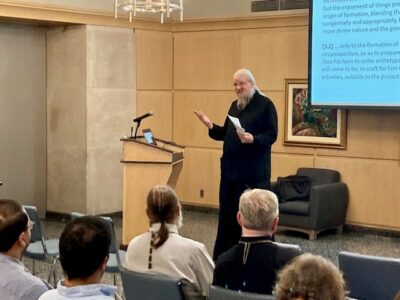
The ongoing interest in, and engagement with, the Church Fathers is a good sign for the church, says Fr. Behr, who notes that only by understanding the origins and development of church thought can we begin to understand today’s challenges and respond effectively.
Dr. Ayres agrees, noting that beyond the subject-specific insights into church history and thought gained through reading great minds of the early church, there is also a broader appeal across the humanities, and that comes from delving into how arguments are developed and presenting. Exposure to great thought benefits all readers, he says.
But for students, one of the greatest benefits of attending the Patristics Seminar was the opportunity to watch two long-time colleagues engage in a discussion, often – but not always – agreeing, and modeling for the doctoral students respectful, productive academic discourse.
“Prof. Fr. Behr and Prof. Ayres certainly modelled rigorous conversation. What touched me most is that this conversation clearly flowed, for each instructor, from years of dedicated scholarship pursued in faith,” says seminar participant Emily Barnum, a doctoral student from the University of Chicago, where she is studying New Testament and Early Christian Literature. “Nothing animates our study of these great texts more than approaching them from within a life of prayer. It was a great gift to study together during the day and pray together in the evening.”
The decision to offer a seminar led by two academics is one of the ways MASI serves the community, Fr. Behr and Dr. Ayres agree.
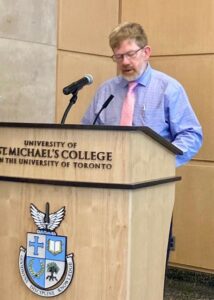
“Thirty years ago, when I was starting out, Toronto was one of the great places to study theology,” says Dr. Ayres, noting the city remains a strong draw for theological studies. Having two academics teaching together presented a unique chance to view issues in a variety of ways.
Fr. Behr also offered praise for MASI for inviting both academics to lead the workshop, noting that it gave participants a chance to see how questions – and answers – are formulated. Overall, he adds, the week gave students both firm information in a key subject area as well as the opportunity to ponder academic approaches to the classroom, a vital consideration for those who will become professors.
MASI was born out of an intensive summer program from its early days at Chicago Theological Union, when founder Fr. Andriy Chirovsky began a program of study at California’s Mt. Tabor Monastery.
Co-sponsored by St. Augustine Seminary, MASI’s Study Days program provides “an immersive experience in Eastern Christianity, both in its rhythm of prayer and in patterns of thought,” says the Institute’s Fr. Andrew Summerson, PhD, who helped organize this year’s classes. “Through Study Days, we bring the best of our tradition to the wider church. After a four-year hiatus, re-starting study days returns us to our original charism and is a good sign that post-COVID we are beginning to operate at full capacity in our service to the church and to the academy.”
The Metropolitan Andrey Sheptytsky Institute of Eastern Christian Studies is a centre of higher learning, research, ecumenical understanding, and prayer. It operates as an autonomous academic unit in the Faculty of Theology at the University of St. Michael’s College (USMC) in the University of Toronto. Based in Windle House at the heart of the USMC campus, the Institute specializes in the theology, spirituality, liturgy, history, and ecclesial polity of the Eastern Christian Churches, both Orthodox and Catholic.
The summer offerings at MASI were conducted in partnership with Pontifical Institute of Mediaeval Studies, the Centre for Medieval Studies, the Orthodox School of Theology at Trinity College, and the Lumen Christi Institute at the University of Chicago.
As spring settled in we eagerly joined in lots of activities in April and May, especially enjoying the return of in-person events!
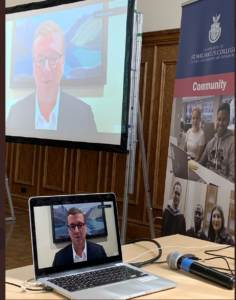
This year’s reunion was particularly special as it was the first in-person reunion since 2019. Hundreds of alumni joined us online and in person to learn from faculty lectures, reconnect with classmates, make new friends and celebrate milestone graduation anniversaries together. Highlights include Mississauga Mayor Bonnie Crombie’s keynote speech at the Annual General Meeting, a Young Alumni Pub Quiz held in Yorkville, fascinating faculty lectures by Dr. Michael O’Connor, Dr. Alison More and Dr. Cynthia Cameron, the Double Blue All-Alumni Party and two wonderful brunches – one to celebrate the 50th graduation anniversary of the Class of 1972, and one to honour this year’s Alway Award winner, Barry McInerney (SMC 8T5), for his contributions at St. Mike’s and beyond. We’re already looking forward to next year’s Reunion!
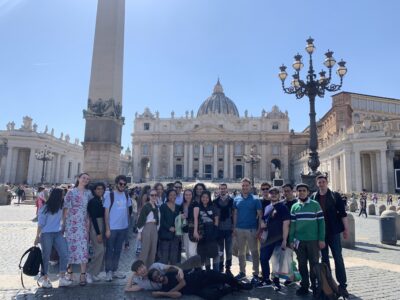
Our incredibly popular 1st-year Gilson Seminar in Faith and Ideas finally made it to Rome for the pinnacle of the program. Piggybacking groups that missed the trip because of the pandemic allowed all students to have a chance to make the tri. Their stay in the Eternal City included a visit to the Vatican, as well as the Vatican Observatory, as well as numerous day trips and lectures. No doubt a great time was had by all.
Spring saw a great group of doctoral candidates in the Faculty of Theology offer successful thesis defences. Congratulations to Shannon Wylie, Aleksander Krogevoll, and Somyong Lee.
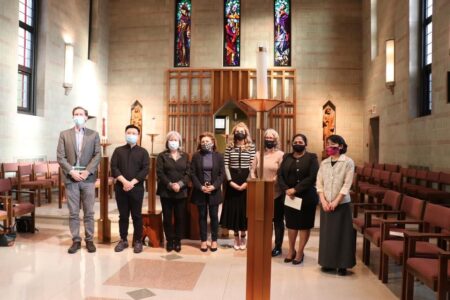
The Faculty of Theology held its annual commissioning Mass, a beautiful tradition that sees the community come together to pray for graduates as they head out into the world to minister in a variety of ways.
Congratulations to librarian Silvia Vong. One of her recent articles on information literacy was rated among the top 20 instruction article of the past year by the American Library Association (ALA) Library Instruction Round Table (LIRT).
A book shifting project on the 2nd floor is now finished. Spearheaded by librarian Remi Pulwer, the floor’s entire collection was shifted over 12 months of work to create space for new books and titles from our print reference collection.
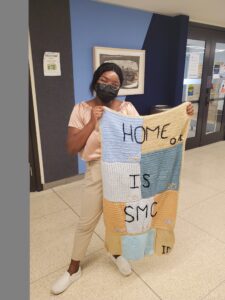
To paraphrase Shakespeare, in spring, a young student’s heart turns to …. sports! Construction began on St. Mike’s Athletic Field thanks to the initiative of the St. Michael’s College Student Union (SMCSU), who have funded the project, which includes new fencing, grass, and picnic benches for students to enjoy the outdoor space in our #Oasisinthecity.
Meanwhile, the SMC Crochet club completed their blanket tapestry to celebrate the community here at St. Michael’s!
And of course, while spring always leaves us guessing, it arrived in all its splendor on campus, each year a little more beautiful than the one before. There’s a reasons St. Mike’s is known as the #Oasisinthecity!
Dr. Jaroslav Skira, a seasoned academic with extensive administrative experience, has been appointed inaugural Dean of the new Regis-St. Michael’s Faculty of Theology.
Dr. Skira, whose research interests and expertise include modern Eastern Christian theology, Catholic and Eastern Orthodox ecumenical relations and the Second Vatican Council, has been appointed for a five-year term. He assumes his duties on July 1, 2022, when the federation is formally launched.
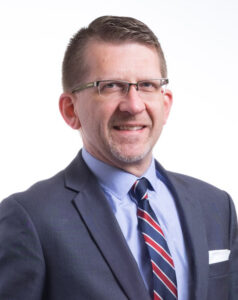
Currently a member of the Regis College Faculty, he has also taught at St. Michael’s, including in the undergraduate Christianity and Culture program, the Metropolitan Andrey Sheptytsky Institute of Eastern Christian Studies (MASI), and the L’viv Theological Academy, precursor to today’s Ukrainian Catholic University, Ukraine.
From 2011 to 2018 he also served as the Founding Director of the Graduate Centre for Theological Studies at the Toronto School of Theology, the ecumenical federation of Christian theological schools to which both St. Michael’s Faculty of Theology and Regis College belong.
“I am really delighted to be part of this new chapter in the life of both Regis and St. Michael’s, of further advancing the close collaboration that has been going on for years between these two leading Catholic academic institutions,” says Dr. Skira. “I have great confidence that the new federation will more fruitfully contribute to the theological academy, and that it will enhance student experience and excellence in the various vocations and ministries that our students pursue in the church and in the world.”
Dr. Skira, who served as interim director of MASI in 2018, will both teach at and supervise some of the institute’s Advanced Degree students.
His appointment comes following a “strong recommendation from the search committee,” says St. Michael’s President David Sylvester. “The committee was particularly struck by Dr. Skira’s administrative experience and felt he will offer strong leadership as Regis-St. Michael’s is launched. I am delighted to be working with him as we begin this exciting new era.”
Regis President Thomas Worcester, SJ, agrees.
“The search committee that sought the right person to serve as the inaugural dean of the Regis-St. Michael’s federation merits gratitude for its astute choice,” says Dr. Worcester. “These are exciting times for Regis and St. Michael’s. With Professor Skira as its dean, our federation can now move ahead in achieving its goals.”
A Memorandum of Agreement was signed in October, 2021 which provides for the federation of Regis College and the University of St. Michael’s College for the purpose of “forging a world-class centre of excellence in Catholic theological study, whose mission is to promote teaching, research and formation to serve the needs of the Church and society, in Canada and globally.”
Catherine Mulroney (SMC 8T2, USMC 1T0) is a big fan of her alma mater — so much so that now she works at St. Mike’s.
I remember watching my mother (Barbara Hood SMC 4T5) getting ready for her 25th reunion and thinking, “I’ll never be that old.”
Today, I am staring down my 40th and wondering, needless to say, where the time has gone.
My mother (who, for the record, would want me to add that she was just 19 when she graduated) loved her time at St. Mike’s. She remained amazed that her own mother lasted just one day here before transferring to University College. Being a woman in university during the 1920s would be challenging enough, my grandmother felt. As a French Canadian woman, she felt a non-Catholic college might help her get ahead in a still very Anglo Toronto. And so she picked up and crossed Queen’s Park, a move, my mother felt, that was her loss.
My mother’s memories recalled a very different place than the St. Mike’s I experienced. In her Latin class, for example, the seminarians sat apart on one side of the classroom, while the other students – and particularly the female ones – sat across the room. Most of the students with whom my mother interacted were also Catholic, and St. Mike’s was small enough that almost everybody knew each other.
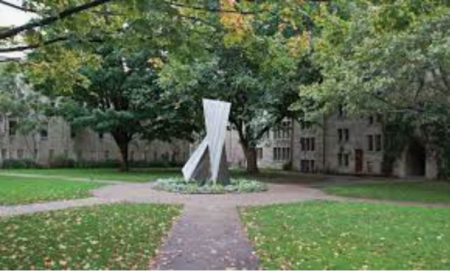
By the time I arrived in 1978, the world had greatly changed. Vatican II had shaken up the Church, so the communion rail in St. Basil’s Church where my mother had knelt was long gone. The increasing options open to women meant that the Sisters who were the first women to teach at St. Mike’s were increasingly joined by lay female colleagues. And when the boy I had a crush on in Fr. Leland’s 1st-year Major British Writers class made a move to brush ashes off my forehead I realized that, unlike my mother’s St. Mike’s, my classmates were not all Catholic.
My St. Mike’s was increasingly engaged with the outside world. I recall an all-candidates’ meeting in Brennan Lounge that included candidate George Hislop, a high-profile gay activist, in an era when broader acceptance of the LGBTQ community was still in its infancy. Campus Minister Sr. Diane Bridges, IBVM, always had something topical on display outside her office at the north end of Brennan Hall, whether it was instructions on how to write letters of support to the Mothers of the Disappeared in Argentina or on the ongoing struggles of the California grape pickers.
I was taught by many of the greats, including Fr. Madden, Msgr. Synan, and Dr. Colin Chase, who had a particular influence on me, offering suggestions when I was in fourth year about a career in journalism, a world away from Old English and Chaucer. His mother, he told me, had been a journalist. Modest to a fault, what he didn’t tell me was that his mother was Mary Coyle Chase, author of the play Harvey, which had been made into a wildly successful film with Jimmy Stewart.
Fr. John Kelly, by then retired, was still a force on campus. In yet another of university’s life lessons, I watched the man whose homilies had terrified me as a child because of his fiery oratory skills now socializing with students, sometimes playing pool or having a beer, and realized there was so much more to the man.
I recall a Christmas wine and cheese party my first year during which a very elegantly dressed man began to chat with me.
“And what do you do at the university?” I asked, with a naivete I’ve never really shaken. “Oh, I’m Fr. Swan,” he replied, and when that didn’t register, he added “the new president….” I remain chagrined to this day.
The St. Mike’s connection has carried forward into my post-graduation life. For example, when my husband and I first needed an accountant, a neighbour passed on a name. When I walked into Roger’s office, I realized I used to see him almost daily in the old Brennan Hall lounge. My first thought was that if we’d been in school together, he couldn’t be old enough to do my taxes, followed by the realization that, if I were old enough to have my taxes done, he was old enough to do them.
The St. Mike’s I returned to in 2004 to work on a Master of Divinity degree was different again. If I recall correctly, the Faculty of Theology, once a male bastion, now had more women enrolled than men. You could now eat in the Kelly Library and the statue of St. Michael in the quad had a feeling of permanence, having long since shaken the mantle of being the shiny new thing on campus.
Today, I am lucky enough to work at St. Mike’s and witness first-hand the ongoing engagement of students, faculty and staff with important issues. Working in the communications department, I have had the privilege of talking to young adults, for example, about projects promoting sustainability, the need to fight anti-Asian racism and the happiness of Muslim students upon discovering that the Canada Room was making special dietary schedules and meals for Ramadan. When chatting with professors, the topic may be new classes on everything from Indigenous issues to the cultural impact of video gaming or the importance of St. Mike’s first-year check-in program to ensure students are feeling comfortable.
In other words, the St. Mike’s that you and I knew is still all that – and more. Great students, fabulous professors and a lively vibe.
I won’t be able to attend reunion as I am off to attend my daughter’s convocation but I’ll be thinking of my former classmates, wondering, for example, whether the guy who used to look just like Sting still does. I’d love to know whether the person so offended by the song Jet Boy, Jet Girl that he used a nail file to scratch the copy played at pub nights will attend – or whether the person savvy enough to replace the record with the French version will show up either.
Like my mother, I loved my St. Mike’s days. These days, each time I set foot on campus I feel re-energized. Here’s hoping my classmates have a great time and that the years fade away. Miss you, Class of 8T2. Already wishing I were there.
Learn more about Alumni Reunion 2022 and register for events online.
Read other InsightOut posts.
Each year, the Faculty of Theology marks the end of the winter semester with the Commissioning Mass, during which prayers are offered for all graduating students as they head out into the world to share what they have learned.
This year, Myungsook Kim, who will graduate with a Master of Theological Studies degree, offered a reflection. For the past 20 years, she has been teaching students with special needs in Catholic schools. Myungsook is a mother of two, and advocate for people who are physically and intellectually challenged, and an associate in the Felician Sisters Congregation. A former visual arts instructor at Gangneung-Wonju National University in South Korea, Myungsook immigrated to Canada at the age of 32.
Thank you, Student Life Committee, for allowing me to speak on behalf of graduates, even though I am far from the mainstream.
I have studied in the MTS program on a part-time basis for the last six years. I mostly took night classes because I have a full-time job during the day. Some people asked me why I was working myself this hard day and night. But for me, being a student at St. Michael’s was filled with joyful moments. Let me briefly tell you why.
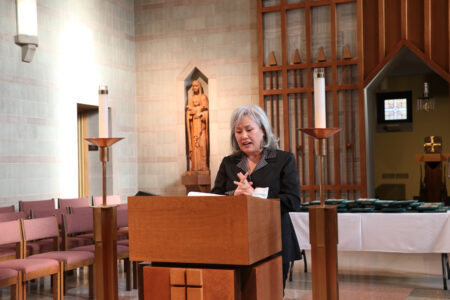
First, the snacks! Previous SLC president Josefine prepared snacks for night students. After a long day at work, I drove down to class from Mississauga in the middle of rush hour. The joy of sharing snacks among classmates before the class in the lounge made me feel full of love. Thank you, Josefine, and the whole SLC for your love and leadership.
Second, “Aha” moments. Every lecture, every reading has cultivated me to transform. Sometimes, my brain froze with new and true information. Thank you, all professors and librarians, for being for us real-life models of disciples walking in the company of Christ on the road to Emmaus. You all have shepherd the “Aha” moments with love and care.
Third, transforming into an angel. My ministry practicum at the Felician Sisters’ house was special. It is home to 21 retired sisters enjoying their remaining lives while waiting for God’s calling to be with Him. They called me an angel for helping them with their basic physical hygiene needs. Sometimes, I simply hold their hands while they are passing. I felt I was walking in the company of Christ as well, like a blessed angel.
Lastly, overcoming obstacles together. The pandemic arrived and we all had to rely on the Internet. The special COVID funding arranged by St. Michael’s to help with pandemic expenses has provided us not only financial support but also the love of being cared for. Together, we all successfully thrived through our own unique way.
Thus, on behalf of the Faculty of Theology BD graduates of 2022, I thank the entire community of St. Michael’s for guiding us, for walking with us in the company of Christ, and for helping each of us to share our unique gifts.
Upon completing our degree, regardless of what our future holds, let us be sure to use our unique gifts that have transformed us here at St. Michael’s Faculty of Theology. May we share God’s compassion, truth and love as we continue to walk in the company of Christ.
Read other InsightOut posts.
Rosemary Boissonneau is a climate justice activist and a doctoral student at St. Michael’s Faculty of Theology, where she studies ecotheology and scripture. Her research involves applying ecofeminist and decolonial methods to the interpretation of Old Testament texts in order to retrieve an understanding of the land as an active participant in the covenant with God and the people of Israel. Before embarking on graduate studies, Rosemary enjoyed a long career as an elementary school French teacher.
This Friday, April 22 marks Earth Day, an event that has grown into global prominence since its first iteration 52 ago during the heady days of the U.S. college protest movement. Now recognized as the largest secular observance in the world, Earth Day is commemorated by over a billion people each year as a day of action centred on our planet’s well-being and its protection from human-induced degradation and destruction. Residents in over 190 countries use this day to raise awareness about pressing environmental challenges and demand the individual behavioural changes and the multi-level policy changes that are needed to stop the damage we are unleashing on the Earth.

Occurring during spring and the Easter season, Earth Day ought to be a celebration of renewal and hope but, increasingly, it is an occasion for lamentation, despair and desperation as year after year the cries of environmentalists and the Earth itself seem to go unheeded, and the devastation of the planet continues at an ever more rapid pace. The interrelated crises of biodiversity loss, ecosystem collapse and climate change pose an unprecedented threat to the health of the planet. Referring to the most recent report of the International Panel on Climate Change (IPCC) released earlier this month, the UN Secretary-General, António Guterres, warns that without drastic reductions in global greenhouse gas emissions in the next few years, we are “firmly on track to an unlivable world” thanks mainly to “a litany of broken climate promises” by governments and corporations still banking on the fossil fuel economy and blocking efforts to enact a just transition to a decarbonized future.
And yet … despair need not have the final word. There is still reason for hope on this Earth Day. The same IPCC report details how, if the global community takes immediate and significant action using existing technology and methods, it can still keep the Earth within the 1.5C degrees of warming as pledged in the 2015 Paris Accord and avoid the worst of the impending climate catastrophe. For an overview of the many initiatives and behavioural changes that we must undertake or ramp up to achieve net zero emissions, take a look at the list of the climate solutions and their many social co-benefits outlined by Project Drawdown at https://drawdown.org/ . As you will see, these solutions respond to both the cry of the Earth and the cry of the poor.
The future can be bright, healthy and equitable! Alleluia! However, none of these positive paths forward can take effect until we humans first experience what Pope Francis’ encyclical Laudato Si’ calls an “ecological conversion.” This is especially true for those of us living in the so-called developed global North, where our normative worldview understands humanity to be separate from and superior to the rest of creation. If we remain stuck in this anthropocentric mindset, even our most noble efforts to “save the planet” this Earth Day will lead to failure. Because the truth is we humans cannot single-handedly save the planet even though we are in the process of single-handedly destroying it.
The Earth is not a damsel in distress waiting for us humans to save it. The Earth is the regenerative, creative, living masterpiece of God’s creation, which has been creating, regenerating and regulating the dizzyingly diverse array of life in its biosphere for many millions of years, since long before humans emerged as one of the most recent members of God’s community of creation. As Laudato Si’ reminds us, “Rather than a problem to be solved, the world is a joyful mystery to be contemplated with gladness and praise.” If we enter mindfully into the mystery of creation, the living embodiment of God’s love, we humans can learn how to collaborate with the Earth and its regenerative powers, how to live and indeed thrive within its means, so that we can unlearn and cease the destructive activities and attitudes that are preventing the Earth from saving itself, and saving us humans along with it.
Fortunately, none of this is new. Before modernity and before we developed our unquenchable thirst for empire-building, we humans more or less knew how to live in right relationship with the rest of the community of creation. And Indigenous peoples continue to live out the knowledge and wisdom intrinsic to such relational ways of being despite the genocidal brutality of colonialism past and present. In fact, as a hopeful sign of our growing recognition of this reality, the latest IPCC report for the first time ever listed colonialism as a historical and ongoing driver of climate change, suggesting that the paths of decolonization and decarbonization are united. This view is echoed in the final document from the Synod on the Amazon released in 2019. It recognizes that being attentive to the cry of the Earth and the cry of the poor, especially the Indigenous peoples of the Amazon, calls us to “a personal and communal conversion which commits us to relate harmoniously with God’s work of creation.” It also acknowledges that this conversion involves honouring “the pattern of thinking of indigenous peoples [that] offers an integrated vision of reality, capable of understanding the multiple connections existing throughout creation.”
On this Earth Day we must not remain blind to the grave threats that imperil our planetary home, but neither should we disregard that the Earth itself is humanity’s formidable and wonderous ally on our path of conversion toward ecological and social healing. I will conclude with advice from Laudato Si’. On this Earth Day, “let us sing as we go. May our struggles and our concern for this planet never take away the joy of our hope.” To learn more about Laudato Si’ and St. Michael’s ecotheology offerings, please visit the Elliott Allen Institute for Theology and Ecology.
Read other InsightOut posts.
This is the night when Christ broke the prison-bars of death and rose victorious
Theodore Nnorom is a member of the Congregation of the Sons of Mary, Mother of Mercy (SMMM), and a Ph.D. student in the Faculty of Theology at the University of St. Michael’s College. His research is in the area of interreligious dialogue, inspired by his desire for a constructive theological approach toward peaceful coexistence between Christians and Muslims in Nigeria. He is the secretary to the Hindu-Roman Catholic Dialogue, an interreligious department of the Canadian Conference of Catholic Bishops (CCCB).
At the end of the Lenten season, we are ready for the Easter festivities. This year’s Easter celebration evokes deep gratitude to God following the third year of unprecedented global health and socio-economic devastation caused by the Covid-19 pandemic. The cautious relaxing of Covid-19 restrictions in Canada signals a possible decline or control of the spread of the virus. In Toronto, in-person classes have resumed in schools and colleges, worshiping spaces are open to maximum capacity, and restaurants are back to in-door dining. It is a delight to witness Toronto roar back to its usual hustle and bustle.
Human interconnectivity and communion stand out when assessing lessons gained from the Covid-19 experience. Every part of the global community had its fair share of the impact of the Covid-19 pandemic, blurring the divides among the so-called first, second, and third worlds. Particularly surprising, despite the low rate of vaccination in most African countries and the unfortunate prediction of doom, the reverse has been the case regarding the spread of the virus in the continent compared to most Western nations. Most African countries are regrettably suffering instead from “hunger-pandemic” as the indirect impact of the situation.
Nonetheless, no need to gaze far beyond the Atlantics; studies have revealed disproportionate Covid-19 infection among the immigrants, poor, and racialized communities within the core of major North American cities. This is due to some socio-economic conditions such as living in densely populated neighborhoods with multiple households in small living spaces, doing essential work like healthcare support services and food services, lacking the luxury to work from home or have groceries delivered, and depending on public transportation. The federal government’s Covid-19 emergency grants helped address some of these challenges. Still, this caveat of the pandemic experience invites public policymakers to explore better ways of fostering a more egalitarian society.
The hope of moving back to normalcy for everyone, especially those most vulnerable to contracting the Covid-19 virus, reminds me of persons whose living conditions are teetering towards fear and despair. They include the terminally ill and refugees, especially refugees from Northern Nigeria, Ethiopia, Yemen, Afghanistan, Myanmar, and others. One cannot forget the recent Russian invasion of Ukraine that has shattered the peace and dreams of millions of Ukrainians. It is quite unfortunate that leaders could not transcend their differences and sacrifice their egos to prevent the ongoing carnage.
As the violence lingers, one could only imagine the plights of children, women, the sick, and the aged, who suffer most during wars. Their situation has elicited immense compassion from people of goodwill worldwide; countries are opening their borders to welcome Ukrainians, and financial, material, and military aid are pouring into Ukraine, a clear manifestation of human kindness on the one hand and condemnation of Russia’s aggression on the other. However, finding a peaceful resolution to the conflict is, in my view, the best assistance needed. The ancient wisdom is true that war does no one any good, and peace is cheaper than war.
Easter brings the message of hope to the world in a time like this, illuminated in the pascal mystery. Jesus Christ embraced suffering and death on the cross yet conquered death and offered eternal life to humanity through his resurrection. The empty tomb occupies an essential space in the resurrection story. It signifies the authority of Jesus Christ over death because the stone could not hold him down, and so the force of death. Living in unusual times should not diminish one’s faith in God but an invitation to trust that God will not abandon anyone in suffering and dark moments (Ps 23:1). Indeed, Jesus is the way-maker and the light of his people in the darkest moments (Jn 8:12). Through his passion, death, and resurrection, Jesus Christ identified with our human condition (Phil 2:5-11, John 15:13). He promised to be with us till the end of the age through his Spirit (Matthew 28:20) to guide and console us in every circumstance. Our hope is grounded in Christ Jesus, and through him, we shall overcome the perils of these unusual times.
Read other InsightOut posts.
Susan McElcheran is a doctoral student at the University of St. Michael’s College Faculty of Theology, with special interests in pneumatology, theologies of disability, and interreligious diversity. She has a background in teaching students with learning disabilities, and lived for several years in the L’Arche communities in France and Africa.
Looking ahead to Holy Thursday and Good Friday and reflecting on their meaning for me this year, my mind travels back two years, to the first pandemic Holy Week. What have the two years since then brought to the meaning and the hope of Holy Thursday and Good Friday?
In spite of the worry generated by the pandemic, hope emerged in unexpected ways. Governments who had until then protested lack of funds for projects supporting the common good suddenly found millions of dollars for public health initiatives. The cessation of polluting industrial activity during lockdowns brought a resurgence of the natural environment as plants and animals moved into unpopulated city-scapes. Everyone cheered for health-care workers and banged pots and pans. There was a feeling that neighbours, public and private spheres, and different nations were coming together to overcome a common threat. Perhaps these experiences could teach us that our own health and welfare is of one piece with that of others, of poor countries on the other side of the globe, of the Earth itself?
As pandemic time rolled on long beyond anyone’s dreams, something changed in that early hopefulness. Divisions became more visible between those whose jobs allowed them to work at home and the “essential workers” who had to cram onto crowded buses and subways. They were called “heroes” but if they caught COVID they had to face the decision whether to isolate or feed their families. Divisions between rich and poor countries became more apparent in the inequities of vaccine distribution. Sympathy with collective goals reverted to each person having to bear the burden of their own health. Hope for positive change dissipated.
Where is the hope, then, as we go through Holy Week? As I think on this, I wonder about the amount of time the Church asks us to spend with the suffering of Christ, not only in Holy Week but throughout Lent. Why do we spend so long in the valley of the shadow before we get to the light of Easter? Why did Jesus delay going to save Lazarus, and why did he stand in front of the tomb and weep, when he knew that he would bring his friend back to life? On reflection, I have a few thoughts about how this time can prepare us to receive the hope of Easter: by undoing our usual expectations; by preparing us to receive the unexpectedness of hope; and by an element of “being-with”.
Undoing usual expectations: When there is bad news we so often either dismiss it by mentally distancing ourselves from any danger, or we fixate on possible consequences for ourselves, dwelling on a worst-case scenario. In both cases, we are not living in the truth of the present moment, since we are creating fictional scenarios. Our fear and unwillingness to live in uncertainty prevent us from staying in the unknown of the present as we create either avoidance or anxiety thought patterns that keep us from opening up to the reality of the here and now where God is present. Staying present in the reality of Holy Thursday and Good Friday helps us to stay within the present situation without fear, denial, or escaping, without pretending it doesn’t affect us or over-catastrophizing to avoid uncertainty. This remaining in the present transforms perception to receive the unexpected.
Unexpectedness: The seeming hopelessness of Jesus’ situation on Good Friday shows that hope is hidden and can’t be predicted or foreseen. Jesus himself said, “The kingdom of God is not coming with things that can be observed; nor will they say, ‘Look, here it is!’ or “There it is!’ For in fact, the kingdom of God is among you” (Lk 17 20-22). This hiddenness of the Kingdom means that true hope does not over-determine results ahead of time, rather staying open for what is surprising and unexpected. The unconditionality of Jesus’ self-gift without any guarantee or apparent victory, if we have the courage to stay with it, sets us off our balance and destabilizes us to open up to the surprise and newness of God’s life in our midst. We sometimes foreclose on hope by insisting on an answer before we are ready to perceive it. As Rainer Maria Rilke puts it:
“Do not now seek the answers, which cannot be given you because you would not be able to live them. … Live the questions now. Perhaps you will then gradually, without noticing it, live along some distant day into the answer.”
“Being-with”: Holy Thursday and Good Friday bring us to the full extent of the meaning of Jesus’ name Emmanuel, “God with us”: that he not only took on human form but became obedient “to the point of death – even death on a cross” (Phil. 2:6-8). The change of perspective through the undoing of our usual expectations and the realization of the hiddenness of the Kingdom ready us to participate in this “being-with”. As we stay in the presence of this love that comes to be with us, open to its hiddenness and surprise, we are changed in ways we can’t predict:
“Only God could say what this new spirit
gradually forming within you will be.
Give Our Lord the benefit of believing
that his hand is leading you,
and accept the anxiety of feeling yourself
in suspense and incomplete.”
Teilhard de Chardin
Holy Week doesn’t hand us hope in an Easter basket, but it frees us from fear and shakes us out of our expectations so that we might be more open to receive it.
Read other InsightOut posts.
Sonal Castelino, Director of Campus Ministry, writes:
This Lenten season, Campus Ministry organized a retreat for students to find inner peace through an intentional and personal friendship with Jesus. This was an opportunity, an avenue – amidst the busyness of the academic term, the stress or the newness around the return to on campus learning, the helplessness in front of the war in Ukraine—to stop a moment and connect to that which is essential: finding grounding and depth in the spiritual life and thus hope and strength to persevere and continue.
The format of the retreat included committing to daily prayer for 30-40 minutes and a time for spiritual conversation weekly to unpack the prayer experience as a group and listen to each other over five weeks.
The retreat is inspired by the Spiritual Exercises of St. Ignatius of Loyola and the format we used was proposed by Michael Hansen, an Australian Jesuit who created a community through the First Spiritual Exercises.
To ensure accessibility, we offered this retreat both in person and online with facilitators to guide and move the retreat along with the participants. The experience has been a very fruitful one.
Here is the experience of Paul Kye, a doctoral student at St. Michael’s Faculty of Theology:
Sitting in solitude, I found myself interacting with Jesus one day, who had been waiting for my friendship and wholesome acceptance. I was introduced to this retreat couple of days later, and I have been participating it on my own every day. This journey has been life-changing, both in interior and external levels of my life–how I see this world and how I see myself. I emerge in prayer and meet Jesus, who appears to me at levels appropriate for my own level of spirituality, I feel so much love and attention, consolation and encouragement that I have needed. Sometimes I see him as a teacher, as the Creator or a friend who takes my own yoke in exchange of his light one, instills an enlightening understanding and newly nurtured love for my own cross to bear, and most of all, breathes in lifegiving joy and excitement in my heart to face the daily life. This exercise has transformed me, as I dedicate a specific set of time to it every day, it allowed to me to see my life not according to my own will or those of others, but according to God’s will.
Read other InsightOut posts.
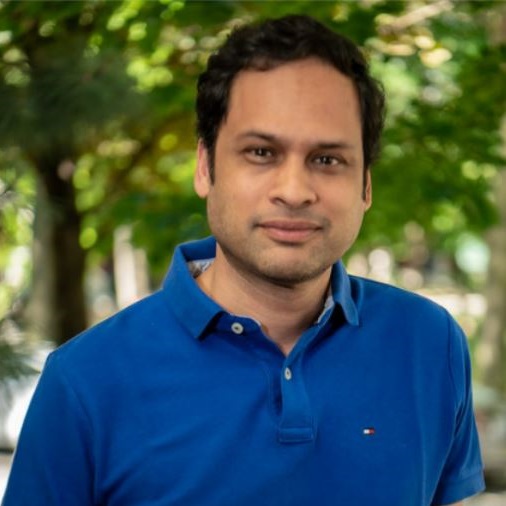
Faculty of Theology professor Dr. Darren Dias, OP has been awarded a grant from the Templeton Religion Trust in conjunction with Profs. Stephan van Erp, Inigo Bocken, and William Desmond of KU Leuven to work on a multi-year project entitled Metaphysics, Contemplation and the Religious Life.
The project, which will see the University of St. Michael’s College and Leuven each host a conference, includes the appointment of Dr. Jacob Benjamins to a post-doctoral position at St. Michael’s to teach and work on conference planning. The project’s work, which falls under the grant’s Widening Horizons in Philosophical Theology initiative, will run from 2022 to 2024.
The project, explains Dias, will explore the tension between metaphysics and theology using methods familiar to continental philosophy—an approach rooted in the thought of 19th- and 20th-century Western Europe—to examine the contemplative practices of the philosophical and theological schools of religious orders and congregations. The project will see scholars working in phenomenology and metaphysics, as well as systematic, mystical, and historical theology, calling on contemplative practices from within the religious schools as a way to support new, practical forms of thought in the twenty-first century.
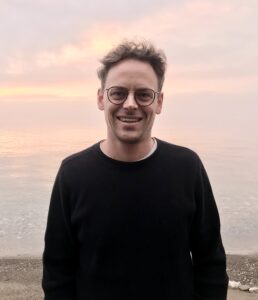
Whereas the past century has seen a rise in a perceived disconnect between metaphysics and theology, this joint project aims to demonstrate that there exists a “metaphysics of contemplation,” which is based not in an abstract approach but grounded in historical, communal, and performative ways of encountering reality as a whole, he says.
There are broad practical applications to the project, notes Benjamins.
“We would like to demonstrate that religious orders have the resources available to enrich spiritual traditions in modern life,” he says.
The first seminar will take place at Leuven December 1 to 4, 2022, hosted by the university’s Interfaculty Centre for Catholic Thought, with a second conference at St. Michael’s March 22 to 24, 2023.
Maria Ivaniv is a doctoral student at the University of St. Michael’s College’s Faculty of Theology, with a particular interest in the Metropolitan Sheptytsky Institute of Eastern Christian Studies. Her research focuses on the participation of the Ukrainian Greco-Catholic Church at Vatican II and its reception of the council in North America. She holds ReMA, MA, and STL degrees in theology and religious studies from the Catholic University of Leuven, Belgium, and MA and STB degrees in theology from the Ukrainian Catholic University. Maria was a lecturer at Three Holy Hierarchs Kyiv Theological Seminary (Kyiv, Ukraine), a teaching assistant in the Theology Department at the Ukrainian Catholic University (Lviv, Ukraine), and served as Secretary of the Patriarchal Commission for the Laity of the Ukrainian Greco-Catholic Church (Lviv, Ukraine).
God is With My People
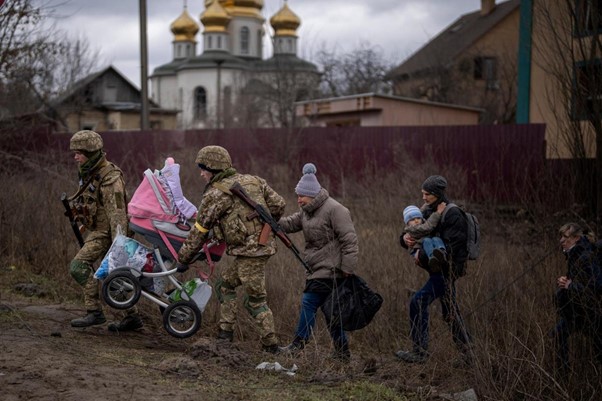
No one has greater love than this, to lay down one’s life for one’s friends. (John 15:13)
It is very difficult—even painful—for me to write these lines. It took me almost three weeks to put on paper thoughts that were on my heart during this time. Therefore, this text is rather a self-reassurance that God is with my people in this horrible time of war.
As I write, the third week of the war in Ukraine is coming to an end. During these days, I constantly follow the news, cry, and pray for my family, friends, and all the Ukrainians trying to survive the bombing and shelling of peaceful cities. As of today, thousands of civilians have been killed, including more than 90 children, and more than two million refugees (mostly women, children, and elderly people) have had to leave their homes/country to save their lives. Hundreds of schools, hospitals, private and historical buildings, and a dozen churches have been destroyed. This is a catastrophe, both humanitarian and of values.
War is a very difficult time. We see a lot of evil, anger, lies, and destruction—and it is so easy to be consumed by all that is going on and forget that God can transfigure these events into something good. We can be active participants in that. During these three weeks, I have been thinking and praying about these things, and I distinguished three moments that are vividly visible now.
Truth. When evil shows its face so brazenly, we can clearly see where the truth is and where there are lies. The Russian government and aggressors use lies everywhere: news, social media, official speeches, church preaching. They call war a “special operation,” invasion and shelling “support and protection” of Russian-speaking Ukrainians, and killing of innocent civilians humanitarian help. We have a popular saying in Ukraine, which derives from John 8:44, and that is that the devil is the father of lies. I agree with this because I am convinced that this war also has a spiritual character. Ukrainians clearly see that they are standing on the side of the Truth. They know they are protecting their homeland, their families, and all that is so dear to their hearts, and that this is the right and truthful thing to do. I am sure that this standing in Truth will help us to win this war.
Unity. Since the first days of the war and the Russian invasion, I have been able to see clearly how united Ukrainians are. This unity is present on many levels. During these days, volunteers in Ukraine and around the globe are organizing humanitarian aid, financial support, psychological help, and many other things. People are united in defending their homeland, in receiving those who left their homes to save their children’s lives, in prayers for peace and victory of the Truth. This unity is not only about Ukrainians—people from different countries around the world are gathering food, clothing, medical supplies, and hosting Ukrainian refugees. This global human unity reminds me of the unity of God in the Holy Trinity.
Love. “No one has greater love than this, to lay down one’s life for one’s friends.” (John 15:13) This verse is the best way to describe the service and dedication of Ukrainian soldiers, volunteers, and all the people who are protecting their homeland. In the first days of the war, a young soldier died in the act of blowing up a bridge to stop the Russian army. A few Ukrainian pilots took enemy fire on themselves to save other pilots. Under the shelling of Russian occupants, volunteers are evacuating civilians and bringing food and water. Love and not anger is the force which is behind all these actions. I cannot deny that there is anger too, but it is rather a reaction to all the atrocities and destruction. Love opens borders and doors for the Ukrainian refugees, saves the lives of POWs, and helps in multiple ways. Love also manifests itself in prayers for those who blindly or consciously came to kill Ukrainians, so that their hearts and eyes would open and that they realize that they are doing terrible things, and return safely home to their families.
Truth, unity, and love are direct signs of God’s presence and are part of his revelation among his people. When I see their presence amid all the suffering, pain, and destruction, I see God’s presence within his people. I do not know how long this war will go on, but I am sure that evil will not prevail because God “is a shield for all who take refuge in him.” (Ps. 18:30)
The University of St. Michael’s College invites members of our community to support one of the many charitable aid agencies engaged in assisting refugees and victims of the conflict, including the Red Cross and Development and Peace/Caritas International.
Read other InsightOut posts.
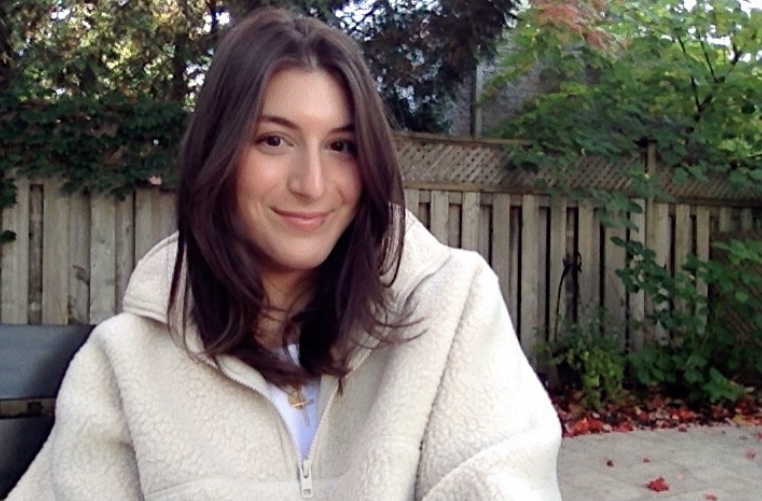
For doctoral candidate Mia Theocharis, an unexpected phone call from St. Michael’s President David Sylvester brought with it the opportunity of a lifetime: an invitation to meet virtually with Pope Francis.
Theocharis has been selected to take part in a virtual meeting with the Pope on February 24. The event, entitled Building Bridges North-South: A Synodal Encounter Between Pope Francis and University Students, is being hosted by Loyola University Chicago in collaboration with the Pontifical Institute for South America as part of the Pope’s Synod on Synodality, a process of consulting Church members around the world to gather their thoughts on the issues of the day.
With an emphasis on creating concrete educational projects to effect just environmental and economic change, the February 24 meeting will focus on issues relating to migration.
Panels of 20 or so students from each of seven regions in North, Central, and South America have been meeting online in advance of the virtual gathering to develop ideas on how to respond to migration challenges, reflecting on the various causes behind and how the Church should respond. Theocharis is one of the three Canadian students in her group, which represents eastern Canada and the eastern United States.
Each panel will have a spokesperson appointed to offer a brief summary of their group’s thoughts at the February 24. These presentations will be followed by a dialogue with Pope Francis.
“While it would be an honour to be the one to present our findings, honestly the biggest honour is to be part of this process,” Theocharis says, describing the drive for concrete ideas and the diversity of panelists she has met in her panel as extremely impressive.
“There are people with backgrounds in economics, environmental sustainability and theology; undergraduates and graduate students. It’s exciting to meet everyone involved, especially those from underrepresented groups, and to hear everyone’s viewpoint.”
The event will be livestreamed on February 24 at 1 p.m. EST.
Dr. Brian Thornton worked as an accountant in 17 countries on four continents. Then he came to Canada and St. Mike’s. A few months ago he successfully defended his doctoral dissertation.
Synodality, Laity, Pope Francis—What’s It All About?
Pope Francis recently called a synod—a meeting of Church leaders—which opened in October and runs until 2023, and includes local consultations as well as meetings in Rome.
Pope Francis has declared that synodality is what God expects of the Church in the 21st century. He has put his own transformative stamp on the meaning and conduct of synods, saying that a synod involves mutual listening in which everyone has something to learn.
Synods are not new. They have been around since the early days of the Church. History records that bishops of neighbouring churches in the second century gathered together to find solutions to their common problems. It was not always stated when or if the laity participated. We know, for example, that bishops, presbyters, deacons and laity attended the Synod of Elvira around about the year 305. The Synod of Whitby in 664 was convened by a layman, King Oswiu, who ruled that the decisions of the synod were to apply in his kingdom. A modern historian has written that Vatican I (1869–1870) was the first ecumenical council “without direct lay participation.”
The irony is that, 10 years earlier, Father John Henry Newman had famously written about the necessity of consulting the faithful in matters of doctrine. In 1917 the Code of Canon Law limited attendance at diocesan synods to priests and bishops. But the Code left ajar the door to lay participation. It allowed diocesan bishops to invite “others” at their discretion, but did not define “others.” Shortly before the end of the Second Vatican Council in 1965 Pope Paul VI established the Synod of Bishops as a permanent institution. Attendance was extended to representatives of religious institutes and to “clerics who are experts.” There was no provision for lay participation.
Then, only eight days after the formal close of Vatican II, the Bishop of London in Ontario made a startling announcement. His diocese was to hold a synod, to which everyone in the diocese— clergy, religious and lay—was invited. He was not concerned that the laity would be in the majority; indeed he welcomed it. He was bent on letting the people of the diocese absorb and receive the teaching of the council. And he planned to be a listening bishop. He used this phrase often for he wanted to hear the opinions of the people on how the diocese should move forward. The voice of the people mattered because he took seriously what the council had taught him about the infallibility of the people of God. His other oft-repeated remark was that the Spirit would speak where the Spirit wished to speak.
More than half a century later this pioneering diocesan synod can be seen in conformity with the call of Pope Francis for a synodal church. Everyone in the church, clergy, religious and lay, has to listen to the others in order to discern the will of the Spirit. It requires an act of faith which is based on the conviction that God is at work in world history. Francis referred to the prophet Elijah who learned that the Lord was not in the wind, nor in the earthquake, nor in the fire, but rather in a tiny whispering sound. “This is how God speaks to us,” said Francis, and “we need to open our ears to hear that tiny whispering sound.”
Since his election Pope Francis has convened synods dealing with the family, young people, and the Amazonian region. Bishops, priests and laity attended them all in limited numbers. Now Francis has launched a synod of the whole Church. It is an ambitious project which will last two years, until 2023. Francis wants to hear the voice of the entire Church, so this synod is an exercise in mutual listening. It starts in the dioceses where all are invited to offer their thoughts and opinions. Each diocese will forward a synthesis to the local bishops’ conference. From there a further synthesis will go forward to the Synod of Bishops in 2023. After that the action moves back to the dioceses for the implementation phase.
Pope Francis opened the synod in October this year. He felt sure that the Spirit would guide the church and “give us the grace to move forward together, to listen to one another and to embark on a discernment of the times in which we are living.” He stressed that the synod was neither a parliament nor an opinion poll, but an ecclesial event. “If the Spirit is not present there will be no synod.” He emphasized the participation of all because participation was a requirement of the faith received in baptism. Baptism was our “identity card,” and his call for all to participate includes those on the fringes. “Enabling everyone to participate is an essential ecclesial duty,” he said.
The subject of this synod is synodality. When we place that alongside two prominent sayings of Francis, a diverting discovery emerges. Firstly, says Francis, synodality is the way of the Church in the 21st century. Secondly, the point of a synod is to discern where the Spirit is leading the Church. We can see then that Francis is inviting the Church to consider and discern synodality, the very subject that is at the heart of his pontificate. He has thrown it wide open. This is a valiant venture with an uncertain end result.
Read other InsightOut posts.
Fr. Andrew Summerson, S.Th.D., is an Assistant Professor of Greek Patristics with the Sheptytsky Institute of Eastern Christian Studies in the Faculty of Theology in the University of St. Michael’s College.
History and Theology as Contemporary Wisdom from the Ancient Desert
In Athanasius of Alexandria’s 4th century “best seller,” Life of Anthony, we are told that upon his parents’ death, he begins soul-searching. An interior inquietude overtakes him and he starts to wonder about the writings of the New Testament. He ponders the apostles’ single-hearted mission to leave everything and follow Christ. He also considers the life of the early Church documented in Acts, where the company of believers laid everything at the apostles’ feet and put it in service of others (Acts 4:35). Anthony’s mental ruminations are confirmed one day in church, when he hears the proclamation of the Lord’s words to the rich man in the Gospel: “Sell everything you have and give to the poor” (Mt 19:21). With this, Anthony offloads his inheritance and takes to the desert. He learns from elder ascetics, practices prayer unceasingly, wrestles with the devil, keeps vigil in caves, heals the sick, and confutes philosophers.
Athanasius explains that Anthony, “a man in the flesh,” is assisted in all these efforts by the “Lord who for our sakes became flesh.” This is a rather loaded statement that needs untangling. Athanasius, the writer of the Life of Anthony, is also one of the greatest theological minds of the early Church, who forcefully defended the faith articulated at Nicaea in 325. The council aimed to narrate precisely who is this “Lord who for our sakes became flesh.” This Lord is of one substance (homoousios) with the Father, a detail still recited every Sunday in the Nicene Creed today, or in the Byzantine tradition, to which I belong, it is sung at every Divine Liturgy.
What is at stake for Athanasius in this doctrinal battle is not simply an ethereal philosophical dispute about the nature of God but rather the accurate reception of God’s revelation to us “according to the Scriptures.” Nicaea means the difference between worshiping a false idol or worshiping the living God, who providentially connects the dots between Anthony’s initial interior stirrings and the public proclamation of the Gospel. The Life of Anthony details the process of the ascetic’s transformation from a quiet kid to a heroic saint, “initiated in the mysteries and filled with the spirit of God.”
Nicene theology creates the conditions for more Anthonys to spring forth in this world. Anthony has internalized Nicaea and proclaims it in his own flesh. If Jesus is a human creature, he is no more than a model to imitate. On the other hand, if Jesus is God who takes on a human nature, he offers human nature a new possibility: to bear “all the fullness of God” (Eph 3:19).
Perhaps Athanasius’ greatest contribution as a theologian is his ability to bridge the gap between the heights of doctrinal controversy and grassroots spirituality. As a historical theologian, I specialize in gaps, particularly gaps between the past and the present. My principal sources are figures from the first millennium. I engage them precisely because it is here, in the cauldron of the first millennium, the language for naming God’s activity in Scripture is formulated for ages to come. These writers developed a grammar that Christians are heirs to. Truthfully, one can speak a language without knowing the grammar. Infants surely begin to formulate sentences long before they can diagram the contents of their principal parts. But learning grammar shows us the sheer power of language, exposing the heights and depths of what words can do when used to their full potential. For us, the grammar of the Nicene Creed may just be a common place prayer that is muttered through Mass. For Athanasius, the creed is the very condition that provides a way for saints to emerge in this world, charged with the power that comes from “the Lord who was made flesh.”
We are continually tempted to forget how we learned Christian language. In our own speaking, we lean on clichés, phrases coined by others so often repeated they have lost their meaning. Such repetition excuses us from the burden of thinking. One must not forget that clichés come about in the first place because they are powerful statements that conjure up popular agreement and therefore are worth repeating. Studying the sources of Christian language ensures that the truths of the faith do not become vacuous statements but remain powerful and transformative. When properly interrogated, reading the texts of the ancient dead ensures that we can hear them as clearly as Anthony did the Scriptures. Historical theology aims at the same results. Without access to these sources, we cut the Christian tradition short. We miss the power of its language, capable of cultivating Anthonys, whose life captivated a 4th century crowd and is worth the hard work of making sense of in the 21st.
Read other InsightOut posts.
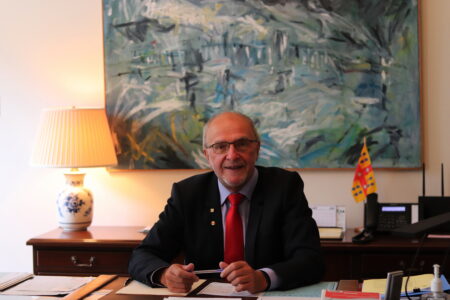
Professor Gilles Routhier will be awarded the highest academic honour at the University of St. Michael’s College, the Doctor of Divinity honoris causa, at this year’s Faculty of Theology convocation, which takes place on Nov. 13, 2021.
The honorary degree stands in recognition of Dr. Routhier’s outstanding body of scholarly work, his continuing international leadership and impact in the field of theology, and his service to his institution and the academy.
Professeur titulaire and former Dean of the Faculty of Theology and Religious Sciences at Laval University, recently appointed Rector of the Seminary of Quebec, Member of the Royal Society of Canada, and priest of Archdiocese of Quebec, Fr. Routhier is a world-renowned scholar who has published extensively and shaped in profound ways the current field of theological study around the globe.
Professor Routhier’s body of scholarly work is both monumental and influential. The author and co-author of more than 40 books, and editor and co-editor of more than 35 others, he has published more than 160 peer-reviewed articles, and more than 180 book chapters. He has given more than 300 academic lectures—across North and South America, throughout Europe and in Africa and Asia—on topics ranging from pastoral and practical theology to ecumenism and ecclesiology. He has been awarded approximately $1M CAD in support of his research at Laval. Through his teaching, Fr. Routhier has shaped a generation of critically minded new scholars and had a measurable impact on our understanding of the history of Catholicism in Quebec, the reception and hermeneutics of Vatican II, ecclesiology, missiology, history of theology, Mariology, and practical and pastoral theology.
Professor Routhier is currently working on a research project with Faculty of Theology Professors Michel Attridge and Darren Dias entitled “One Canada, Two Catholicisms: Divergent Evolutions in the Catholic Church in Quebec and Ontario, 1965-1985,” funded by the Social Sciences and Humanities Research Council of Canada.
Much of Professor Routhier’s work was done while he has carried significant administrative responsibilities at Laval University. His appointment as Rector of the historic and influential Seminary of Quebec, founded in the 17th century, follows his many years of leadership in the Laval Faculty of Theology and Religious Sciences, as Dean from 2012-2020, and as Vice-Dean from 2008-2012 and 2001-2003. His curriculum vitae captures in detailhis remarkable service to Laval and beyond the University. Among those pages you will find contributions to the Archdiocese of Quebec, the Church in Quebec, service to the Canadian Conference of Catholic Bishops, and to the Vatican. Professor Routhier becomes the most recent in a lengthy list of honorary degree recipients, a list which includes such names as Bernard Lonergan, Catherine de Hueck Doherty, Gustavo Gutierrez and Romeo D’Allaire.
Celebrate this year’s graduates with us at the Faculty of Theology’s Fall Convocation 2021 page.
Fall Convocation for the St. Michael’s Faculty of Theology and the Graduate Diploma in Social Responsibility and Sustainability program will take place online on Saturday, Nov. 13, 2021. To celebrate, we’re sharing the stories of some of this year’s graduates.
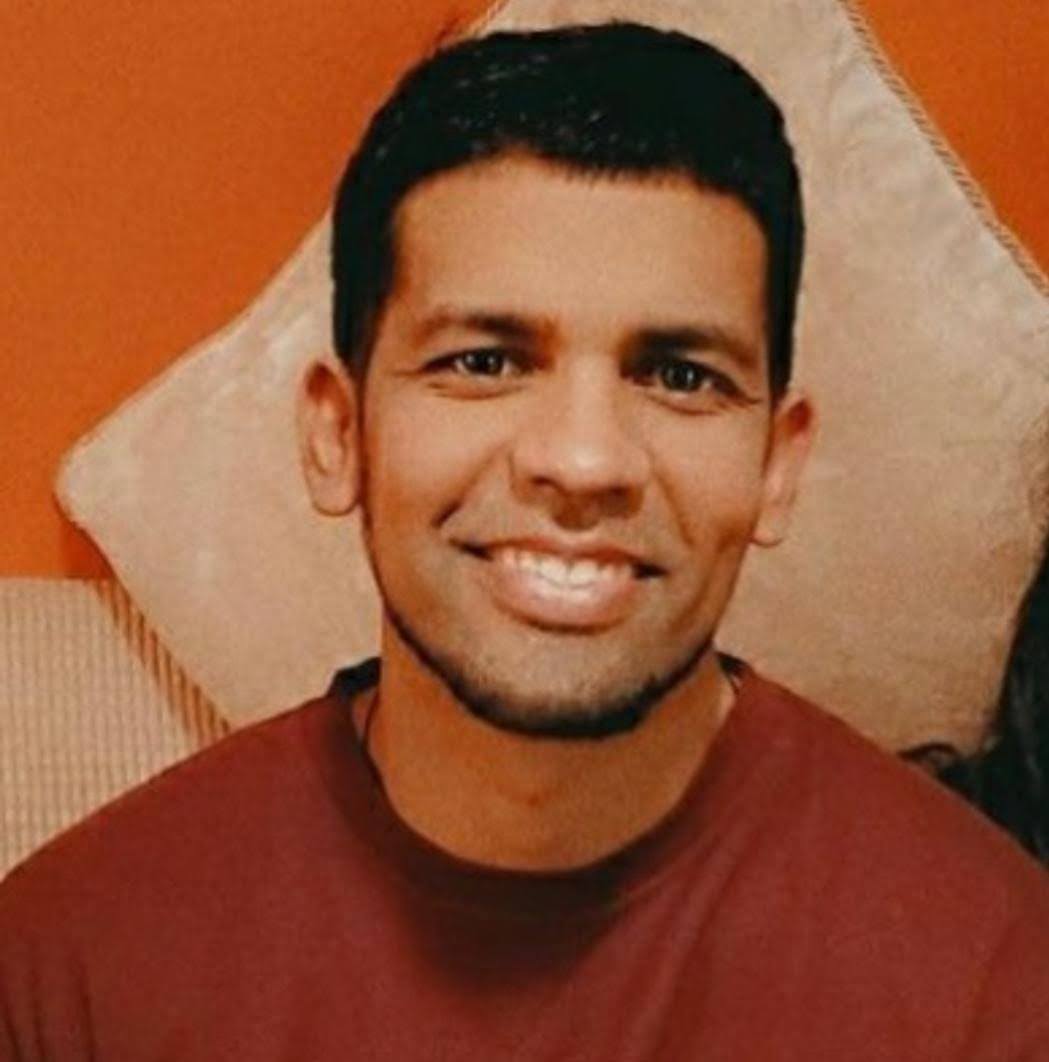
“I was drawn to study at the St. Mike’s Faculty of Theology out of a desire to learn more about my faith and my church,” says Andrew Selvam, a member of the Dufferin-Peel Catholic School Board (DPCDSB) cohort who will be awarded his Master of Religious Education degree on Saturday, Nov. 13, 2021. “At the same time, it became evident that St. Mike’s had an awesome reputation in the field of Theology within the province and country. Having a faculty with a local satellite campus and a program drawn towards educators made it easier to complete my first few courses.”
While the pandemic altered delivery of classes, Andrew says “both the virtual and in-class experiences were enjoyable…. The lectures, readings and discussions were informative and made you want to delve deeper into aspects of faith and course content that you had never thought of before. Professors care about your experience and understanding of the material.”
While earning his degree while working working full-time was a significant time commitment, Andrew notes that program offerings at other colleges within the Toronto School of Theology expanded his choices, both in terms of scheduling and course options. And, he adds, “St. Mike’s also has an incredibly faculty of professors who are here to assist you.”
He singles out experiential learning as a particular benefit to his time at. St. Mike’s, noting the abilty to study ecotheology with the Sisters of St. Joseph at their retreat centre in Cobourg and the opportunity to enroll in A Journey Through History: The Jesuit Mission in Midland were particularly meaningful.
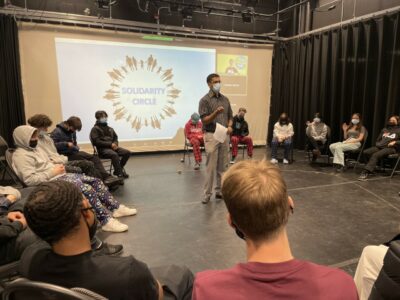
As he looks forward, Andrew says his experience at the Faculty will be a huge benefit as he begins his new ministry as a chaplaincy leader with at Iona Catholic Secondary School, adding that his studies were also relevant to his classroom work as a degree as a science and religion teacher.
“Catholic Social Teaching has made me more aware of the issues facing our world and pushed me further to a spirit of service not only in my local but global community as well,” he says.
“The friends and academic family you build at St. Mike’s will continue to be with you for many years to come,” Andrew says. “I was invited and encouraged by students in the Master’s program at St. Mike’s and hope that I can do the same.”
Celebrate this year’s graduates with us at the Faculty of Theology’s Fall Convocation 2021 page.
Join Dr. Hilda Koster, the new holder of the Sisters of St. Joseph in Toronto Chair in Theology, at her first St. Michael’s conference November 11 and 12. Learn more about the conference from Dr. Koster’s description below.
- Thursday, November 11: 7 p.m. –8:30 p.m. ET
- Friday, November 12: 8:30 a.m. – 1:15 p.m. ET
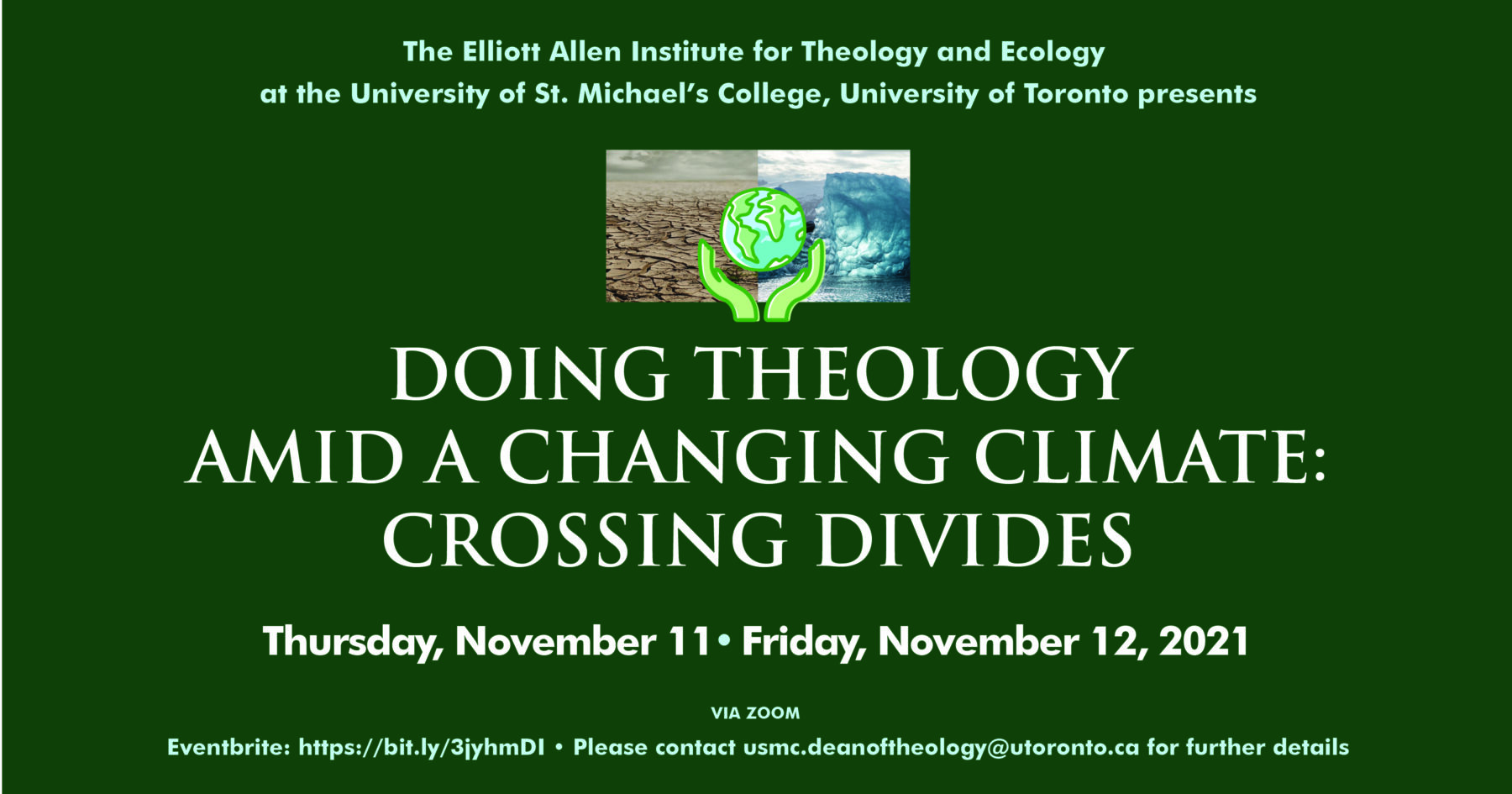
As world leaders gather at the COP 26 UN Climate Change Conference in Glasgow to implement the Paris climate agreement, the web-conference “Doing Theology Amid a Changing Climate: Crossing Divides” explores Christian theology’s contribution to the cultural, social, and spiritual transitions needed. Together with scientists and leaders from other faith traditions, Christian churches and communities have provided common witness on climate change. Yet because climate change is not simply an issue to be addressed but signals a need for a radical change in the way we inhabit a damaged planet, theologians and scientists discuss what more is required at this crucial geo-historical moment.
The speakers and panelists will ask how we can more effectively collaborate across disciplines and align our theology with cosmology and evolutionary science. How can we overcome divisions on climate science in a post-truth world? Which revelations of the sacred will nurture our interdependence with one another and the more than human world? And, as climate change further divides climate privileged and vulnerable communities along lines of race, gender, and ethnicity, how may theologians and community leaders work together to address questions of climate justice?
This conference is hosted by the Elliott Allen Institute for Theology and Ecology at the University of St. Michael’s College (Toronto), a leading interdisciplinary Institute for scholarship and dialogue rooted in the Catholic intellectual tradition.
Thursday, November 11
7–8:30 p.m.
A keynote speech delivered the night before by Franciscan Sr. Ilia Delio of Villanova University in Pennsylvania will set the scene for panel discussions of climate justice, gender justice, climate science and climate anxiety and the Church’s response. (The Catholic Register, Oct. 23, 2021)
Keynote: “Earth’s Fragility and the Crisis of Transcendence: Why Science and Religion Must be Reconciled”
Speaker: Dr. Ilia Delio, OSF Josephine C. Connelly Endowed Chair in Theology at Villanova University
Friday, November 12
Session 1: Climate Justice and Gender Justice: Addressing Inequities and Working across Difference (8:30 – 10:00 a.m.)
To many poor and minority communities, climate change means death and destruction on an ever-larger scale. Women and gender-diverse people are especially vulnerable. Speaking from various contexts and in solidarity with communities in both the global North and South this panel of renowned Catholic women theologians discusses these inequities and injustices with a focus on resource extraction and gender justice.
Session 2: Theology and Climate Science: Addressing Indifference, Fear, and Denial (10:15 – 11:30 a.m.)
To address climate change, theologians and climate scientists need to further engage in dialogue across disciplines. This panel explores the possibilities and challenges for this collaboration. How can climate science inform Christian theology? How can they both challenge religiously motivated climate change denialism? How can theology address fear and deep-seated anxiety about the consequences of climate change? What role do climate scientists see for the wisdom and power of religion and spirituality?
Session 3: Working across Ecclesial and Colonial Divides (11:45 a.m. – 13:15 p.m.)
Despite considerable ecumenical efforts towards a common witness, Christianity remains deeply divided on ethical issues, including climate change. Theologians representing various confessional and ecclesial traditions and communities address the challenges of ecumenical collaboration. Can Catholics come together with other Christians around the vision for climate justice and sustainability that Pope Francis unfolds in the encyclical Laudato si’? Can Christians from the global South and North work together to address issues of climate injustice amidst the enduring legacy of colonialism?
Dr. Hilda P. Koster is an Associate Professor of Theology and Director of the Elliott Allen Institute for Theology and Ecology.
Of Heatwaves, Floods and Climate Change—Our Kairos Moment

What could have been a summer of cautious optimism about life post COVID-19 has unfortunately become a summer filled with climate change-related horrors. Wildfires due to the record-breaking temperatures and a prolonged drought in the Pacific Northwest took human life and destroyed homes. It also ravaged thousands of acres of forest and seriously endangered marine wildlife. In Northern Europe, including in my native country, The Netherlands, torrential rains caused unprecedented flooding and mudslides. In South Madagascar, off the coast of East Africa, the worst drought in four decades is driving more than a million people into famine.
While the connection between climate and weather is complex, climate scientists agree that the heat waves and rains of this past summer are clearly linked to anthropogenic changes to the climate. What has scientists alarmed, however, is not that there is a connection between extreme weather events and climate change but that these events have been so severe and prolonged. Harvard environmental policy professor John Holdren, who served as senior adviser to former U.S. President Barack Obama, observes that “[e]verything we worried about is happening, and it is all happening at the high end of projections, even faster than the previous most pessimistic estimates.” (Los Angeles Times, July 21). The world truly is running out of time and many people seem to sense this.
The Ecumenical Patriarch Bartholomew has called the climate crisis a Kairos moment for our churches and the world: “For the human race as a whole there is now a Kairos, a decisive time in our relationship with God’s creation. We will either act in time to protect life on earth from the worst consequence of human folly, or we will fail to act.” (Closing Address to Symposium on the Arctic, 2007). The Greek word Kairos means the right or opportune moment. From a theological perspective Kairos indicates that time takes on a holy urgency. Time is no longer simply linear time, stretching open towards the future. Instead, it becomes critical to act. Calling climate change a Kairos moment thus marks the present as a moment of truth and opportunity; a moment where our collective response will have far-reaching consequences.
This fall the eyes of the world are on the 26th UN Climate Change conference in Glasgow (Scotland). COP26 is meeting with the urgent task to implement the climate commitments of the 2015 Paris Climate Accord, which seek to limit the increase of the planet’s temperature to 1.5 degrees Celsius. The question before us then is whether the world community (especially the world’s wealthiest nations) can seize the moment of pandemic recovery as an opportunity to enact the necessary climate policies. For if we fail to grasp this moment and do in fact return to pre-pandemic rates of fossil fuel emission the world could be 1.5̊ Celsius hotter than it was prior to the industrial revolution as soon as 2030 and on track for much higher temperatures.
It is tempting to be skeptical about international climate conferences. After all, the world has passed many climate thresholds since the first UN climate conference in 1992. Climate change, however, is not just a political challenge; it is also a theological and spiritual one. In fact, our response to climate change touches upon the very core of Christian witness. For according to the Biblical tradition, God did not just create the world but also called it good. The Hebrew word for good, tov, means more than “good.” It implies a goodness that is life furthering, a life-generating capacity. Human induced climate change does not just go against this life-furthering capacity but is also undoing it. For those of us living in climate privileged communities, despair, resignation, or indifference are therefore not an option. Instead, we are called, in Pope Francis’ words, to an ecological conversion —that is, a change of heart in the way we look at, interact with, and behave towards the more-than human world with which we are entangled and on which we depend.
Kairos language keeps open the possibility of such an ecological conversion. It is stubbornly hopeful. In the Book of Revelation, John of Patmos sketches doomsday scenarios that eerily resemble those of our day. Yet with all its woes, Revelation does not foreclose the possibility of repentance (metanoia) and turning around. According to the New Testament scholar and eco-theologian Barbara Rossing, the catastrophes depicted by John are neither willed by God nor follow a cosmic destiny. In Revelation, God laments the state of the earth yet places the Christian community at an ethical crossroad (a Kairos moment) where it needs to choose between the polluting, death-dealing powers of Rome/Babylon or God’s New Jerusalem. While time is of the essence, John holds out the hope that the world will listen to the witnesses he so powerfully invokes towards the end of his book. It is significant, too, that Revelation ends with an attractive vision of the tree of life. There is no return to Eden, but there is a vision of what is possible. A vision rooted in the beauty and resilience of planetary life and in practices of an alternative political ecology, symbolized by the city-garden.
Many have heeded Pope Francis’ call for an ecological conversion. This September several religious communities and interfaith groups are embarking on a pilgrimage to COP26. They are visionary witnesses. Those of us outside the United Kingdom and Scotland are invited to add our own witness by walking to a special place or spot near us, posting our pictures and messages #Walkingtheland2021. Our messages will be collected and shared with delegates at COP26. In a time such as this, a time in which the world is running out of time, I invite all of you to participate in the Walking the Land project at https://www.pilgrimagefornature.com/walking-the-land and add your voice, dreams and hopes for our life together on this fragile planet.
Read other InsightOut posts.
Dr. Cynthia Cameron is the newly appointed Keenan Chair of Religious Education and Assistant Professor of Religious Education in the Faculty of Theology. Prior to coming to St. Mike’s, she taught undergraduate students at Rivier University and graduate students at Boston College and Loyola University New Orleans. Her research focuses on adolescence, particularly female adolescence, and the history and mission of Catholic schools.
Pandemic Safety and the Classroom

“I don’t want to see my students as threats.”
This was the anguished comment from a Catholic high school theology teacher in a graduate religious education course last summer, in the midst of the COVID-19 pandemic. We were discussing the challenges and opportunities presented by teaching during the pandemic and, in particular, the possibility of Catholic high schools returning to face-to-face instruction in the fall of 2021. This student’s entreaty struck a chord with the class.
On some level, this reflects a common problem in schools. The busyness of planning for in-person teaching leads to a tendency to treat students as pieces in a complex puzzle. The task for educators is to figure out how to arrange the pieces so that students can be in classrooms efficiently and, now, safely. A rather de-humanizing perspective on the young people in our classrooms.
But, more importantly, these teachers were reflecting on how the push to in-person instruction— often decided on without much input from the teachers themselves—made them feel unsafe. The students, as potential carriers of the coronavirus, were threats to the physical safety of teachers. At this point in the pandemic, at least in the United States, it seemed that children and adolescents contracted the virus at lower rates and tended to suffer milder cases of COVID when infected. Which was, of course, good news. However, teachers are adults and, as such, were at greater risk from the virus. And, teachers were being asked to take on this significant risk in order to teach in a face-to-face environment. All over the US, some teachers decided the risk was too great, that their students were a threat, and some even left their jobs.
For the students in my class—all dedicated, but relatively novice, Catholic high school teachers—this led to a fascinating conversation about how we think about, talk about, and treat the adolescent students in our classrooms in a time of pandemic. What happens when we think about our students as threats? How can this not change the ways that we relate to them? And how can Catholic theological anthropology guide us in resisting this kind of thinking?
Theological anthropology is the branch of theology that wonders about what it means to be a human person created by God and in relationship with God and others. This is where the Church reflects on the meaning of our humanity. The two doctrines that most often come up in contemporary Catholic theological anthropology are that we are created in God’s image and that God took on human form in the person of Jesus. The first of these doctrines—that we are created in God’s image (Genesis 2:26-27)—suggests to us that there is something about humanity that reflects the reality of the divine, that we are like God in some way, that humans reveal in some small and imperfect way what God might be like. And, importantly, since God created humanity in God’s own image, humanity is fundamentally good. The second doctrine—that God became human in Jesus (John 1:14)—also points to this fundamental goodness in humanity. For God to take on the human condition suggests that God thinks highly enough of the human condition to be concerned for humanity. In Jesus, God is telling us that humanity is taken on by God, loved by God, and saved by God. So, drawing from these two doctrines, we can be comfortable saying that humans are created by God and loved by God and that there is goodness in our humanity.
But humans have historically struggled to act as if we are fundamentally good. We don’t always treat one another and ourselves in ways that reflect our theological commitments to the fundamental goodness of humanity. And, since teachers, even Catholic school teachers, can fall into this trap just as easily as anyone else, I often ask them to reflect on this question: “Are your students basically good or basically bad? Are they good kids who occasionally mess up or are they little monsters who need to be whipped into shape?” How a teacher answers this question reveals a great deal about how they will relate to their students. And, in my experience, the vast majority of teachers view their students as fundamentally good human beings, even when they are difficult or annoying.
But, how is this positive vision of the human person disrupted when the students become unintentional threats to the lives of the teacher? How are we to maintain and live out a conviction that they are fundamentally good if we are afraid of them? Does our conviction that they are fundamentally good mean that we have to ignore the threat that they may pose?
I don’t have any answers for my student or for any of us who found ourselves fearing our fellow human beings and the risk that they posed to us simply by existing alongside of us. On the one hand, the gradual reopening of things that has accompanied increasing vaccination rates in 2021 has started to lessen the need to think of my fellow human beings as a threat to my health and safety. On the other hand, as it has done with so many other issues, the pandemic has revealed to us the ways that we fail to live up to our theological ideals. The fact that we did think of our fellow human beings as threats is a challenge to all of us to think about what it means to love our fellow human beings, who are created by and loved by God, who are fundamentally good.
Read other InsightOut posts.
Colleen Shantz is Associate Professor of New Testament and Christian Origins in the Faculty of Theology and cross-listed to the Department for the Study of Religion, University of Toronto. Her research explores the formation of Christianity in the first three centuries CE and especially the role of affect, ritual, and religious experience in the origins of Christianity. She teaches a course on the foundations of justice in the gospels, which is where she first got to know Michael Iafrate.
Between the Present and the Hoped-for Future: Reflecting on the Life of Michael J. Iafrate

Last week a memorial service was held on campus (and Zoom) for Michael J. Iafrate who died in May of this year. Michael was a doctoral student at the Faculty of Theology, beloved to friends across the continent, a prophetic voice in the Catholic Church, a gifted singer-songwriter, a father, partner, brother, and son.
Such a list of roles may seem pro forma in a reflection on a life, but I muted it—considerably. Let me add just two more characteristics to illustrate: Mike was also a committed Weird Al fan and the lead author of The Telling Takes Us Home (2015), a call to justice that is intimately tied to the work of the Catholic Committee of Appalachia (CCA) where he was Co-Coordinator. Few lives encompass such breadth of passion.
Mike’s death came unexpectedly. He was just 44 and he left behind his three young children and his spouse, Jocelyn Carlson, after being diagnosed with leukemia about 6 months earlier. But his death violated expectations in another way, simply by being so out of sync with the size and vitality of his life and the work of justice ahead of him. His work with CCA regularly engaged coal mining in West Virginia, especially its effects on the dignity of labourers, care for the environment, and attention to the poor and vulnerable. You may recognize these three themes as central to Catholic Social Teaching. Mike gave urgent voice to their intersecting effects for the people of West Virginia.
Perhaps without realizing it, I think that many of us who knew Mike had invested in the future of his work for justice. Every day that he took up those causes—sometimes in the face of significant opposition—he helped me, among others, to hope that better conditions were possible. When we saw him pursuing justice, we saw a bridge between things as they are now and the world as it should be. Often, we fallible humans don’t realize we’ve been depending on such links between reality and hope until our expectations are violated.
Of course, Mike’s death also came in the middle of an even larger set of meaning violations: a pandemic, for goodness’s sake; a more urgent awareness of the pervasiveness of racism; and here, in Canada, the devastating proof of genocide and the failure of episcopal leadership to respond meaningfully. Many of the links between our values and expectations, and the realities of the world have been fractured during these past months. To borrow an image from Romans 8, the earth itself groans with grief for the children who were harmed as it groans in the degradation of strip mining.
In fact, that section of Romans was one of the readings from the memorial service for Michael. In Romans 8:18-27, Paul talks about the whole of creation groaning as it waits for liberation: “Even we—who have the first harvest of the spirit—even we groan within ourselves longing for our adoption, the liberation of our bodies. …However, hope that is seen is not hope—for who hopes for what they already see?”
To the degree that Catholic universities are formed by principles of Catholic Social Teaching, they can also generate such bridges between the present disorder and what we only hope for. When we foster attention to human dignity, for example, not only in what we teach but how we teach it, we better prepare people to create the pathways between the present moment and the liberation for which the world is aching. I give thanks for the way our brother Michael Iafrate lived into that vision in his particular, powerful, complex, too-short life. May many more like him be nurtured through relevant and hopeful education.
Read other InsightOut posts.
Part of the communications team, Catherine Mulroney studied English and Medieval Studies at St. Mike’s and returned recently to complete an M Div at the Faculty of Theology.
A Shot in the Arm

“Love hurts,” the old song says. But a little short-term pain for long-term gain is always worth it—and especially in these unusual times.
A few days ago, I joined the millions of Canadians now vaccinated. I got a shot of Pfizer and, in the spirit of full disclosure, it didn’t really hurt at all, but for a little site tenderness that lasted all of 18 hours.
My injection moment made me want to recreate Rocky’s famous run up the steps of the Philadelphia Museum of Art, or Braveheart’s freedom speech, or Gene’s Kelly’s iconic “Singin’ in the Rain” dance because had been so long in coming and meant so much.
In truth, though, the only thing I did do was get a little teary-eyed because taking 20 minutes out of my day meant I was now one step closer to seeing my children again, a little bit closer to getting back to my real office, and I could now say I was helping in my own small way to end the nightmare we’ve all been living for more than a year. I think I’d forgotten what a pleasant sensation relief can be.
I’m happy to say that my employer, the University of St. Michael’s College, has been supportive as vaccinations have been rolled out, encouraging staff and faculty to get a shot, and offering time off to attend vaccine clinic appointments. It’s a mindset that brings our 180 strategic plan alive for me.
In these days of the coronavirus, I am reminded that the 180 is not just a statement to hang on the wall but a reflection of a lived attitude. The references to such things as concern for the common good, the need to recognize the dignity of all, and our need to care for all creation actually mean something to all of us. Challenging times are bringing that to light. I see this in the professors’ concern for students’ wellbeing, and their understanding that, these days, support and encouragement trumps deadlines. I see it in the student life staff and volunteers’ outreach to students, ensuring they know about extra funding available during COVID or offering reminders to take a break and engage in self-care, informing students of how they can get extra emotional support if needed. And I see it in email traffic and Zoom calls where we are all beginning to realize, via expressions of longing to be together again, that we might all be a little closer than just colleagues.
Daily, I watch the very lessons lived out on campus that I learned in ethics classes while studying theology at St. Mike’s, or while reading the classics here as an undergrad. Life is beautiful and precious and we are called to do our best not only to respect and protect it, but to celebrate it, too. To me, that lesson includes getting a shot—for myself and for my neighbours. We are to live out the now oft-used phrase that we are all in this together. I’m proud to be an alumna—and an employee—of a workplace that practises what it preaches.
As strong as all these motivations are, though, my primary impetus for getting a shot was to ease my kids’ worries. Their dad died a week before the pandemic lockdown began, and the early warnings about the severity of COVID had them stressed about their mother’s health.
“We’ve just had one parent die. We don’t want to lose the other,” said the oldest, soon after the pandemic began, speaking as the now-elder statesman in his usual blunt fashion.
For the following six weeks, I only went as far as our garden, guiltily answering the door on occasions, but mostly watching the world pass by from our front window.
But then, early May dawned, and with it, my first solitary wedding anniversary. I felt an overwhelming desire to visit the garden centre and buy some plants, something that Mike and I had done in May for as long in as we’d been homeowners.
I can’t say it was a fun trip, as it was laden with guilt: guilt for co-opting my youngest into accompanying me on my covert operation, and guilt that I was contravening a heartfelt request from my children. On an up note, though, I felt 17 again, because it reminded me of being in high school and bending a few of my parents’ rules—just slightly, of course.
I monitored dropping age limits and expanding availability and leapt when my chance came. It took close to an hour on hold with the Ministry of Health to book an appointment, and the poor woman who answered my call had a wailing child in the background, but it was all worth it.
My kids put on a brave face at all times for their mother but I know they were relieved. I was just happy I could do something that would ease some of the pile of worries each of them has these days. Then attention shifted to when they could be vaccinated, too, jealous that Molly, the child living in Florida for the year, has already had both doses of Moderna.
This has been an extended period of loss for all of us. Some of the those losses, of course, are trivial—the inability to hit the links, or the discovery that not being able to go to the hairdresser’s means saying goodbye to a preferred hair colour.
And some, of course, are profound. I don’t know anyone who hasn’t lost a friend or relative in the past year, including some to COVID, with their grief compounded by the inability to say a proper goodbye.
That’s why the vaccine, along with continuing measures such as masking and social distancing, remain so important. A shot in your arm is a shot in the arm for all of us. Take one for the team.
Read other InsightOut posts.
Fr. Gustave Noel Ineza, OP, is a doctoral student at St. Michael’s Faculty of Theology. Born and raised in Rwanda, he lived through the 1994 genocide against the Tutsi and went into exile for a month in what was then Zaire. His family left the refugee camps and returned to Rwanda after three members of his family developed cholera. He studied in the minor seminary and joined the Dominican Order in 2002. He studied Philosophy in Burundi, and Theology in South Africa (SJTI/Pietermaritzburg) and the UK (Blackfriars/Oxford). Ordained in 2014, he worked for Domuni (www.domuni.eu) and was a chaplain to university and high school students. In 2018, he came to Canada to pursue studies in Christian-Muslim dialogue. He is currently reading on post-colonial approaches to the taxonomies assigned to religious traditions (Muslims and Christians) by colonial powers in Rwanda.
Do We Need Someone to Die to Remind Us that Black Lives Matter?
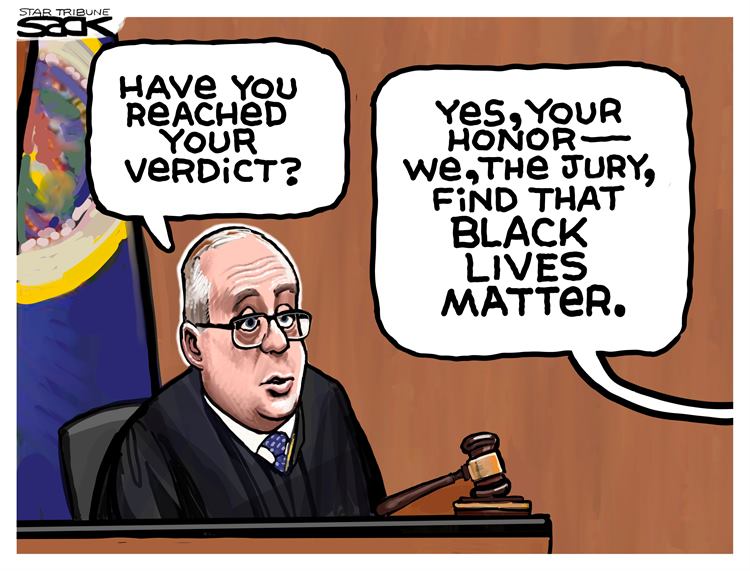
Black lives matter! That was more or less the verdict, 11 months after the brutal killing of George Floyd by Officer Derek Michael Chauvin, and 43-day-long traumatic trial. Twenty-nine years and a month after the trial of four police officers who savagely beat Rodney King, the fear of an acquittal gripped American society used to police officers’ trials ending with disappointing verdicts and acquittals.
The trial finished ahead of the U.S. Senate vote on a bill on April 21, 2021 to combat anti-Asian American hate crimes. Racial tensions have spiked in the United States, tensions that followed the empowerment of white supremacists, a reality which reached a peak with the Unite the Right rally in Charlottesville, a gathering of racist groups that envied the 1930s Reichsparteitage or Nuremberg Rallies.
Four years prior to George Floyd’s murder, a 24-year old Malian-Frenchman, Adama Traoré, died, on his birthday, in police custody, after he was brutalized by French police. Since Traoré’s death, a huge debate has begun in France. Universalist leftist thinkers were scared that rhetoric that generalizes about police brutality might hinder the “Republic,” a chimeric ideal of French unity that assumes all French citizens are equal and equitably treated by the law. Realist activists, often represented by a courageous woman named Rokhaya Diallo, never stop warning the French that there is a risk of considering the American police brutality as something particular to America, because it is widespread in many European cities. Diallo, who seems to carry alone the Black Lives Matter movement on her shoulders, has become the black sheep of a denialist French media because of her positions. The French President’s attacks on “American” Postcolonial movements, “a catch-all term covering everything from anti-colonial thought to critical race theory, intersectional theory to Black Lives Matter,” highlight the persistent denial of oppression towards racialized minorities in many former colonial European powers. Protests to bring to justice Traoré’s murderers were met with brutal police reactions. France is deeply immersed in denial of its racist colonial past, which lives on in its treatment of racialized minorities.
Indeed, change may take several decades to come, even in the United States. After the verdict was announced, the U.S. Representative for New York’s 14th congressional district, Alexandria Ocasio-Cortez, wrote on her Facebook page: “That a family had to lose a son, brother, and father; that a teenage girl had to film and post a murder; that millions across the country had to organize and march just for George Floyd to be seen and valued is not justice. And this verdict is not a substitute for policy change.” Former U.S. President Barack Obama wrote that “true justice requires that we come to terms with the fact that Black Americans are treated differently, every day [and] millions of our friends, family, and fellow citizens live in fear that their next encounter with law enforcement could be their last.” Obama added: “While [the] verdict may have been a necessary step on the road to progress, it was far from a sufficient one. We cannot rest. We will need to follow through with the concrete reforms that will reduce and ultimately eliminate racial bias in our criminal justice system. We will need to redouble efforts to expand economic opportunity for those communities that have been too long marginalized.”
Japanese Tennis player Naomi Osaka, who grew up and lives in the U.S., tweeted these very heartbreaking words: “I was going to make a celebratory tweet but then I was hit with sadness because we are celebrating something that is clear as day. The fact that so many injustices occurred to make us hold our breath toward this outcome is really telling.” In other words, no reasonable person believes that the verdict on Chauvin’s crimes signifies the end of police brutality to Black people. It becomes even harder when some influential TV hosts, like Fox News’ Greg Gutfeld, made it clear they believe Chauvin may not be guilty. Gutfeld stated that the only reason he would want the verdict to incriminate Chauvin is because his neighborhood was looted last summer.
The whole idea of looking at Black people as a threat has been used to justify the discriminatory policing of Black neighbourhoods and unreasonable stop-and-frisks of Black people by law enforcement in the U.S. One highlight of the trial occurred when one of the prosecutors, Steven Schleicher, explained the difference between a threat and a risk. That some insecure white law enforcement agents, empowered by systemic racism in their institutions, might be inhabited by an unreasonable fear of black people transforms Black people neither into threats nor risks. That Brooklyn Center Police Officer Kim Potter, while training a rookie, had to pull a gun on Daunte Demetrius Wright for an outstanding driving ticket explains what may go on in the routine training of American police officers. The fact that she screamed “taser, taser, taser” while shooting him with a gun is also confusing. My training officer in my military service forgot to tell me about the usefulness of screaming “gun, gun, gun” while I am shooting at the target! The most surprising thing is the many peaceful arrests of white mass shooting perpetrators, such as Kyle Rittenhouse and Dylann Roof, which proves that police officers are trained in how to de-escalate tensions, even with highly dangerous individuals. Apparently, that training does not equally apply to people of colour.
One of the most racist whataboutisms on police criminal treatment of Black people in the U.S. is the objection phrased in these words: “What about Black-on-Black crime?” Black-on-Black crime is punished, sometimes beyond the realms of reasonable corrections. In almost all instances when police are accused of the summary execution of Black people, judicial institutions focus on police training guidelines. The fact that Black lives matter is not news to Black people. Black people who take other Black peoples’ lives know they committed a crime and that they would be seriously punished if caught.
The verdict in Chauvin’s trial does not end anti-Black racism. Orchestrated attacks on Colin Kaepernick’s knee may have ended but it will still take years before Black people start feeling safe anywhere around the police. I still get followed by the police in some liquor stores. When I am, I still have the luxury to bother them with words like: “Oh! Because you are here, can you help me find a Coudoulet de Beaucastel Côtes du Rhône Blanc and a Philippe Colin Chassagne-Montrachet, please?”—in a very French accent. However, most Black people are extremely bothered by their presence. An African American friend advised me to never ask them to fetch me a lemonade.
I think the Church must be careful in these times. When people marched against police brutality following George Floyd’s killing on June 1st, 2020, President Donald J. Trump ordered the peaceful dispersal of the crowds protesting near the White House so that he might stage a photo-op before St. John’s Episcopal Church. In a brilliant article for The Atlantic, Garrett Epps, Professor of Constitutional Law at the University of Baltimore, called it “Trump’s Tiananmen moment.” However, the most alarming aspect is that President Trump chose to violate American citizens’ First Amendment rights so that he could take a picture in front of a church, holding a Bible. The following day, President Trump and first lady Melania Trump visited the Saint John Paul II National Shrine in Washington. While many religious leaders condemned the photo ops, Trump still managed to sow discord among Christians—those who thought his attitude toward protests against police brutality was godly versus those who were disgusted.
Many police departments have Christian chaplains, and law enforcement agents are members of our parishes. Just as Church leaders in the past transformed the pulpit as a place to theologically defend civil rights, it is a Christian duty that it become clear to all the faithful that to God, Black lives matter.
Read other InsightOut posts.
Fr. Gustave Noel Ineza, OP, is a doctoral student at St. Michael’s Faculty of Theology. Born and raised in Rwanda, he lived through the 1994 genocide against the Tutsi and went into exile for a month in what was then Zaire. His family left the refugee camps and returned to Rwanda after three members of his family developed cholera. He studied in the minor seminary and joined the Dominican Order in 2002. He studied Philosophy in Burundi, and Theology in South Africa (SJTI/Pietermaritzburg) and the UK (Blackfriars/Oxford). Ordained in 2014, he worked for Domuni (www.domuni.eu) and was a chaplain to university and high school students. In 2018, he came to Canada to pursue studies in Christian-Muslim dialogue. He is currently reading on post-colonial approaches to the taxonomies assigned to religious traditions (Muslims and Christians) by colonial powers in Rwanda.
The Other Sister
The COVID-19 pandemic has taught many to value more highly essential workers who are usually underpaid after long hours of vital work. Nurses are among the most praised as they daily risk contracting the virus while trying to offer a treatment to the sick. It is not the first time that nurses, women in particular, have risked their lives to save other people’s lives during pandemics. Several pandemics affected the pre-modern world. Some of those who offered treatment to the sick were non-cloistered women religious whose identities have not been comprehensively studied. These women were part of bigger movements which flourished in the Middle Ages and Early Modern Times.
In September 2020, I joined a team of academics as an assistant researcher to Dr. Alison More. Dr. More is the undergraduate Medieval Studies coordinator and the inaugural holder of the Comper Professorship in Medieval Studies at the University of St. Michael’s College. She works on a joint project with Dr. Isabelle Cochelin (Department of History & Centre for Medieval Studies/UofT), and Dr. Isabel Harvey (Department of Humanistic Studies of the University of Venice Ca’ Foscari). The project is called “The Other Sister” and its focus is “women who pursued forms of religious life outside of the cloister in medieval and early modern western Europe and New France.” The other members of the project are Dr. Angela Carbone (University of Bari Aldo Moro) and Dr. Sylvie Duval (Università Cattolica in Milan), research assistants Laura Moncion, Emma Gabe, and Meghan Lescault (Centre for Medieval Studies or Department of History/UofT), and Camila Justino (USMC Book and Media and Mediaeval Studies).
The women studied are known by many names, including beguines, tertiaries, recluses, oblates, secular canonesses, lay sisters, pizzochere, bizzoche, beatas, and others. Their names and forms of life varied according to location. Our research group organizes thematic meetings which are the main venue for discussing current research, and recent books, chapters in books, articles, both published and forthcoming. As the COVID-19 pandemic has affected people’s movements, presenters invited from different academic institutions around the world working on aspects of the project meet by Zoom each month. Although the situation has made it impossible for people to have actual face-to-face meetings, it has allowed those on different continents to virtually meet.
To date, the group has prepared and successfully conducted five thematic meetings. The first meeting was entitled Women Serving Enclosed Women (held on September 29, 2020), the second was on Working in Premodern Hospitals (October 27, 2020), the third’s theme was Charity, Caregiving and Female Social Roles from the Middle Ages to the Early Modern Period (December 17, 2020), the fourth was on Naming The Other Sister: Tertiary, Lay, or Penitent? (February 8, 2021), and the fifth was held on Medieval and Early Modern Beguines, from Provence to Northern Europe (March 15, 2021). Details about those thematic meetings are found on the group’s blog.
The attendance has recently been reaching about 40 participants, mainly professors, post-docs, and PhD students from around the globe, all interested in the subject. Our discussion inevitably yields new insights which cross the usual temporal and geographic boundaries.
The main group of the ten researchers attached to “The Other Sister” has working meetings where we prepare the rest of our activities: thematic meetings, workshops for larger audiences, a workshop for our members on using ArcGIS Software to create maps of the communities of non-cloistered religious women, the construction and development of a blog, etc. The blog is named “The Other Sister.” It presents an overview of research and has space for recent updates and news of importance or interest to our community of scholars.
On a personal note, with this project I am learning about historical methodologies that do not aim at proving hidden agendas but analytically and objectively examine all possible data. Also, I have gained a new perspective as a student in Christian-Muslim relations. My usual methodology is historical and postcolonial. It investigates silenced and othered voices in my country’s religious identity construction. I have learned much from “The Other Sister.” Apart from the finesse in the communication of the members and the rigour in the historical research with its requirements for accuracy, I have come to appreciate the academic enthusiasm involved in understanding subjects that touch a given identity. I am also interested in understanding the power relationship between identity and those who write history: in our case, the image given to these non-cloistered, lay-religious women by predominantly male and clerical historians.
Our work values the religious zeal of women who were willing to live a life given to the poor, the sick, prayer, and teaching, often in the face of incomprehension and negative judgment from their society and the Church. Some were considered heretics or witches simply for wanting to live this life outside the walls of a cloister. A deconstruction of the meta-narrative on them that at times portrayed them as uncontrollable dangers to the Christian faith aims to restore their proper image. As the Church strives to include women in its decision-making bodies, it will surely be inspired by the findings of “The Other Sister” project, and the genius of the women working on it.
Read other InsightOut posts.
Carla Thomas is a member of the Dominican Sisters of St. Catherine of Siena, based in Trinidad and Tobago, West Indies. She is a national of Guyana, South America, and worked at the Ministry of Foreign Affairs for several years. Carla is passionate about young adult ministry and adult faith formation. She sums up her self-understanding as a Dominican by means of the following bible quote, “But how are they to call on one in whom they have not believed? And how are they to believe in one of whom they have never heard? And how are they to hear without someone to proclaim him? And how are they to proclaim him unless they are sent? As it is written, ‘How beautiful are the feet of those who bring good news!’” (Romans 10:14-15). At present, Carla is involved in parish ministry among Caribbean nationals in Toronto. She is looking forward to gardening again this summer and, hopefully, to visit a few more places in and around Ontario. She is a doctoral student in the Faculty of Theology and is developing a thesis prospectus at the intersection of family theology and ecclesiology.

This Is the Day the Lord Has Made
Alleluia! Christ is risen! This is the day the Lord has made; let us rejoice and be glad! Alleluia!
Dear Easter, it is wonderful that you are here again! You are truly one of the best times of the year and I delight in the signs of your presence everywhere. Thank you for bringing your friend, Spring. You began to alert me about two weeks ago that you were just around the corner when I noticed the new life springing up all around. The perennials have begun to emerge promising to bring a feast of color to the front lawn soon and I admit that I have been eagerly keeping an eye on the trees next door looking for the first sign of leaves. In this neighborhood, the children have begun to play on the sidewalk again and some parents have hung Easter eggs on trees. You are welcomed with joy for you bring re-birth, new life, hope and God’s promise of faithful love for the world.
As I reflect on the hope that this season represents two different kinds of events come to mind. First, in my homeland of Guyana, South America, Easter is kite-flying season. It is a national tradition that on Easter Monday families would spend the day outdoors enjoying a picnic and helping children to raise their kites in the air. I consider the sight of hundreds of kites dotting the sky throughout the day to be one of the most beautiful experiences of the Easter season. From an early age I learned to associate this event with the resurrection. Catechists used this local tradition as a symbol to help children understand in faith the biblical testimony that Jesus rose from the dead and that He is truly alive. While Easter is a Christian celebration, kite-flying is for everyone. On Easter Monday, social and political struggles are transcended as communities share in a day of fraternity, friendship and mutual goodwill. This cherished national tradition provides for the people of Guyana a glimpse of the reconciled unity and hope promised by the resurrection of Christ and articulated recently in Pope Francis’ encyclical letter Fratelli Tutti.
The second event is the Holy Saturday liturgy during which the Elect receive the sacraments of Christian initiation. Having served on RCIA teams in parishes in Guyana as well as Trinidad and Tobago, I would say that there is no greater joy that night than witnessing the baptism of new members who were preparing for that moment for at least two years, in most cases. Their faces are usually filled with peace and hope as they look forward to life as Christians. Indeed, the newly-baptised often become much more enthusiastic members of their parish communities than life-long Christians. Their journey as neophytes continues throughout the Easter season as they move into the period of the mystagogia until Pentecost. The RCIA renews parishes. In my case, the recitation of baptismal promises became even more meaningful when made in the presence of new members who were an inspiration for a deeper engagement with the faith. The celebration of the sacrament of baptism is one of the preeminent signs of hope at Easter.
Dear Easter, you beckon Christians to look to the future now, especially as the pandemic comes to an end. For the Catholic Church, it means celebrating to the fullest extent possible over the next year and a half, two very important milestones Pope Francis has asked us to observe. The first is the Year of St. Joseph which began on December 8, 2020. It marks 150 years since he was proclaimed patron of the universal church. The second is the launch of “Amoris Laetitia Year of the Family” on March 19, 2021 to mark the fifth anniversary of the publication of this apostolic exhortation. After a year of sheltering-in-place with family, with all its tension and struggles, joys and delights, it is fitting that our church should celebrate families in their triumphs and accompany them in their challenges. In addition, for persons who had to shelter-in-place without family, ‘Amoris Laetitia Year of the Family’ coincides with the beginning of their ability to be reunited after months of separation. This is cause for celebration. In cases where families lost loved ones and could not gather in their time of grief, the year also coincides with their opportunity to finally meet to comfort each other in community.
The resurrection of Christ is the foundation of Christian hope. No matter what comes next the Easter event is the assurance that ultimately in Christ “all shall be well” (Julian of Norwich). Alleluia!
Happy Easter to all!
Read other InsightOut posts.
Emmaus O’Herlihy is an Irish Benedictine monk of Glenstal Abbey, Ireland. Trained in graphic design, he worked as an Art Director in Los Angeles, U.S.A., after receiving his BDes from National College of Art and Design, Ireland. Currently a doctoral candidate at the Faculty of Theology in the University of St. Michael’s College, Emmaus is exploring ways that liturgical art advance the full, conscious and active participation of the assembly during liturgy.
A Reflection for Good Friday: The Triune God’s Solidarity with Those Who Suffer
The primary ritual action of this Good Friday liturgy is the showing and veneration of the cross. Although everyone here is already familiar with how the cross symbolizes divine purpose, it’s worth remembering how Jesus’ violent and humiliating death by crucifixion posed an enormous challenge for early believers.
Crucifixion was an intentionally brutal and humiliating form of capital punishment in the Roman empire that was administered to rebellious slaves, enemies of the state or leaders of insurrection. Because of this, Robin Margaret Jensen’s study on the significance of the cross in the history of Christianity begins with, what she terms, the ‘Curse of the Cross.’1 She refers to Paul’s first letter to the Corinthians in which he writes that for Jews awaiting a kingly messiah, it was incomprehensible that this messiah would be crucified since crucifixion signalled a cursed death; for Greeks, a crucified god was, to put it simply, ludicrous. Such a death was contrary to logic and scandalous.2
The early Church’s response was to embrace the paradox of Christ’s death; to preach of Christ crucified and proclaim that such a form of death represented both the most intense expression of Jesus’ humility and the clearest indication of his glorious identity.3
Nevertheless, it took almost another three hundred years for images of the crucifixion to become commonplace as the identifying marker of the Christian faith.4 Even today, images of the crucifixion remain challenging—and I don’t mean to suggest those occasions when contemporary artists reinterpret Christian iconography. Images of the crucified Christ engage our imagination, they tease out the significance of the events of Christ’s death: It is not enough to recall that Jesus died but to reflect upon how he died.
In the Pauline epistles, arguably the earliest testimonies to the place of the cross in Christian theology, Paul explains that those who count themselves wise or who seek more positive signs will judge any celebration of the crucifixion to be a kind of madness.5 What’s more, it’s the kind of madness that has multiple sides to it. One side to this madness can be identified in the accompanying image (see illustration). It reflects the theme that the Dominican community in Toronto has chosen for this year’s Triduum: the Triune God’s solidarity with those who suffer, especially those victims of violence.
The image shows an illumination from the 14th century that depicts what would, by the 16th century be termed the Gnadenstuhl motif.6 Translated as Mercy Seat or Throne of Grace, the German term refers to this trinitarian motif to underline the significance of identifying the Trinity as present in the death of Christ. In her study of the Incarnation through an aesthetics of vulnerability, Susie Paulik Babka writes that among those images that attempt to translate difficult and abstract concepts into visual expression, this motif invites Christians to consider that the darkness which accompanies us in times of catastrophic suffering, and especially at the moment of our death is nothing less than “the dwelling place of God.”7
An initial glance at the illustration is enough to show that this motif involves a trinitarian dynamic centred on the passion of Christ. God the Father is usually seated (sometimes on a throne), and supports the dying or dead Christ. The Holy Spirit, represented as a dove, is most often positioned between the Father and the Son. In seating the figure of the Father on a stool or a throne, this motif subtly alludes to Old Testament references to the mercy seat “understood as the point of contact between God and humanity; the locus of divine presence on earth,” …the critical point of mediation between heaven and earth.9
In the composition in this image, symbols of the four evangelists surround the diamond shape within which the Father holds the horizontal beam of the cross onto which Christ’s body is nailed. Whether or not an actual cross is present, “the unifying thread of nearly all the works of art that utilize [this] motif is the theme of unity between heaven and earth in the passion of Jesus…”10
The Holy Spirit, symbolised as a dove in flight, is a “vital part of the composition.”11 Positioned between the Father and the Son, the wings of the dove touch the Father’s lips and the head of Christ, acting as a bridge between the first and second persons of the Trinity. By echoing the shape of the cross, the figure of the dove emphasizes the Spirit’s dwelling with Christ, becoming what Jurgen Moltmann describes as “Christ’s ‘companion in suffering’.”12 Jesus’ experience of catastrophic suffering effects all three divine persons: The “tenderness of the relationship between the Father and the Son,” a bond preserved by the Spirit, “is somehow comforting” even while it reminds us of the suffering of the tortured.13
This image highlights something of both the ordeal of human suffering and the depth of Divine witness to it. Babka writes that “just as heaven and earth join to praise God in the liturgy, … heaven and earth join to mourn the death of the Son in solidarity with all who suffer catastrophically.”14 As an image of God, the ‘highest being,’ the Three in One, the Gnadenstuhl motif subverts any understanding of God as abstracted from our own experiences of isolation or illness, humiliation, brokenness, or pain.15 The cross is “the event in which God takes the absurdity of catastrophic suffering into God’s life and being” ; the triumph of the cross affirms the depth of God’s solidarity with the ordeal of suffering, with all who suffer.16 The “emotionaland theological impact of this image …occurs in an aesthetics of vulnerability” that challenges indifference to the suffering of others.17
By offering us a glimpse of both human frailty and divine grace, this image alerts Christians of the need to maintain a vigilance to the suffering ‘other.’ In venerating the cross, we are not only called to behold Christ in his great act of love and respond with veneration to the symbol of the way he died. When we kiss, bow or genuflect to the cross, we also commit ourselves to seeking Christ in the ‘other’ who suffers. We testify to what this image’s depiction of the Trinitarian presence at the moment of Christ’s death encapsulates: that God becomes incarnate where there is catastrophe; that by fully sharing human suffering in a humiliating death, God invites us to “stake our subjectivity” in the suffering of Christ, of the ‘Other,’ the Christ who suffered and died on the cross two thousand years ago, and the ‘other’ whom we identify as Christ suffering in the present.1 And in this is our hope, because we are ‘followers of Jesus’ whose death on the cross did not end in failure but in Resurrection—the definitive revelation of Jesus as Son of God, the second person of the triune God, and the conclusive reassurance that belief in the risen Jesus correlates with our deepest experiences and our ultimate hope for renewal.
1 Robin M. Jensen, The Cross: History, Art, and Controversy (Massachusetts: Harvard University Press, 2017), 1.
2 Ibid, 4-5. Although Jensen writes that “Paul’s focus on the mode of Christ’s execution emerges most fully in his letter to the Galatians [when he] “acknowledges the fact that Christ’s death on the cross was an obstacle to belief in Jesus as Messiah,” (Gal. 5:11), she adds that “Paul employs the cross in a more metaphorical sense” in 1Cor. 1:19.
3 See, for example, 1 Cor 1:23, where Paul writes “we preach Christ crucified…”
4 See also Jeffrey Spier, Picturing the Bible: The Earliest Christian Art (New Haven: Yale University Press, 2008), 227: “…there is a rarity of depictions of the crucifixion in Early Christian art. The image is entirely absent from the catacombs and sarcophagi in Rome and does not become common until the Byzantine period [during] the late sixth century.”
5 See Justin Martyr and 1 Cor 1:18-25. Also Robin M. Jensen, The Cross: History, Art, and Controversy, (Massachusetts: Harvard University Press, 2017) 1, 5.
6 This illumination is found in the Die Dietsche Doctrinale by Jan van Boendale, c.1374. The word Gnadenstuhl is thought to originate with Martin Luther’s use of the term in his 16th century translations of Exodus (25:21-22) and Hebrews (4:16) which refer to ‘mercy seat.’
7 See Susie Paulik Babka, Through a Dark Field: The Incarnational through an Aesthetics of Vulnerability (Minnesota: Liturgical Press, 2016), 225.
8 The most familiar probably being Masaccio’s Trinity at the Dominican church of Santa Maria Novella in Florence, c.1427.
9 Babka, Through a Dark Field, 207, (who also refers to Ezekiel, Isaiah, Daniel, 204-205).
10 Ibid, 196.
11 Ibid, 204.
12 Ibid.
13 Ibid, 225.
14 Ibid, 196.
15 Ibid, 194.
16 Ibid.
17 Ibid, and 192.
18 Ibid, 225.
Read other InsightOut posts.
Samuel Ojiefo Ejeregbe was born in Nigeria but spent most of his adulthood in the United Kingdom. He holds a First-Class Honours degree in Law from the University of Buckingham, with legal mini pupillages in London and Internship in New Jersey. U.S.A.. He also attended Allen Hall, Archdiocesan Seminary of the Archdiocese of Westminster, London UK, where he was awarded a Diploma in Philosophy from the Pontifical University of Saint Patrick in Maynooth, Ireland. He was awarded a scholarship from the Sir Christopher Ondaatje Scholarship Board for a master’s degree in law as a specialist in Financial Services Law and graduated with Distinction. He is currently studying for the Master of Divinity (M.Div.) degree at the Faculty of Theology in the University of St. Michael’s due for graduation in Fall 2021. He loves playing tennis, cooking and theological discourse.
Readying Ourselves for Palm Sunday

The COVID-19 pandemic, without any shred of doubt, made the annual Lenten observances move so fast due to restrictions in public worship, with many following with online liturgy. Despite a limited number of people—10—allowed to attend public Masses—and with all the restrictions—we have journeyed through Lent with a monastic spirit. Whatever the case, it is certainly a Lent that we will always remember! Perhaps now we can reflect upon all the many and rich symbols that we associate with Holy Week and Easter. So, let us begin by reflecting on the signs of Palm Sunday that would lead us through the Easter Triduum to celebrate the resurrection of our Blessed Lord.
As a teenager, I always braced myself for Palm Sunday prior to Easter celebrations because of the lengthy readings. I got exhausted standing whilst the Narration of the Arrest, Trial, Death, Burial, and Resurrection of Jesus Christ was read, though moving to hear. I quietly wondered why the long narration when we were marking the triumphant entry of Jesus into Jerusalem. I felt it should be called Passion Sunday. The drama group of my local parish, St. Patrick’s Sapele, made it even more special as an adult would ride on a donkey with palms, depicting the triumphant entry of Christ.
What I quickly noticed from Palm Sunday was the very fact that the people who applauded Christ’s entrance into Jerusalem, shouting “Hosanna” and words of adoration, within a week, would be crying, “Crucify Him.” Previously, our Lord had deliberately avoided popular acclaim, even fled, but this, upon entering Jerusalem, he accepts. Seeing him on a donkey, those around him remembered the words of the Prophet Zechariah, “Exult O daughter of Jerusalem, behold your king is coming to you and riding on a donkey” (Zec 9:9-10).
Pope Benedict XVI explained that the prophecy of Zachariah relates to Jesus: He is a king who destroys the weapons of war, a king of peace and simplicity, a king of the poor and he was clearly not building any revolt against Rome. Riding on the borrowed donkey, Jesus made a humble entry into the city of Jerusalem whilst the crowds surged at him and scattered their garments on the floor and waved branches, a poignant moment that foretells that this triumphant hero will be dealt with like a criminal and killed. Palms do have a symbolic gesture, a sign of victory. On Palm Sunday thankfully with the increased numbers for public worship, hopefully we can be able to go out to meet Jesus, carry the blessed palms, joyfully sing out our hosanna and join in his triumphant entry into Jerusalem.
But our joy soon turns to utter sadness as, holding our palms, we hear the narrative of Christ’s passion. We realize, once again, that his triumph, his true victory, will come through the Cross. We know, as Jesus did, how Holy Week will eventually end. We know that joy will turn to sorrow and back to joy. We know that through the sufferings of Christ, followed by his resurrection, good will surely triumph over evil. We know that many today are fatigued and may be going through mental challenges triggered by the continuous lockdown caused by COVID-19 but we are assured that it will not last forever and we shall, God willing, return to normalcy in no distant future and healing to those suffering.
What is customary on Palm Sunday is the opportunity to take our palms home, a subtle reminder of victory, that no matter how long the darkness may last, brightness will come and joy will be overflowing. Let us not forget that it was on the Cross that Christ conquered. So, as we begin Holy Week with Palm Sunday, let us keep our eyes on the Cross; Christ is with us always till the end of time.
Palm Sunday is a robust time to reflect on what Jesus has done for us; it is not just some distant story or something remote from us. It is about what God has done for us; it is about our salvation and our life. We are not just passive spectators, or listeners: all that we recall on Palm Sunday (and during Holy Week and Easter of course) is about what Jesus has done for us. This is such a hopeful message as we continue to try and do our best in this strange and difficult situation that we face at the moment in a pandemic.
The opening address on Palm Sunday Mass expresses this very well: “with all faith and devotion, let us commemorate the Lord’s entry into the city for our salvation, following in his footsteps, so that, being made by his grace partakers of the cross, we may have a share also in his Resurrection and in his life.” Amen.
I wish you, your loved ones and families a Blessed Palm Sunday.
I call you blessed.
Read other InsightOut posts.
In 2020, Sister Penny McDonald celebrated her diamond anniversary of her entrance into the Congregation of the Sisters of St. Joseph of Toronto. After obtaining a BA at St. Michael’s, her main ministry until 1995 was in education, as a secondary school teacher and administrator. Sister Penny realized her need to deepen her theological understanding for her work with students and in the field of vocational discernment, and was awarded a Master of Divinity degree at St. Michael’s Faculty of Theology. In 1995, Sister Penny moved from teaching to volunteering at St. Michael’s Hospital in the HIV clinic. Later, she directed the Drop-In, a place for women who were homeless or under-housed. For the past 14 years, Sister Penny has worked at Providence Healthcare as a volunteer in the Adult Day Program. The joy and satisfaction of serving in one of the original ministries of the Sisters of St. Joseph in Toronto, and of being part of a welcoming community of compassion, hope, and healing, has been source of joy.
“Listen to what life is asking you”
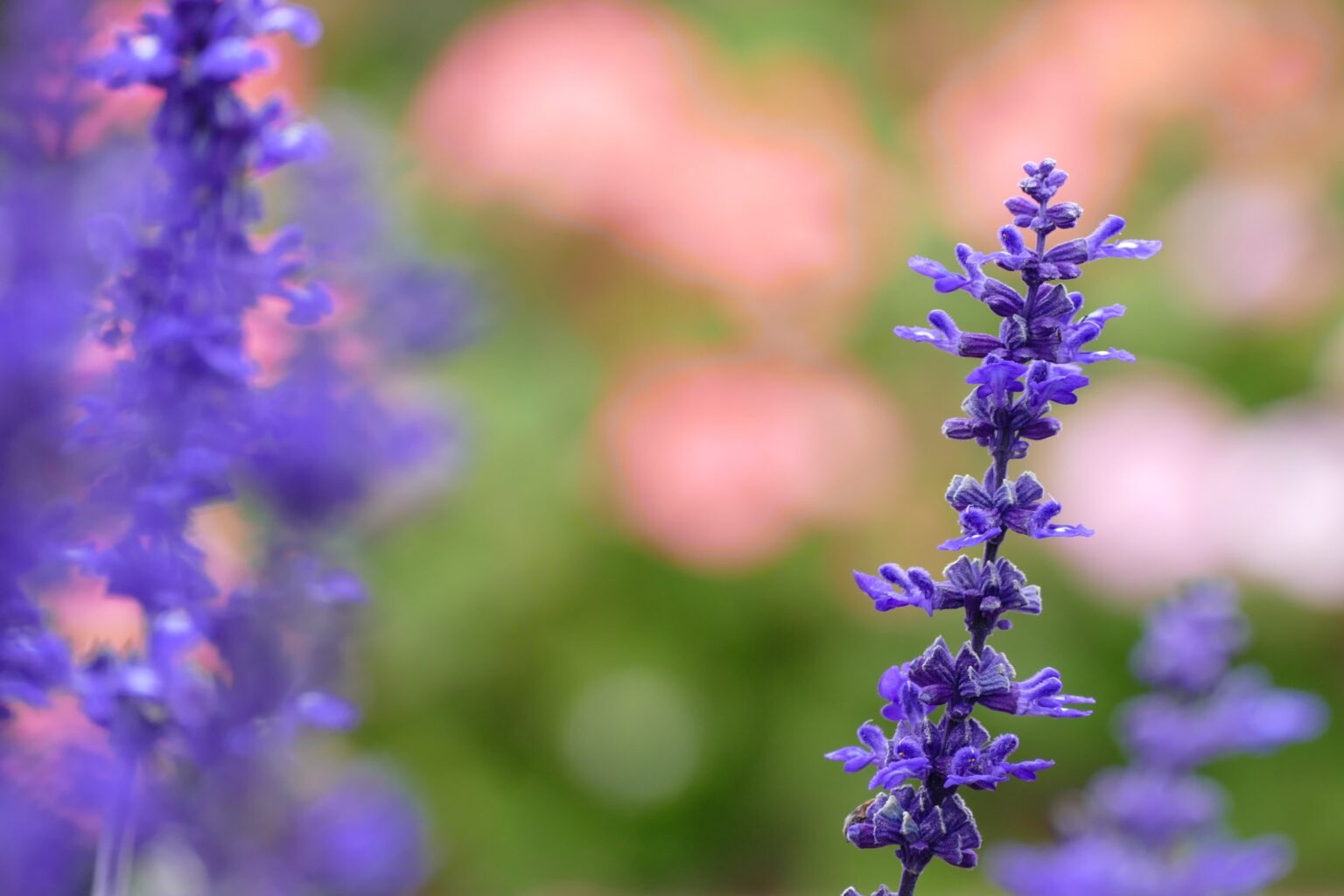
On Thursday March 13, 2020, I returned home from Providence Healthcare, where I have volunteered for 12 years in the Adult Day Programme (ADP), a programme for people who have dementia and are living at home. The following day I received an e-mail informing me that all volunteers were suspended until further notice. When I left Providence Thursday I had no idea that I would not be returning on Tuesday to be with the club members and staff.
I am a Sister of St. Joseph of Toronto, and the Charism of our Community is reconciliation and service of the dear neighbour. It is a challenge for me to accept that loving my neighbour is to stay home, to wash my hands, to wear a mask. In contrast, Our Foundress, Sister Delphine Fontbonne, arrived in Toronto in 1851 with three other Sisters in the midst of the Typhus epidemic and took on the management of an orphanage on Jarvis Street. For these Sisters, loving the dear neighbour meant living with the orphans, establishing schools, planning the House of Providence, which would accommodate hundreds of poor seniors, the sick, and immigrants. Sister Delphine died on February 7, 1856. She had stayed with a woman who was alone and distraught, and she had tended to the sick Sisters in her Community.
Today, of course, I want to be with the club members and staff of the ADP, and I await the day when the COVID-19 pandemic will end. Until such time, in the words of Dr. Ted Dunn, as expressed in his book The Role of Meaning-Making in Transitional Times, I “listen to what life is asking me.” I find purpose and meaning in being aware of the suffering in our world, following the news and world events, entering into committee work carried on with Zoom, sorting and organizing and packing, exercising, praying, gardening, reading, listening to music, crosswording. For this moment in time my life is changed. I believe the change is not forever!
This year our Congregation is celebrating God’s goodness to us for 170 years. It is our prayer that we be healers and show the compassionate face of God to our dear neighbour. March 8 is International Women’s Day and I thank God that I belong to a Community of women—a Community that dates from 1648 in France. I live in the Grace of all the women who spent their lives in service of the dear neighbour without distinction and in fidelity to our call to continue the mission of Jesus “that all may be one”.
Source: Ted Dunn, PhD The Role of Meaning-Making in Transitional Times
Read other InsightOut posts.
John Sampson is a fourth-year PhD Student at the University of St. Michael’s College in the University of Toronto. He is writing on the life and thought of the Chinese theologian T.C. Chao. John can be found at home most days, writing his thesis and drinking only the finest cups of hand-crafted coffee.
In Search of Christian Unity: A Chinese Christian Perspective
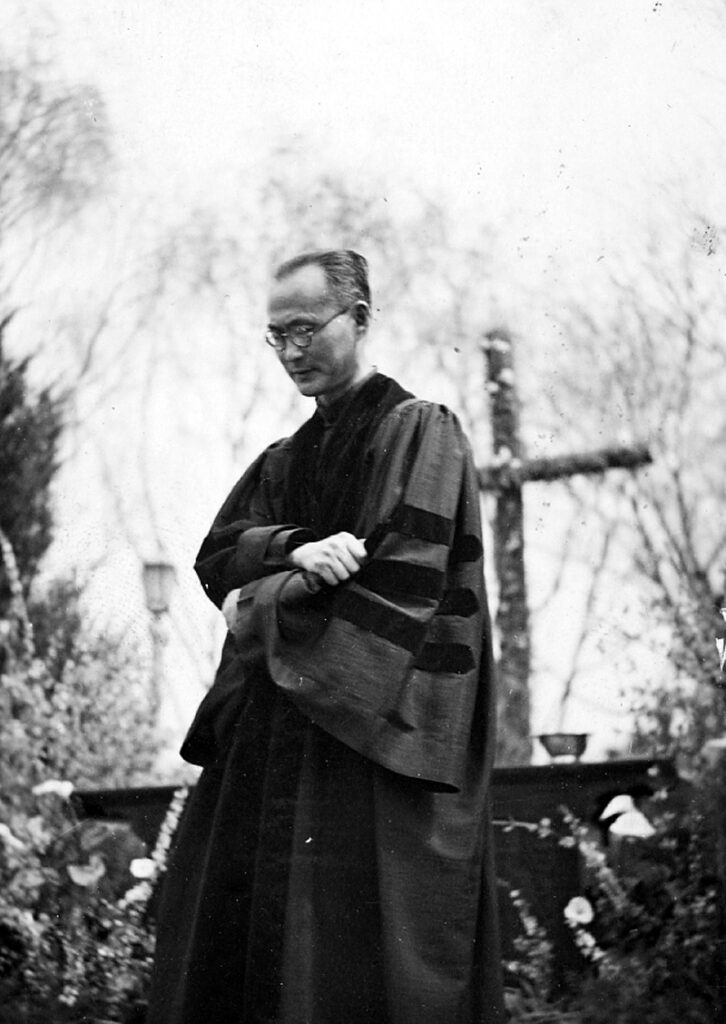
“People must be involved in the work of building up the Church,” wrote T.C. Chao (1888–1979), a famous Chinese Christian theologian and one of the first presidents of the World Council of Churches. “[Christians] do not have the authority to divide arbitrarily, because it is the will of Christ to tear down walls of separation, to split open curtains of division, and create in himself one new person,” he said, alluding to Ephesians 2:14–22. What Chao penned in 1946 has ongoing relevance for Christians around the world today, as we come together during the Week of Prayer for Christian Unity and pray that we may be one “so that the world may believe” (John 17:21). T.C. Chao gave expression to a conviction held by many Christians in the Chinese Republican Era (1912–1949), the period of time when Christianity burst on the scene unlike ever before in China. The conviction was that unity and cooperation were essential if Christianity was to survive, if Christianity was to put down roots in China.
A major obstacle to this pursuit of unity, however, came from the fact that North American and European Christians were trenchantly divided, importing this division into China. Throughout the nineteenth century, foreign mission societies refused to work alongside one another. Catholic and Protestant missionaries remained fixated on their own approaches to Christian faith, on their own doctrinal precepts and ecclesiastical teachings. Protestant denominations produced competing Bible translations and promoted their own translation efforts over and against any other. With few exceptions, Western Christians let divisions that brewed in Europe spill into China, and nurtured these divisions without supplying adequate means for letting a Chinese expression of Christianity take root. This was a deep-seated problem. The desire to preserve Christian practices from one culture (i.e. Europe) stifled the voices of Christians from another culture (China). It stifled the possibility to be enriched by what Chinese Christians themselves had to offer.
In the 20th century things began to change. Many Chinese Protestants criticized the denominational conflict of the Western Church and sought to overcome disunity through the formation of the National Christian Council in 1922. The following year, the Roman Catholic Church convened the first council of the Catholic Church in China, and later consecrated six Chinese bishops in 1926 to allow for greater control over territorial jurisdiction. These practical ways of ensuring that Chinese Christians chart the course for Chinese Christianity were followed by attempts to root Christian identity in a shared Chinese cultural heritage. Just as European Christians turned to Greek philosophers like Aristotle to help advance theological reflection in Middle Ages, Chinese Christians turned to figures like Confucius and Lao Tzu to help shape a unified vision for doing theology in China. The truth of God manifested in classical Chinese learning, argued L.C. Wu 吳雷川 (1870–1944), could be fulfilled in Jesus Christ, who was God’s Way (or Dao 道) made flesh. Just as the moon reflects the light of the sun, so could sages like Confucius reflect the light of Jesus Christ, said Y.J. Zhang 張亦鏡 (1871–1931). Christians could, and indeed, must be sincere about promoting Chinese culture, argued the polymath Roman Catholic theologian P. Joseph Zi 徐宗泽 (1886–1947), who followed the example of the pioneering Jesuit missionary Matteo Ricci (1552–1610). For the first time in history, Chinese Christians shed light on ways of being Christian that were in touch with their own culture. Christian thought and practice were being rooted not in European Christian thought-forms, but in Chinese ones. And unity among Christians of different theological persuasions was beginning to take hold.
But, sadly, throughout the 20th century, crisis and conflict continued to mount in China and sap the strength of a unified Christian effort. The Communist Revolution (1949) collapsed any and all such efforts. The newly established People’s Republic of China restructured all religious practice through official, state-sanctioned Churches, causing the activities of both Catholic and Protestant Christians to become a heavily monitored affair. In our day, with the unprecedented rise of underground house churches and unregistered Christian gatherings, Chinese Christianity has shown that it is not going away any time soon. But Christians now remain painfully divided. As with the Christian division that erupted in St. Cyprian’s day from the Decian persecutions (250 AD), Chinese Christians are divided between those who have joined official, state-sanctioned Churches and those who have refused and faced persecution as a result.
As we think about and pray for Christian unity, we remember that it is not always an easy thing to put into practice, and can indeed cost a great deal. It cannot be imposed, but most flow naturally from the lived-practices of Christians themselves who come from the diverse cultures of the world. Conscious of the things that divided Christians in his day, T.C. Chao saw discord and division in a certain light, in light of the suffering Saviour himself. The divided and broken body of Christ, the Church, sees itself as thus filling up or completing “what is lacking in Christ’s afflictions,” Chao said, citing Colossians 1:24. Christian division is that state of suffering which the Church enters into and remains in until it attains the resurrection. The Church’s bitter hardship amidst discord and brokenness is the way of the cross, a way it can embrace but which, in the end, it hopes to surmount in union with the one, resurrected Christ. This was T.C. Chao’s vision, one which has ongoing relevance for us today as we think about and pray for Christian unity.
Read other InsightOut posts.
Maria Ivaniv is a third-year PhD student at the Faculty of Theology at the University of St. Michael’s College. Her current research, done in conjunction with the Metropolitan Andrey Sheptytsky Institute of Eastern Christian Studies, focuses on the participation of the Ukrainian Greco-Catholic Church at the Second Vatican Council and its reception of the Council in North America. She holds ReMA, MA, and STL degrees in theology and religious studies from the Catholic University of Leuven, Belgium, and MA and STB degrees in theology from the Ukrainian Catholic University. Maria was a lecturer at Three Holy Hierarchs Kyiv Theological Seminary (Kyiv, Ukraine), a teaching assistant in the Theology Department at the Ukrainian Catholic University (Lviv, Ukraine), and served as Secretary of the Patriarchal Commission for the Laity of the Ukrainian Greco-Catholic Church (Lviv, Ukraine).
The Pain of Separation, the Joy of Unity
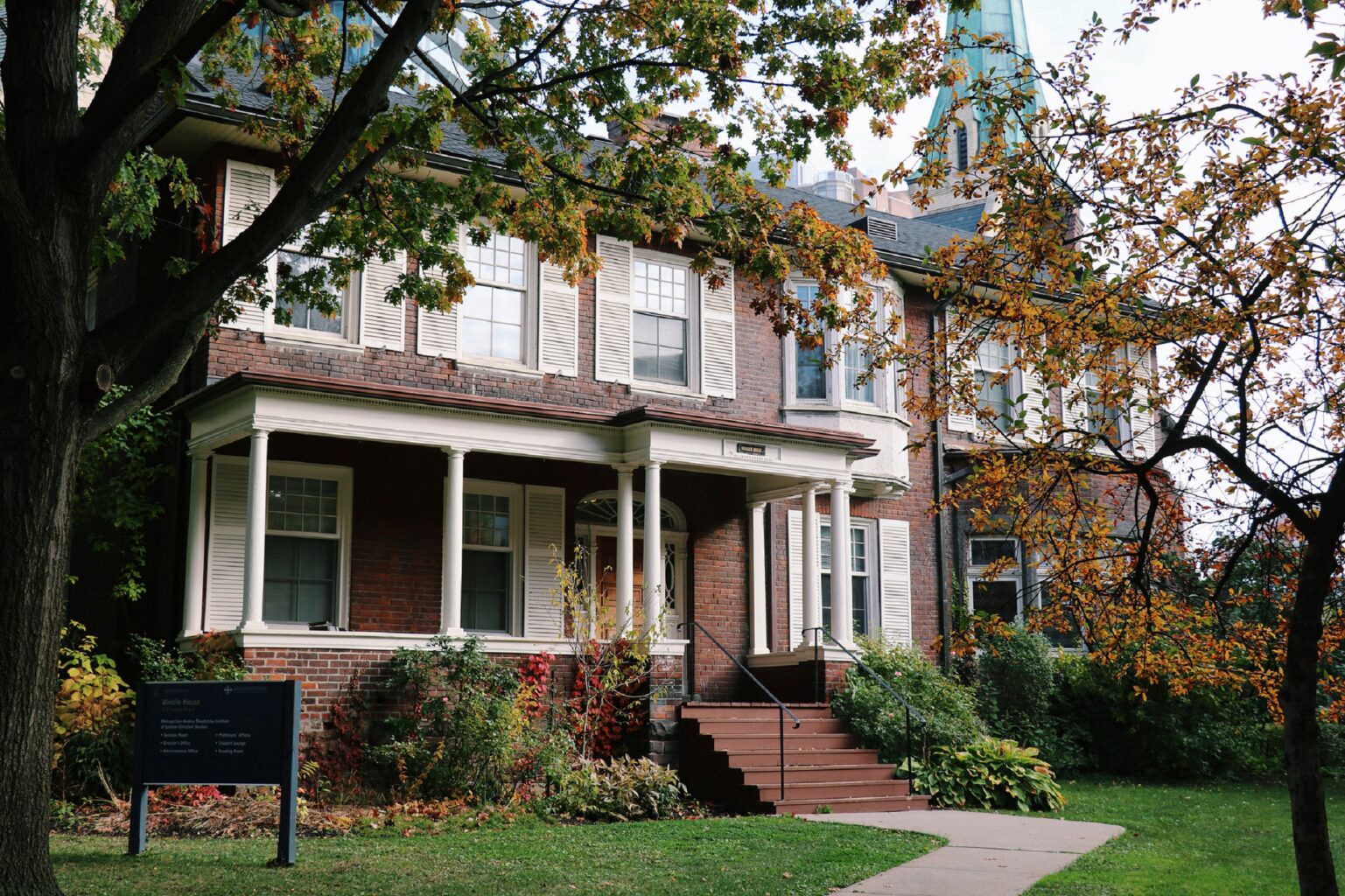
In this time of pandemic and lock-down…we are separated by public and health recommendations, law, and fear for ourselves and our loved ones. In this situation, I desire to be reunited with friends, family, and significant other. I expect that you feel the same way. This pain, which I feel in my heart, reminds me of a time when we could be together and be joyful and content in being together.
This experience can give us a chance to reflect on unity and what it means to be united or to desire unity with others. It can help us think about the question of Church unity, especially during the Week of Prayer for Christian Unity, which for more than a century has occurred every year from January 18–25. In this little blog post I will reflect on the pain of separation, the joy of unity, and my identity as a Ukrainian Greco-Catholic in the midst of these.
I can recall a few moments in my own life when I have felt the pain caused by the separation among Christians. I keep those experiences in my heart as a reason to work for unity. The first time my heart felt the pain of separation was in Amsterdam, where other students and I were attending an ecumenical conference. That was, in fact, one of my first experiences of listening to and speaking with other Christian denominations. It was exciting to see that there are a lot of themes that unite us. As a part of that meeting, we went to a Sunday service in one old and lovely English Reformed Church. There was a wonderful service and sermon. It was the Sunday of the Cross in my Church calendar, and I was happy that the preaching was about the symbol of the Cross and its importance in the Christian life as the sign of our salvation. After that, however, I was disappointed at the absence of the Eucharist in the service, and it brought me some pain. I understood that I could not have received it anyway, but the pain of not seeing the Eucharist—what I understand to be the realization of unity—as part of the Sunday service profoundly pained my heart.
Another experience that brought the pain of separation into focus came during an ecumenical conference a few years ago. The conference was an excellent opportunity for dialogue and sharing about what unites us. Common prayer was part of that conference, and one of the prayer services was a Byzantine Divine Liturgy presided at by an Orthodox priest. It was nice to pray together in one of the ways that I pray in my own parish. But the pain again struck my heart during Communion… Because of the separation, I could not share Eucharist with those who pray in the same way I do. The pain caused by these two experiences of Christian disunity remains. And it creates in me a longing for unity—a unity that heals the wounds among Christians as well as the wound left in my own heart.
Happily, my heart is also marked by other, more joyful experiences. It seems to me that pain alone cannot bring us together—we also need to feel the joy of unity. Studying at the Toronto School of Theology is one of these experiences. Being part of the University of Saint Michael’s College and studying together with other students of different Christian denominations brings me a lot of joy. Also, the presence of the Metropolitan Andrey Sheptytsky Institute of Eastern Christian Studies at Saint Michael’s brings a different voice and many opportunities for the students to experience and learn about other traditions. This experience of common work, studies, prayer, and friendship reveals a lot of differences; at the same time, simply being together unites us.
As I mentioned before, I am a Ukrainian Greco-Catholic. This means that I belong to an Eastern Church of the Byzantine Rite that is in union with Rome. There are 23 Eastern Catholic Churches in the world. Being an Eastern Catholic is beautiful but challenging in some ways. I experience all the beauty of Byzantine prayer, eastern spirituality, and magnificent iconography. I also enjoy all the beauty of the Latin Church, its theology, prayer, and teachings. Living in these two spheres simultaneously gives me the feeling that I see a glimpse of unity among the churches, and I feel the pain of separation and the joy of unity at the same time. But I know there is a long way to go, and all of our efforts are not enough if we do not call on the Holy Spirit to unite all Christians, as He did at Pentecost. Therefore, this Week of Prayer for Christian Unity gives us an excellent opportunity to be together (even if it is virtually), pray, be joyful and ask the Holy Spirit to unite us.
It seems appropriate to finish this little blog post with the words of the Kontakion of Pentecost:
“When the Most High came down and confused the tongues, He parted the nations. When He divided the tongues of fire, He called all to unity; and with one voice we glorify the all-Holy Spirit.”
Read other InsightOut posts.
A tight job market for teachers led Marie Green to chat with a professor she had taken a course with at St. Michael’s Faculty of Theology.
This Saturday, November 14, she will not only be granted her doctorate in theology, she will also be the recipient of the Governor General’s Award for achieving the highest academic standing.
After having completed her Master of Theological Studies degree at Wycliffe College, Green then earned a Master of Science in Adolescent Education at New York’s D’Youville College. But when she returned to Toronto, she learned that high school teaching jobs were hard to find, and she hoped that Dr. Darren Dias might help her brainstorm on how to find a position. She had a calling to teach, and was keen to start.
But the conversation took a turn when Dr. Dias began to speak enthusiastically about a new doctoral degree that was to be offered conjointly with the University of Toronto.
“After two master’s degrees I thought I was done writing essays, but after our conversation I spend the next two months prayerfully considering (the doctorate), while still waiting to find a teaching job.”
Ultimately inspired, she applied to the doctoral program, and began work in 2015. This Saturday, Nov. 14, she will formally become Dr. Marie Green.
Green’s thesis topic, Examining the Experience of Racialized Students in Southern Ontario Catholic Schools, has led her to design a university course she hopes to teach at a later date: Black Lives Matter in the Classroom.
“My topic and search were inspired by my experience in school. I had some great teachers, but I also experienced racism and was stigmatized,” says Green, who was born in Jamaica and moved to Toronto at the age of 13.
“Why can some teachers make all students feel valued and do this so well, while others create a negative climate?” she asks.
It is this question that prompted Green to study the Catholic school system specifically because it offers a faith-based approach that asserts that all students should be viewed with the understanding of Imago Dei, that every person is made in the image and likeness of God. If we embrace that belief, she says, then how do we work in the classroom to ensure that we are treating students with that level of humanity, and doing it evenly?
Partly, the challenge of changing attitudes comes from figuring out how to widen our knowledge base and deal with a culture steeped not necessarily in malevolence but in ignorance, she says. What is key, she adds, is to ensure that lessons offer every child an opportunity to recognize him/herself in the lessons being taught.
If Green sounds passionate about teaching, she says she learned a great deal from the professors and community she encountered while at the Faculty.
“The professors clearly have a passion for teaching, which comes from loving what you’re doing. That leads you to want to see students strive for their best,” she says.
She says she made lifelong friends at the Faculty, and credits time on both the Faculty’s Student Life Committee as well as her time serving as the Vice President, External on the TST Graduate Students’ Association as a wonderful way to build a supportive community and, in time, to mentor younger students.
“In real estate they use the old term ‘location, location, location’ but in academia it’s ‘relationships, relationships, relationships’” she says, noting that the friends you make and the people you meet can help in everything from getting support in doing research to finding outside connections.
Marie is currently teaching computer skills in the corporate world, and when people she encounters find out her educational background they are often puzzled, but she says there’s a clear link.
“As philosopher Jacques Maritain and educator Paulo Freire advised teachers, if you can see others’ humanity, you can nurture the knowledge that already exists inside of them. Theology is at the base of so much. It really helps everyone.”
Visit the Faculty of Theology’s Fall Convocation 2020 page to learn more about this year’s graduates and to celebrate their unique achievement.
Douglas Day Kaufman, who will be granted his Master of Theology degree on Saturday, November 14, was drawn to study at St. Michael’s Faculty of Theology because his interest in ecotheology.
“I came because of The Elliott Allen Institute for Theology and Ecology (EAITE) as a way to have a deeper understanding for articulating a Christian approach to environmentalism,” Kaufman says. “When I met Dr. Dennis Patrick O’Hara, I knew he would be an excellent guide for me and so he proved to be.”
As he reflects on his time at the Faculty, several things resonate: the weekly worship, the diverse community, the beautiful University of Toronto campus with its multiple libraries and the opportunity to grab a fast bite, often from another culture’s cuisine.
When asked what he will take away from his studies, he cites a quote from Thomas Berry, whose work in ecotheologian who inspired the EAITE: “ ‘We must say of the universe that it is a communion of subjects, not a collection of objects.’ I experience that communion and community in my daily walks in the woods near my home, and that helps empower my ongoing activism for the sake of creation.”
Now, Kaufman looks forward to employing what he has learned in his role as Director of Pastoral Ecology at the Center for Sustainable Climate Solutions, a partnership in Goshen, Indiana, encouraging Anabaptists/Mennonites to see climate change as the moral equivalent of war. A pastor himself, at Benton Mennonite Church in Goshen, he lead retreats at the centre on climate change for Anabaptist pastors and leaders.
“ I consider it a privilege to have been part of an elite institution like the University of Toronto and St. Mike’s,” he says. “There are so many resources and yet it did not feel elite to me. The library staff, for example, was so amazing to graduate students. I treasure my time there.”
Visit the Faculty of Theology’s Fall Convocation 2020 page to learn more about this year’s graduates and to celebrate their unique achievement.
“The University of St. Michael’s College Faculty of Theology serves the Church by educating and forming its sons and daughters, and I am proud to call myself an alumnus of this Faculty,” says Hugo Tang, who will be granted a Master of Theological Studies degree on Saturday, November 14.
Tang says he wondered whether he was making the right choice when he decided to enrol, wondering whether the Faculty might be “too liberal” and fearing “that I was not capable of such mature and high-level discussion, given my relative youth and inexperience.
“I noticed, however, a spirit of fraternity combined with academic rigour which attracted me to apply to the Faculty,” he says, and that feeling was supported by the recommendations of several members of his parish who had graduated from St. Mike’s.
When he started classes he was encouraged by the academic rigour, combined with a sense of community and a small yet diverse student body.
“The diversity of the student body produced some interesting and fruitful “theologizing” in class and beyond,” he recalls. Whether lay or religious, fresh graduates or mature students, each brought a new and unique perspective to the table. Being a bit of a nerd for theology, and warmly welcomed by all, I soon felt at home amidst the other students and faculty.”
As St. Mike’s is one of the seven member colleges of the Toronto School of Theology, Tang had the chance to meet students from other colleges, including the two other Catholic schools — Regis College and St. Augustine’ Seminary.
“In our classes, I witnessed that it’s alright for people to disagree. People can (and should) co-exist fraternally even if they hold different opinions,” he says. “We should, however, be ready and willing to challenge and support our opinions and beliefs with arguments, facts, and references to source documents. I think as a society today, we have too often lost the ability to agree to disagree, that we put up walls around us. Rather than fulfilling us, these walls suffocate us and darken our world.”
Reflecting on his time at the Faculty of Theology, he says, humbly, of his Master of Theological Studies degree, “The degree is a bit of a misnomer: I am not a ‘master’ at theology. I have not and will never master theology, for theology is the study of God, God who is omnipotent, omniscient, and omnipresent. I truly believe that everyone is a theologian, because each one of us, whether intentionally or not, is seeking God in his or her own way, through the pursuit of all that is good, true, and beautiful.”
Hugo says his studies have given him the framework and vocabulary to allow him to continue to grow. He says among the skills he has gained are an enhanced ability to argue a point, the ability to express himself and speak for an extended period of time, and writing lengthy papers.
“Everyone should study theology— maybe not a full master’s degree, but at least a few courses. Catholics, myself included, are largely under-catechized. I did not realize this until I began this degree. Given that our faith is more and more countercultural, we need well-formed disciples to live and preach the Gospel in the world. We need to do more than simply memorize the faith but make it our own through reason.”
Visit the Faculty of Theology’s Fall Convocation 2020 page to learn more about this year’s graduates and to celebrate their unique achievement.
“I was drawn to study at St. Michael’s Faculty of Theology because of the reputation of the institution,” says Tina-Marie Lockyer, who will be granted her Master of Religious Education degree on Saturday, November 14. “I wanted to learn more about my Catholic faith, and I felt that St. Mike’s was a good fit for me. “
One of the things that really struck Tina-Marie as a student was how small the faculty actually feels.
“The University of Toronto is a world-class university and thousands of people are there every day. Somehow when you enter St. Mike’s you feel as though you are part of a family that cares for each other. Even as a part-time student, I always felt as if I was an important member of the school.”
Another thing she appreciates about St. Mike’s is that while it is Catholic-centred, “there is a communion with other faiths and institutions in the Toronto School of Theology, and we are always open and willing to learn and understand others through dialogue.”
When people ask TIna-Marie what is involved in earning a theology degree, she says she tells them it is “a lot of hard work, but I loved every minute of it: the readings, the writing and the friendships made me a more well-rounded person with a strong Catholic faith. The professors and support staff at USMC made all the difference in my program. It was so wonderful to walk the halls and have professors actually know me by name. Also, the relationship a grad student has with the library is important, and at St. Mike’s we literally have anything we need from the library at our fingertips. It is extremely helpful.”
But the main lesson Tina-Marie says she will forward is that her is that “we are meant to be with Christ. Decisions you make should be a part of who you are, and that has to involve Christ. If you endeavour to have a relationship with Christ you will always achieve love, moral decisions and justice, because that is what Christ calls us to do, and we want to please Him because we love Him.”
Lockyer chose the MRE for personal enrichment and faith development.
“My degree will also support my work in my parish and pastoral care at the hospital,” she notes. “As a religious educator, this degree will allow me to expand my leadership potential.”
While she enjoyed her time at the faculty. one of the highlights was the opportunity to study in Israel at Bat Kol, a centre of Jewish studies for Christians using Jewish sources.
“It was an experience that I will always remember fondly,” she recalls. “I learned so much about Judaism and it deepened the understanding of my faith. Being in the places where Jesus and the Apostles walked, and having access to special places because we were Bat Kol students, is something I will be forever grateful for.”
And lest anyone think this is good-bye, a final note: “I do not actually want to leave USMC,” she says, “and am considering coming back for another Master’s degree in the future….”
Visit the Faculty of Theology’s Fall Convocation 2020 page to learn more about this year’s graduates and to celebrate their unique achievement.
For Minnesotan John Solheid, it was the Faculty of Theology’s reputation that drew him to study at the University to St. Michael’s College. Add in the size and resources of the John M. Kelly Library, as well as a “generous financial package” and he was sold.
This Saturday, November 14, he will be granted his doctorate, officially becoming Dr. John Solheid, with his thesis entitled The World in the City: Biblical Scholarship and Reading Culture in Origen’s Psalm Homilies from the Codex Monancensis Graecus 314.
“I was immediately impressed with how welcomed the faculty made me feel,” he recalls. They helped me …acclimate to Canada, to Toronto, and to campus. I never felt out of place or as if I didn’t belong.
“St. Mike’s is a wonderful place to learn and develop personally and spiritually. There is a very collegial atmosphere at St. Michael’s. It is ideal for anyone who want to be part of a scholarly community.”
Solheid, whose goal is an academic career as a professor and scholar, says one of the key lessons he learned while at St. Mike’s was a sense of responsibility to participate in the broader scholarly community, doing such things as attending lectures and presentations from peers, even when the subjects aren’t related to his own research.
“I always appreciate how much I learned from those presentations and lectures, and especially those whose subject matter was not related to my field.”
An added bonus? “I made some friendships that will last a lifetime.”
Visit the Faculty of Theology’s Fall Convocation 2020 page to learn more about this year’s graduates and to celebrate their unique achievement.
When Josefine Nobel first pondered theological studies, a friend put her in touch with a graduate of the Faculty of Theology whose assessment of the school prompted her to apply and enrol.
“I have always felt like I am home here, and especially when sitting and engaging with my peers and faculty,” says Noble, who will be granted a Master of Divinity degree on Saturday, November 14. “This sense of community is often cemented with events arranged by the Student Life Committee, the liturgies, the extra-curricular outings such as the Ordinandi Dinner and events put on by the Toronto School of Theology as a whole.”
That sense of community, she says, made her entire experience transformative.
“At first, I did feel that my faith—and all I had thought I knew about the Church and God— was being challenged, I also learned that faith is able to be challenged! In fact, it grows stronger! Somehow, as my old frameworks of meaning were challenged, I begin to stretch the ‘envelope’ of my faith and this did not diminish it rather it enriched it.”
Because of this, she says, she feels she has been transformed on many levels—spiritual, personal, and intellectual— “and I know that I have also become a better human being and a Christian.”
Another huge lesson for Noble at Saint Michael’s has been the lesson of community, she says.
“I have often chosen to work alone and have not been so drawn to communities and group events. I worked in my church behind the scenes and thought that I preferred that. Saint Michael’s changed me. I have become aware that there is richness to be found in community and this is a very large part of what enhances one’s faith and faith walk. I boldly offer then that any who desire their educational experience to be further enriched by the power of community will be sure to find it attending Saint Michael’s.”
Today, Josefine has begun work on a Master of Theology degree, continuing onward to see where her education takes her.
“I am honored and blessed to be a part of Saint Michael’s and I hope to continue to grow here in fellowship, friendship and faith.”
Visit the Faculty of Theology’s Fall Convocation 2020 page to learn more about this year’s graduates and to celebrate their unique achievement.
Nick Cotman did his undergraduate studies in philosophy and political science at the University of Ottawa. He then completed his Master of Theological Studies at St. Michael’s Faculty of Theology in 2019. It was at this time that he began working in the chaplaincy leader position at his alma matter, Holy Cross Catholic Secondary School in Kingston, ON.
Encountering Opportunity in Restriction
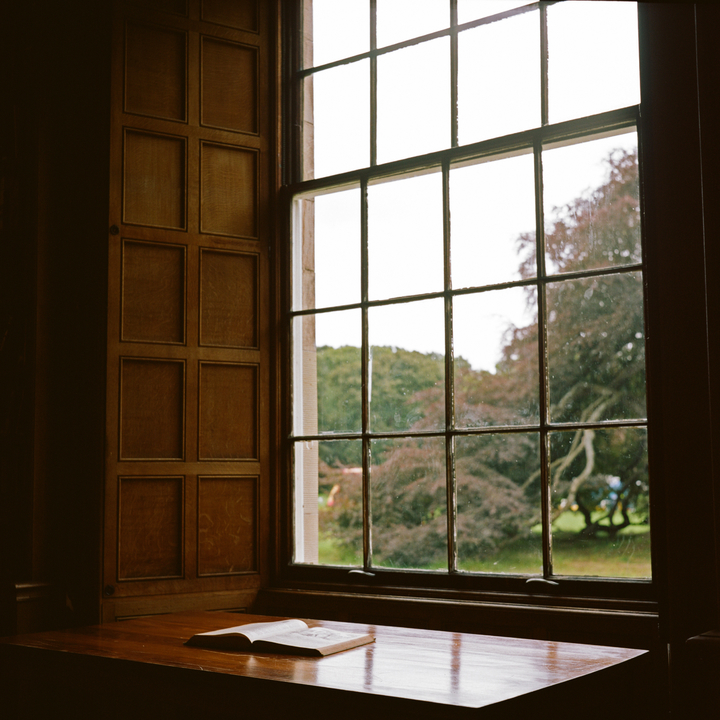
As we have come to expect from most things in 2020, public education in Ontario’s schools looks a little different from most years. In Kingston, secondary schools are following an octomester model, meaning that there is one class each day for 22 straight days. Lunch periods are staggered for each grade in an effort to avoid congestion around the school. Additionally, teachers are livestreaming their lessons to ensure remote learners are getting the needed material. All of these adjustments have required a significant mental and pedagogical reorientation from staff and students. Having only begun my high school chaplaincy career in the fall of 2019, and being out of the school by this past March, these first months back have felt more like the second volume of my first year as I relearn the role.
Being (physically) back in school has affirmed something I had been reflecting on since COVID first began to reshape our daily lives: that a single thing can be both restrictive and freeing. The colleagues and students I have the privilege of spending time with each day are showing me there are unexpected opportunities to be found in the constraints we are currently navigating. I think it is important to note, however, that any “pleasant surprises” we encounter in no way diminish or undermine the unique challenges each of us has faced. Nonetheless, we should acknowledge that by being forced to reconsider the way we approach many things, 2020 has also shed light on the shortcomings of previous practices and provoked new, more effective methods. Being in school has made this especially clear to me.
There are a few experiences I’d like to recount. The first is one which is bound up closely with my position in the school: the absence of school Masses. This has forced a significant shift in focus to other liturgical practices. I have been doing regular class visits to lead lectio divina readings and the Ignatian Daily Examen with students. Although we will be thankful when the day comes that we can celebrate Mass as an entire community, this unplanned hiatus has led me to recognize the richness of these other liturgical approaches. Mass in school was always an appreciated community event, but it was evident that further foundational efforts in spirituality and liturgical understanding would enrich the experience. The event of a school Mass may have become overly familiar, causing a lack of deliberate and reflective participation. J.R.R. Tolkien wrote that we often need “to clean our windows; so that the things seen clearly may be freed from the drab blur or triteness of familiarity.” This break may inadvertently serve as opportunity to form our liturgical sensibilities as a community through other practices, allowing us “to clean our windows,” and more fully appreciate Mass when we can gather once more as an entire community.
Another example that is small but noteworthy is the new inclusion of an end-of-day prayer. Prior to current circumstances, we would recite a simple grace over the PA before lunch. Now, however, with each grade now getting out of class at different times, this was ruled out to avoid further interruptions. In the absence of a lunch hour prayer, we decided to begin doing a prayer at the end of the school day. This small change has been incredibly well received. We join in a meaningful prayer to give a definitive conclusion to the school day and to look forward to the evening ahead. This is a practice we will likely carry forward beyond these unusual circumstances, though we may have been unprompted to explore it without the current conditions.
Without Masses, retreats, or community outreach to coordinate, my priorities within the school have shifted. More than ever, it seems that chats in the staff room and chance encounters with students in the halls are of greater pastoral importance. When there was more room to complete tasks and plan outreach events, I began to let behind-the-scene to-do lists take the front seat. I’m thankful I’ve been required to shift my focus to relationships within the school. When things return to normal, I’ll be sure to maintain this focus.
There are an array of other instances I could talk about, such as our amended graduation ceremony, virtual coffee houses, and the music class using the cafetorium so as to social distance more effectively (allowing halls throughout the school to enjoy their practice). Students seem more open to seek me out to chat (though perhaps they just want out of class since they’re now in the same room all day!) and are displaying impressive consciousness of the well-being of those around them. They are dutiful in mask wearing, have embraced the octomester model, and even surpassed any previous food drives during our Thanksgiving collection.
These are all just small instances of the pleasant surprises I’ve seen over the past months. We have all encountered them in different ways, but I am especially thankful to see them occurring in Catholic education through the lens of chaplaincy. When we learn to embrace unanticipated circumstances, we can open ourselves up to viewing things in new ways and create room for God’s grace in areas we might lack control. In the chaplaincy work ahead, I’ll be sure to continue looking for the pleasant surprises and opportunities for growth that our current restrictions can bring.
Read other InsightOut posts.
John Fraresso is completing his Master of Theological Studies degree at St. Michael’s Faculty of Theology. He completed his undergrad at UTM in the 90’s in Crime & Deviance and Sociology. He currently serves as the Community & Spiritual Life Coordinator for the community of L’Arche Hamilton.
God Keeps Laughing as I Make Plans
If you really want to make God laugh, tell God your plans.
Sometimes God taps you on the shoulder, other times God throws a brick at your head.
Add to these—paraphrasing Gary Zukav— in order to be authentic, your personality must serve the will of your soul, and you get a glimpse into my journey of returning to school in my mid 40s. They actually define my life story, but that’s a book and not a blog.
From the time I was a young boy, I always felt called to be in service to others. If the call to have children wasn’t so strong within me, the call to priesthood might very well have won out in my teens. I listened to that call to have children and was blessed with three beautiful kids. Since they were (and are) my highest calling, I launched into corporate life in my 20s and had a highly successful career. Though it was gut-wrenching in many ways, it served my kids well by providing a very comfortable life for them. On the other side of this coin, making millions more in sales and margin dollars for a multi-billion dollar company did nothing to serve the least of my brothers and sisters, nor my soul’s calling.
About five years ago, I was discarded like yesterday’s news by the company I had poured my life and soul into. That monumental event—which at the time seemed devastating—set me on an incredible journey up to this day, a journey that continues to unfold. What is evident in it, though, is that the will of my soul is getting the upper hand, as my personality is listening to it a lot more than it used to. God keeps laughing as I make plans. Sometimes God taps me on the shoulder and I listen; more often than not God has to throw a brick at my stubborn head.
Richard Rohr wrote an entire book, Falling Upward, on what happens when we hit mid-life as we start to reassess our values and where we’re heading. Circumstances started to line up for me to follow my dream of returning to school so that I could follow a vocation to be in service to others—which, you will note, sounds entirely different from a “career change.” I enrolled in St. Mike’s Faculty of Theology to do a Master of Theological Studies degree.
Many people have said to me, “Wow, that’s quite a change. What made you decide to go in that direction?” My answer is always that it wasn’t a “change” per se; it is simply a matter of honouring what has always been deeply seeded in my DNA, the will of my soul.
I decided to do the “responsible thing” and continue to work full-time so I could make money while doing school part-time. I didn’t really need to; my financial situation had allowed me to go full-time, but I didn’t listen. Result? The new company I was working for shut their operations down. God. Brick. Head. I listened, and dedicated to school full-time.
I decided to do a field placement in my degree. My professor suggested, after a period of discernment and discussion, that I do my placement at L’Arche. Turns out—and he was bang on—that someone like me, so stuck in my head, could learn a lot from people who live from their hearts. In the ten months I have been at L’Arche I have learned more than my entire education, going all the way back to junior kindergarten.
Yet even in this journey of the past few months, I continued to make decisions with my head and didn’t listen to my heart. Put another way, my personality wasn’t serving the will of my soul. God showed up again, brick in hand. L’Arche had to remove all volunteers from their homes when COVID struck, including me. A week later, they offered me a relief assistant position. I struggled with taking it, because my head told me that perhaps I should find something full-time for the summer (a nice cerebral decision that didn’t consult my heart). My heart eventually won out, and in no time I was getting more hours at L’Arche. Fast forward a couple of months, and the person who was my supervisor at L’Arche—their Community and Spiritual Life Coordinator—was retiring, and they needed someone to fill the position.
Guess what I’m doing now! Of course, as a result of listening to my heart, it all works out well with my studies: I can balance both this position and my studies. Though it is highly regretful that classes aren’t in person—I didn’t return to school after 20+ years to do it online—the fact that they are virtual, and that I don’t need to commute from Burlington to Toronto for classes, allowed me to take this service position at L’Arche.
This is literally a microcosm, a small sample, of the incredible events that have conspired to allow for this to come to fruition. My super-stubborn self has learned (more accurately, is still learning) the valuable lesson that you can’t stand in the way of the will of your soul. I guess with more brazen effort and deafness one could. I am sure many do. I know I have. But when you surrender even just a little, gain a little humility, ask God to guide you, simply go with the flow, and let go of the wheel so that The One with a better driving record can take it, miracles happen.
Again a couple weeks ago as my head was trying to run the show, God sent another messenger to remind me. Without even knowing I needed to hear it, she shared Proverbs 3:5-6 with me: “Trust in the Lord with all your heart, and do not rely on your own insight. In all your ways acknowledge Him, and he will make straight your paths.”
Thankfully I noticed this subtle tap from God, gave control back to God, and saved myself another brick to the head.
Read other InsightOut posts.
Nick Olkovich is an Assistant Professor and holds the Marie Anne Blondin Chair in Catholic Theology at St. Mark’s College in Vancouver. He completed three of his four degrees at the University of St. Michael’s College where he met his wonderful partner Julia, a graduate of Christianity and Culture and the Faculty of Theology, in a course exploring the thought of Bernard Lonergan.
Nick and Julia’s Victory Garden
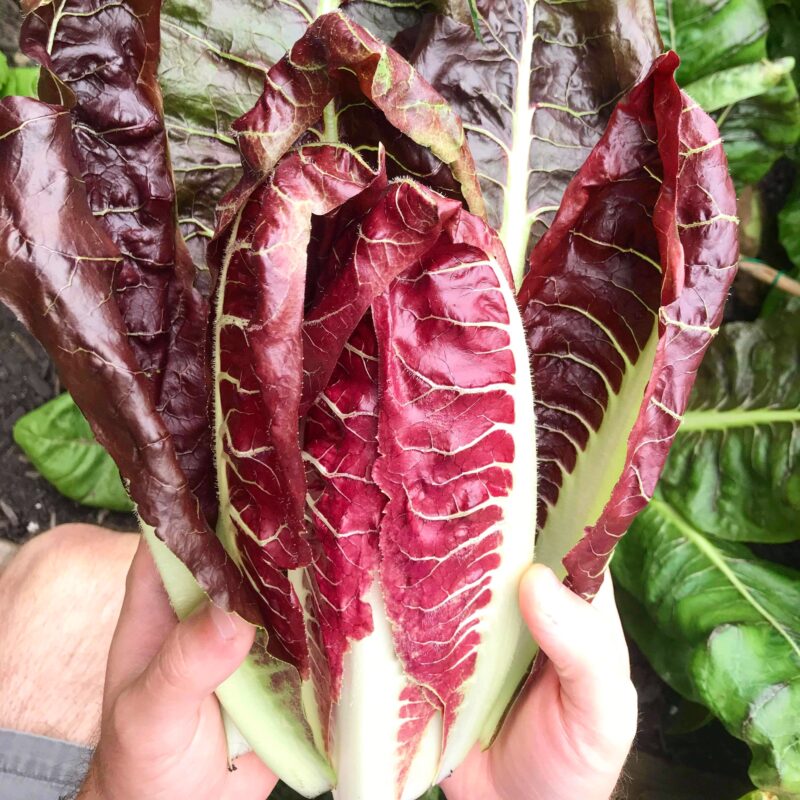
I’m sitting in my living room looking at what’s likely to be the last tomato from the small garden we planted at St. Mark’s College here in Vancouver. Shortly after everything shut down on March 16, 2020—and well before the ground was ready in Toronto—Julia and I found ourselves sowing seeds—two types of lettuce, arugula, radicchio and puntarelle—and planting tomato, eggplant, pepper and cucumber seedlings.
Anxiously awaiting signs of germination and growth, we’d close our laptops around 5 p.m. every second day and drive up to the College to check on our pandemic garden. Slowly but surely our seeds sprouted and their shoots began to look like miniature versions of themselves. Within weeks we were eating arugula while Toronto was still under a pile of snow. Yet, our tomatoes had barely grown; the cucumber seedlings kept dying; and I was convinced that my pepper plants were shrinking. I was frustrated. Anxiety over the pandemic combined with the pressure to work harder and accomplish more. I was hard on myself like I was hard on the garden.
As the lockdown wore on, workdays and then weeks began to blur into one another and yet time stood still in a different way when we’d call it quits, earlier and gradually with much less guilt, and head up to the College. We’d go when we were miserable or angry with each other. It was quiet and it helped. We’d go on the weekends sometimes when the sun was shining and it helped even more. Julia needed her steps and so we’d walk after pulling weeds and talk in ways that our pre-pandemic weekdays never seemed to allow.
As time went on our near daily trips became routine. We’d pack our tomato ties, our scissors, and big ziplock bags that I’d wash after each use. Soon we lost access to a hose and so we started bringing a watering can that one of us would fill six or seven times behind St. Mark’s Parish whenever Fr. Rob wasn’t hearing outdoor confessions. As summer finally started to arrive in Vancouver the garden became a hot spot of activity. We met neighbours who told us they liked our greens (thanks?); neighbours we traded stories and plants with; other gardeners on the UBC campus who envied the shade our lettuce got; neighbours’ children and their pets. I began running into work colleagues, one who tended two of the College’s four garden beds, and others who still had access to the main building. These chance encounters and the short conversations they prompted—so everyday and yet so oddly meaningful—broke up the monotony of daily Zoom calls and online happy hours. Soon enough the garden started to produce and everyone we ran into or visited got a bag of lettuce or clippings of chard. What had started out as a pet project had become a way to connect.
In the end, not everything worked out. The eggplant and peppers never grew. Most of the tomatoes will never ripen. But over time my frustration with the garden turned to acceptance and then celebration. Look at all the delicious things we got out of two overcrowded and partly shaded boxes. Over time I’ve grown to be easier on myself and to celebrate all the little ways Julia and I have grown over the past six months. None of it was expected. None of it was easy. All of it was grace.
Read other InsightOut posts.
“The whole is greater than the part, but it is also greater than the sum of its parts.” (Pope Francis, encyclical Fratelli Tutti (3 October 2020), # 145.
We write to inform our communities that representatives of the Board of Regis College, and the Collegium of the University of St. Michael’s College, have met recently to explore a mutual desire to renew long-standing discussions regarding a closer institutional relationship between the two Catholic institutions.
We are pleased to report that these very fruitful meetings have led to the establishment of a Steering Committee that will oversee, on behalf of the two governing bodies, the formulation of an alliance between Regis and St. Michael’s. The work of the Regis-USMC Steering Committee and its anticipated sub-committees, and the deliberations of the respective governing bodies, will be guided by the following shared principles:
- The commitment to forge a world-class centre of excellence in Catholic theological study whose mission is to promote teaching, research, and formation to serve the needs of the Church and society, here in Canada and globally;
- The commitment to consult all stakeholders (including the administration, the faculty, staff, students and alumni/ae, of each institution, as well as the sponsoring religious orders/ congregations). The continuation and cultivation of a cordial relationship with the Archdiocese, while keeping the Cardinal informed of plans and on-going developments;
- The commitment to orient governance of Regis and St. Michael’s to a deepening union for the sake of enhancement of their mission.

David Sylvester, PhD
President and Vice-Chancellor
University of St. Michael’s College

Thomas Worcester, S.J., PhD
President
Regis College
Nisheeta Menon is a graduate of St. Michael’s Christianity & Culture program and holds a Master of Divinity degree from the Faculty of Theology. While studying theology she served as the Social Justice Co-ordinator and Student Life Committee Vice-President. She is now a high school Religion teacher in Mississauga, where she hopes to continue her co-curricular work serving her school community in the areas of equity and diversity education and chaplaincy.
Wandering in the Desert
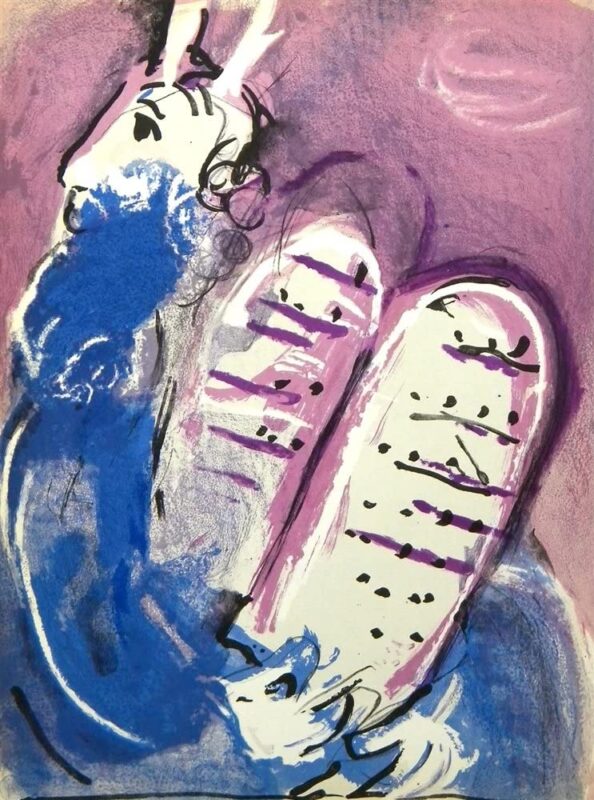
Autumn is a time of year I have always loved. As a student, I looked forward to transitioning back into school and the start-up of all of the clubs, sports, and activities. Now, as a secondary school teacher, my appreciation of this time of year has only increased. It is around this time that the life of a school starts to take shape—student leadership, chaplaincy, athletic teams, volunteer and outreach initiatives, arts programs, etc. Plans turn into reality and the school begins buzzing with activity, creativity, and life!
This autumn, as you might imagine, looks very different. The beginning of the school year was tumultuous, to say the least, and some of us only received our teaching assignments in late September. A number of teachers, like me, were designated to teach the online cohort and, with that, we have sunk into the routines of virtual teaching with considerable reluctance.
Students continue to be moved in and out of our courses due to a host of scheduling issues while the quadmester is rapidly progressing toward its end date in the second week of November. The tight timeline forces teachers to compress the curriculum, either speeding through important concepts or eliminating them entirely. The students “attend” class daily but are behind their screens while we are behind ours, and, even when our cameras are on, there is a palpable discomfort.
In a regular classroom, these students would know each other quite well by Grade 12, and they would continue to build connections with one another throughout their time in a class like mine. In the virtual environment, however, students in my classes are from all over the school board and, despite my efforts, their interaction is limited. As well, during the average school day, my colleagues generally remain isolated in their own classrooms (for good reason), leaving the staff lounge and department offices empty. The school is eerily quiet and the few faces you may pass are hidden behind masks. This is a far cry from the Thanksgiving liturgies, staff potlucks, and Student Council Haunted House tours of the past.
For most teachers, even those with in-class cohorts, the laments are the same: feeling disconnected from the students, being unable to teach and assess in an effective way, concern over students with access issues or learning challenges, and a general lack of guidance and support. At the same time, we watch the news as reports of COVID-19 cases in schools rise and we check in with some of our close friends and family as they await the results of their tests. We miss the loved ones who are outside of our social bubbles, and we worry about them, and ourselves. It is difficult to be hopeful.
One day, as I discussed these grim realities with a colleague, I confessed I was having a difficult time staying optimistic and energized, but that I was simultaneously feeling guilty about this because I also acknowledge how privileged I am in many ways. She offered one of the most helpful comments I have heard throughout this pandemic: “Of course you’re having trouble staying hopeful! What do you expect? We are the Israelites in the desert! This is not the Promised Land!”
Coincidentally, it was at that very time that I was in the midst of discussing the Exodus story with my Grade 12 Religion class. We had talked about how the Israelites in the desert must have felt a sense of hopelessness, fatigue, monotony, and an underlying fear that they might never actually reach the Promised Land. It is difficult to imagine that they ever woke up optimistic and chipper, ready to spend another day wandering in the desert!
During this pandemic, part of the struggle which so many of us put ourselves through is trying to make our lives as close to what they were pre-pandemic as possible. Of course, this is nearly impossible, and our failure to meet our self-imposed standards only heightens our anxiety. By acknowledging that we are “in the desert,” perhaps we can give ourselves permission to feel a little lost, at times hopeless, and generally unable to think more than a few steps ahead at any given time.
My most gratifying class thus far occurred when I shelved the curriculum for one day and chatted with the students about how I was feeling. As a teacher, and one of the only adult influences outside of their home they have regular access to right now, I know that modelling for my students the fact that it is okay to be struggling is perhaps the most important lesson that I can offer. After sharing with them a little about what was weighing on me, my students quickly piped in with words of validation and encouragement, which led to other students sharing their particular burdens, which in turn led to more encouragement from the group. Despite the distance between us and the glitchy internet connection, our discussion rolled on until the end of the period. There was laughter, exclamations of, “Oh my gosh! Me too!” and quiet, muffled sniffles at times. We never got around to our lesson on the Book of Exodus that day, and yet I am certain that we came to a better understanding of how the Israelites were able to survive—and find deep meaning in—their time in the desert together.
Read other InsightOut posts.
Rev. Dr. Matthew Durham is a Roman Catholic priest and experienced hospice palliative care administrator. An alumnus, Fr. Matthew earned an MDiv and a DMin at the Faculty of Theology, and is currently the Executive Director, Hospice Palliative Care and Community Development for SE Health. Formerly, he was the Director of Community Engagement & Advancement at The Hospice of Windsor & Essex County Inc. This article was co-authored with Hana Irving, MA.
Helping the Most Vulnerable at the End of Life
While discussions of how to create a system that supports Canadians who wish to live and age at home have been at the forefront of health care agendas for decades, this discussion has only become more necessary in the midst of the COVID-19 pandemic. Discussions of viral spread, social and physical distancing, the importance of wearing a mask, washing hands, and disinfecting surfaces to prevent infection have become commonplace in households nationwide. At the same time, as a society, we are becoming more aware of the social and economic disparities that have put certain vulnerable populations at greater risk.
Ubiquitous yet largely ignored, in every major city there are thousands of Canadians who are homeless and lacking access to adequate resources to follow public health guidelines about social distancing and hygiene (Jadidzadeh & Kneebone, 2020). Furthermore, people experiencing homelessness are often at greater risk for virus transmission due to crowded living conditions in temporary housing or shelters, or congregate settings, and overall face a 5–10 times greater mortality risk than the general population (Tsai & Wilson, 2020). Those risks only increase for individuals with compromised immune systems or who may be approaching the end of life.
For people experiencing homelessness, access to palliative care has traditionally been a challenge, which has only been exacerbated by the COVID-19 pandemic. Hudson, Shulman and Stone (2017) note that
the delivery of high-quality care in mainstream settings for homeless people is complex for many reasons, including mistrust of health services, isolation, the impact and chaos associated with substance or alcohol misuse and, for some, alcohol-related early cognitive impairment. These factors, alongside the relatively young age at which homeless people may benefit from palliative care, means access to hospice and care homes is currently rare. As a result, homeless people often receive inadequate care and support. (p. 54)
This is a problem that Journey Home Hospice has been addressing for a little more than two years as Toronto’s only hospice serving homeless and vulnerably housed individuals. The hospice, which is a partnership involving Saint Elizabeth Foundation, Hospice Toronto, and Inner City Health Associates, provides 24/7 hospice palliative care, including complementary therapies to patients at the end of their lives, with a typical admission having a prognosis of approximately three months. More than pain and symptom management, Journey Home Hospice also offers formerly homeless patients the opportunity to experience “home,” sometimes for the first time in decades. The small clinical staff, complemented by specially trained volunteers, often become a “found” family for patients who are typically estranged from their loved ones. Volunteers especially fill an important role: reading stories aloud, singing favourite songs, cooking memorable dishes, playing cards, or even watching movies with patients.
Equally important, Journey Home Hospice becomes a place of healing, even as patients approach the end of life: regular meals; a clean, safe place to stay; coordinated pain and symptom management; programs such as art and music therapy, legacy work, and a visiting dog program all help patients to reconnect with their humanity after years of hardship and struggle. The psychosocial and spiritual care program also helps patients reconnect with loved ones if they wish and provides a welcoming space to express their faith or find a connection with their chosen religion.
Every patient who has stayed at Journey Home Hospice comes with a story. As each patient begins to feel at home, they will often share their story with a trusted team member or volunteer, and each life history comes with its own unique heartache. Whether fleeing an abusive family or relationship, struggling to cope with mental health issues and addiction, or facing financial setbacks from a divorce or workplace accident, our patients never intended to be homeless. However, once they found themselves without a permanent address, the struggle to find or maintain employment, save enough money for deposits on a new apartment, or even access social services became almost insurmountable challenges for many.
For many persons who have experienced homelessness, the overwhelming shame and fear associated with appearing “needy and dependent” prevents both men and women from asking for help. This is only compounded by our generally negative view of dependence and aging as a society. A recent study in Montreal found that individuals aged 50–64 were the largest growing demographic of the homeless population, as ageism often made it difficult to find new employment, and age prevented them from accessing social services and support programs designed for older Canadians (Burns, Sussman and Bourgeois-Guérin, 2018).
Journey Home Hospice becomes even more important in this context as a beacon of hope for patients, and as a potential teaching and learning facility on a local, national and international scale. Both from listening to our patients’ experiences and leading research into the factors affecting homelessness, we know that it is largely structural issues that cause and perpetuate homelessness. We are socially conditioned with capitalist values that emphasize individual responsibility, work ethic, and suggest that the only factor that determines success or failure is an individual’s motivation to work towards a goal. In reality, there are political and social factors that shape individuals’ access to opportunities, education, resources, and the necessary support and social services. Poverty and homelessness are closely tied factors that are caused by an inequitable distribution of wealth and opportunity (Murphy and Eghaneyan, 2018).
Our hospice is creating a truly safe space for people who have experienced homelessness, with a specially trained team able to respond to their unique life stories, physical, psychosocial and spiritual needs, as well as to offer care in a flexible environment responsive to the needs of the individual. COVID-19 has demonstrated more than ever that health care solutions in Canada must be innovative and responsive; we are proud that in the midst of this pandemic, not only have we been able to offer patients a safe respite at the end of their lives, we are also expanding to serve more people in the future. Currently, Journey Home Hospice is renovating our existing site to add six more hospice beds and hopes to be open in late 2020.
References:
Burns, V.F., Sussman, T & Bourgeois-Guérin (2018). Later-life homelessness as disenfranchised grief. Canadian Journal on Aging, 37(2), 171–184.
Hudson, B., Shulman, C. & Stone, P. (2017). ‘Nowhere else will take him’ – Palliative care and homelessness. European Journal of Palliative Care (24)2. 54.
Jadidzadeh, A. & Kneebone, R. (August 2020). Homeless shelter flows in Calgary and the potential impact of COVID-19. Canadian Public Policy. S160–S165.
Murphy, E.R. & Eghaneyan, B.H. (2017). Understanding the phenomenon of older adult homelessness in North America: a qualitative interpretive meta-synthesis. British Journal of Social Work, 48, 2361–2380.
Tsai, J. & Wilson, M. (April 2020). COVID-19: a potential public health problem for homeless populations. www.thelancet.com/publichealth (Vol 5). e186–e187.
Read other InsightOut posts.
Theologian Karl Barth famously advised younger colleagues to base their work on both the Bible and the newspaper. Now, two new courses offered by the Faculty of Theology at the University of St. Michael’s College are doing just that, reflecting theologically on the evils of racism and clerical sexual abuse, topics that regularly make front-page news.
Theology of Radical Evil and Suffering will look at the experience and testimony of Jewish, African American and Indigenous individuals and communities who experienced extreme evil and suffering at the hands of those reclaiming what they understood to be their Christian faith, values and way of life.
(Sexual) Abuse and the Catholic Church, in turn, aims to explore how the present sexual abuse crisis informs—and proposes the need to reform—the understanding of the church as body of Christ.
“These are very challenging—and very necessary—courses,” says Interim Dean John L. McLaughlin. “We are educating people who will be helping to find the answers to society’s ills. They need to understand root causes and be able to recognize systemic challenges before they can begin to effect change.”
Radical Evil and Suffering “will offer a different approach to evil, as often we look at both God and evil at once in abstract philosophical terms,” says Dr. Jean-Pierre Fortin, who will be teaching the course. “This course will have a more practical approach, based on self-narratives, determining agency and how we experience the impact of evil on our personal identities and lives. How as Christians do we listen to victims when Christianity is on the side of the perpetrator?”
Along with readings from theologian Dorothee Soelle and philosopher Simone Weil on the nature of suffering, the course also features the works of such writers as Holocaust survivor Elie Wiesel, Dr. M. Shawn Copeland, who is a specialist in African American Catholic theology, Aboriginal writer Thomas King, and documents from the Truth and Reconciliation Commission (TRC).
Dr. Fortin, who is the author of Grace in Auschwitz: A Holocaust Christology, says his years living in Chicago while teaching at Loyola University exposed him to the reality of the African-American experience, and allowed him to hear prophetic voices. As a Canadian, he felt the ongoing fallout from residential schools and the injustices revealed via the TRC highlighted the need to discuss injustices suffered by Canada’s Indigenous peoples and reflect constructively on a responsible Christian response.
(Sexual) Abuse in the Church, which is being co-taught by theology professors Drs. Darren Dias, OP, and Michael Attridge, is one of the first of its kind to be taught in Canada.
“The church has gotten better, in the sense that the present number of cases has decreased, but the crimes that have been committed are a permanent wound,” Dr. Dias says. “After (1989’s) Mt. Cashel scandal, people thought it couldn’t happen again. Then came the magnitude of Pennsylvania (where a grand jury report indicated the church had covered up abuses committed by more than 300 priests over a 70-year span) and we began to realize that this was happening around the world, in any number of cultures and linguistic groups, whether the United States or India.”
The course will be delivered in three sections: the first will be inductive, using data such as statistics and ethnography; the second will look at structural, systemic issues such as celibacy, clericalism and power; the final section of the course will be deductive, looking at what church is and what the people of God are called to be. The last section, notes Dr. Attridge, will look at Scripture, and theologically grounded teachings from Pope Francis and others. Each class will begin with the testimony of survivors.
“If we think of church as sacrament, with the moral responsibility to be the body of Christ, the presence of God in the world, ask yourself what it means when the Church, called to be an instrument of God’s love, behaves in this way,”says Dr. Attridge. “We are talking about Church in a responsible, methodological way.”
Dr. Dias agrees.
“This is a pervasive issue and Catholic universities have to address it, both because we have witnessed degrees of abdication within the church and because we are informing people who will be in ministry,” he says.
Theology of Radical Evil and Suffering (SMT5610HS) is offered Tuesdays from 14:00-16:00 in the fall semester.
(Sexual) Abuse and the Catholic Church (SMJ3/6505HF) is offered staggered Saturdays from 9:00-13:00 in the fall semester.
What does community look like in the face of a pandemic? For the Faculty of Theology at the University of St. Michael’s College, community has meant professors digging deep into their own pockets and inviting others to join them to start an emergency fund for graduate students struggling with finances due to COVID-19.
To date, the fund has received more than $30,000 in donations from a small group of professors, staff and alumni and the university has offered to match up to $50,000.
When the pandemic began to take hold, the University of Toronto quickly established an emergency fund for students, but because the Faculty of Theology’s degrees are issued by St. Michael’s rather than UofT, graduate students studying at the faculty are not eligible for the UofT relief funding.
Having been graduate students themselves, however, Faculty professors Drs. Darren Dias and Michael Attridge recognized that their students might be facing any number of challenges, ranging from job loss—particularly tough for single students with no supplementary income—to additional expenses because travel restrictions kept them grounded in Toronto. International students, they note, are not eligible to receive CERB funding from the federal government.
“As soon as [Dr. Dias] reported that students were asking if any funding was available I knew creating assistance was the right thing to do,” Dr. Attridge says.
The two professor chatted and then opened up the conversation to their colleagues. In the broader brainstorming session it was suggested that professors establish a fund to help students unable to help cover costs such as groceries, rent or other standard expenses.
St. Michael’s President David Sylvester received the idea enthusiastically and took it one step further, proposing to match donations up to $50,000 from a University fund.
“The Faculty of Theology is in a position to generously fund many students in terms of tuition, but we do not cover day-to-day living expenses,” Dr. Dias explains. “Graduate students often live close to the poverty line. Coronavirus would only make things worse.”
Doctoral student Mariia Ivaniv agrees.
“It is a challenge for an international student to be alone in a foreign country, but to be alone in a foreign country during the world pandemic is….a huge struggle,” says Ivaniv, who comes from Ukraine. “As a student in such a situation, I was happy to hear about [the] initiative… It shows [the professors’] desire not only to develop the big theological ideas but to practice Christian generosity.
“This kind gesture will help students to overcome a lot of challenges and feel protected and supported.”
Another student, who preferred not to be identified, noted that Toronto is a very expensive city, offering as an example his rent of $1,000 a month for a basement apartment.
“Finances are probably the most difficult thing about being a PhD,” says the student, who was forced to stay in Toronto for the summer, even though his work hours were reduced, due to conditions in his home country.
“Response has been great,” says Ken Schnell, whose regular role is Advancement Manager of the annual fundraising campaign, but who is also overseeing this special project. After the initial donations from professors, the advancement office launched the next phase of the campaign and is reaching out to the wider community of alumni and partner organizations to invite them to contribute. “We are delighted by the generous response, to date.”
“Our students tend to be shy about asking for any kind of help,” says Emil Iruthayathas, the faculty’s Student Services Officer, who is notifying students by email about the fund and how to apply.
Funding will be on a semester-by-semester basis and capped at $2,000 a semester per student. With the $32,000 already received and the matching amount from the university, the fund sits just shy of $65,000.
“Since we do not know how long the pandemic will last we want to ensure we can keep some money flowing to students for as long as possible,” says Dr. Dias.
“This kind gesture will help students to overcome a lot of challenges and feel protected and supported,” says Ivaniv.
For more information or to contribute to the Faculty of Theology Student Emergency Fund please contact Ken Schnell at ken.schnell@utoronto.ca or call 416-926-7281.
Anthony De Feo is the Programs Coordinator at the Faculty of Theology at the University of St. Michael’s College. He began his time with the Faculty of Theology back in November of 2019, taking over for Catherine Mulroney. He graduated with his Honours B.A. in Religious Studies and Italian from McMaster University and his Master of Divinity degree from USMC. He lives in Stoney Creek, ON with his wife, Cristina, and their three-year-old daughter, Catarina.
Rethinking How We Do Things
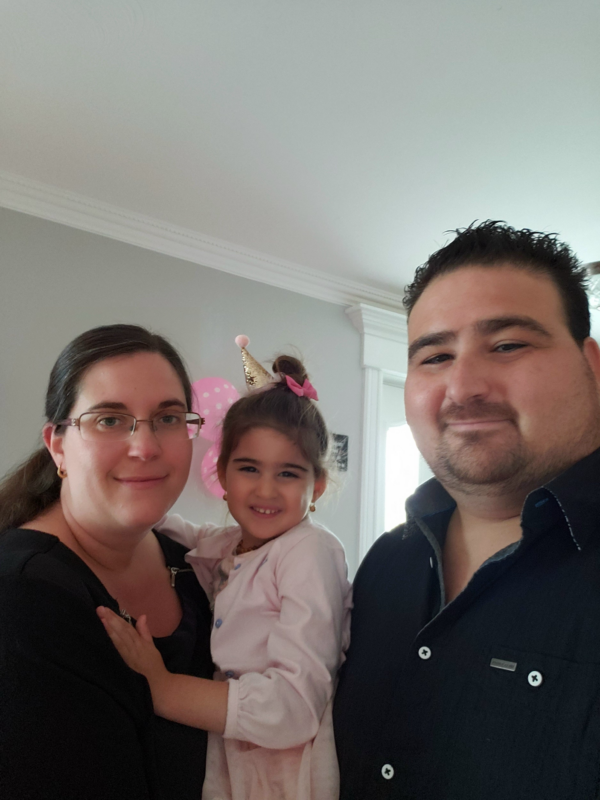
Five a.m. alarm clock: I sulkily hit the snooze button and slowly roll out of bed, ready to begin my journey to the office in Toronto. The train leaves promptly at 7:20 a.m. from Aldershot station, about a 20-minute drive from my house in Stoney Creek. To make it to the train on time so I am in the office by 9 a.m., I leave the house no later than 6:45, providing time for a proper parking spot and to load up my PRESTO before the train leaves. Shower, get dressed, eat a quick breakfast, and out the door I go; then on the train to Union Station, where the second “adventure” of getting onto the TTC awaits. I get off at Bay Station and hit the Tim’s on Wellesley to get my morning cup of coffee, then on my way to Alumni Hall. Emil is usually already hard at work, ready to greet me as I saunter past his office, stopping for a brief chat about the previous evenings’ Leafs game or how neither of our children slept the night. The day usually starts with checking the many emails that came in overnight, from students asking about information on their courses and reaffirmations that they are on the right track. Diana comes in not too long after, and the three of us chat a bit before getting “lost” in our work; though, before long one of us would usually ask “Is it lunch time yet?” as we couldn’t wait to go to our favourite lunch hot spot: EATALY! As you can imagine, the afternoons were a little harder to get through because of having eaten delicious food and especially after a bombolone (Italian doughnut). However, we got through the days easily with the help of student drop-ins, conversations with faculty, and many phone calls and emails being made.
Fast forward to mid-March. No longer being woken up by a 5 a.m. alarm to remind me I had to catch a train, the commute from Stoney Creek to Toronto turned into the commute from my bedroom to my “living room office.” No longer worried about getting on a crowded GO train or TTC subway. The worry now was whether my internet would hold up for the Zoom appointments I had that day; or whether my three-year-old would make an appearance at our Faculty Council meeting. Face-to-face conversations with students turned into many back-and-forth emails; morning conversations between colleagues turned into many WhatsApp messages and frantic Zoom meetings to talk about what had to be done that week. It very soon became “the norm” and we had to adapt quickly to our new circumstances. Course planning in the lounge turned into strings of emails between me and TST, making sure we had the right course information for the upcoming academic year. Zoom became a normal way of communication between me and our students, meeting to plan for what courses they had to take in the Fall and Winter. Since the COVID pandemic has caused many to re-think how we do things, we as a Faculty of Theology have decided to run our Fall courses remotely, not yet knowing what the Winter term will hold. The hope is that we can return to some in-class learning, but only time will tell. For now, we will continue to forge ahead and are planning a virtual Welcome Day, many Zoom liturgies to come, and a possible online Convocation.
Only a handful of times does my daughter want to know what “papa is doing,” or decides to peek her head into one of my student appointments. I have the benefit of not having to juggle working from home and taking care of my daughter at the same time because my wife has also been home since March; this has been a blessing in disguise. Though there have been challenges, it has been nice to be home with my family and be able to experience some of the things I would otherwise miss while away at work. We are lucky to be able to enjoy nice lunches together outside on our deck in the beautiful summer weather; It isn’t EATALY, but it is perfetto!
Read other InsightOut posts.
Fr. Don McLeod is a Basilian priest, an alumnus of USMC (College and Faculty of Theology) and a member of the Collegium since September 2013, serving as Chair from 2017 until the present. He has a particular interest in institutional governance and in ensuring that the proper role of the Collegium in University governance is clearly outlined. He has taught and been an administrator at both the high school and university levels, most recently at St. Joseph’s College in the University of Alberta. He continues to exercise his passions for aviation and cycling, Catholic Social Teaching and the study of Scripture and Biblical languages, while residing with the Basilian Fathers of Presentation Manor in Scarborough.
“Piloting” USMC
Two or three weeks ago, someone asked me if serving as Chair of the Collegium was burdensome, especially during the current COVID-19 crisis. After a few moments’ reflection, I replied that although Collegium had recently had to confront some very challenging issues, I would not describe my role as “burdensome.” To the contrary, the past four-plus months have been challenging but not burdensome.
To help clarify, permit me to draw an analogy with aviation. When people learn that I am a licensed pilot, they often ask if I fly solo—to which my usual response is “yes and no.” “Yes,” if that means that I am the only person in the aircraft. “No,” if the implication is that no one else is involved in a flight. Although it sounds counter-intuitive, even if the pilot is the only one aboard the airplane, there is no such thing as “solo.”
Most people who fly commercially know that a safe and successful flight requires professional pilots “up front,” equally competent and professional flight attendants in the cabin and good ground crew—and that is certainly true. However, there is much more to aviation than that.
First, even a small aircraft comes with a very detailed Pilot’s Operating Handbook—in the case of the Cessna 172, the aircraft I fly, nearly 200 pages of very dense information. Included in this are several checklists covering nearly every conceivable situation, from before engine start through to shutdown—and the pilot who ignores or omits even parts of these does so at his or her own risk. These documents reflect literally thousands of person-hours of designing, building and testing, without which no aircraft ever makes it to the flight line, let alone into the air.
Further, behind the scenes of any safe flight are the people who service the aircraft and keep it airworthy. This includes mechanics, dispatchers, fuelers, cleaners and airworthiness inspectors—all of whom are required to ensure that the aircraft is indeed safe to fly.
Most of my compatriots fly out of and into what in Canada are known as certified aerodromes—airports, for short. These facilities require ongoing maintenance to ensure that taxiways and runways are safe and clear of any debris, including snow and ice in winter, that pavement markings including runway numbers are clearly visible and that all ground signage is accurate. Much of this work goes unnoticed but is essential to safe operation—and is regularly inspected.
Once the aircraft is ready, the airport safe to fly out of, the pilot (and maybe passengers) belted in and the engine started, the pilot is still dependent on many people to ensure a safe flight. If the airport has traffic controllers the pilot must obtain clearance both to taxi and to take off and must rely on the men and women at the other end of the radio waves to ensure safe separation of all aircraft. Even at an uncontrolled airport, the pilot must rely on other pilots and even people on the ground to advise of their positions and intentions. The same is true, in reverse order, when preparing to land.
In short, from long before engine start to after shutdown, safe and enjoyable flying is dependent on the skills, attentiveness and commitment of a significant number of people filling a wide range of roles—the pilot is one of these people, undoubtedly an essential cog in the machinery, but far from being the only one. In other words, the pilot in reality is never “solo.”
To return to my analogy, one could suggest that the Collegium, and in particular the Chair, might be viewed as the pilot who is charged with ensuring that the University is able to fulfill its mission. However, just as with the pilot of an aircraft, a successful “flight” of the University is dependent on the commitment, dedication and competence of many more persons than the relatively few that a casual observer might see seated at the Collegium table.
This has been even more apparent to me as we have dealt with the impact of the COVID-19 pandemic. From the very beginning, every member of the USMC community, regardless of their particular role, has given more than generously of their time and talent to ensure that we “fly” successfully through this unprecedented turbulence. I may by analogy be one of the “pilots” for this adventure but am well aware of the enormous debt of gratitude my colleagues and I owe to so many who have contributed to our safe and level “flight.” To them I say simply, “Thank you!”
Read other InsightOut posts.
Dr. John L. McLaughlin, Interim Dean of the Faculty of Theology, is pleased to announce that Dr. Hilda P. Koster will be joining the Faculty of Theology as an associate professor in Ecotheology. Dr. Koster comes to St. Michael’s from Minnesota’s Concordia College, where she held joint appointments in Religion, Gender Studies and Environmental Studies.
“The addition of Dr. Koster to our Faculty underscores the importance of both ecological and feminist theology to the University of St. Michael’s College,” says Dr. McLaughlin. “She will carry forward the groundbreaking teaching and research of eco-theologians Fr. Stephen Dunn and Dr. Dennis O’Hara, as well as the important work in feminist theology conducted by professors such as Sr. Ellen Leonard and Sr. Mary Ellen Sheehan.”
Dr. Koster will teach courses for the Faculty’s three basic degree programs—the Master of Theological Studies, the Master of Divinity and the Master of Religion Education degrees—as well as teach and supervise graduate students through the Graduate Centre in the Toronto School of Theology. In the 2020-2021 academic year her courses will include Introduction to EcoTheology, Catholic Social Teaching, and a new course titled Ecofeminism, New Materialism and Ecological Theology.
She will also help shape the activities and certificate program of the Faculty’s Elliott Allen Institute of Theology and Ecology (EAITE), which was established in 1991 to allow students to acquire a specialization in theology and ecology.
“The University of St. Michael’s College has been a leader in ecological theology through the Elliott Allen Institute. It is a privilege and an honour to further this tradition of visionary ecotheological education and scholarship,” says Dr. Koster. “My own work in ecological theology is done from an eco-feminist perspective. To me environmental and gender justice are interconnected.”
Born in The Netherlands, Dr. Koster received her Bachelor of Arts and Master of Divinity degrees from The University of Groningen. After further study at Princeton Theological Seminary and the Candler School of Theology at Emory University in Atlanta, she earned her doctorate at the University of Chicago.
Dr. Koster has published articles and book chapters on eco-feminist theology, and edited two books on Theology and Climate Change. The book Planetary Solidarity: Global Women’s Voices on Christian Theology and Climate Justice (Fortress, 2017), co-edited with Grace Ji-Sun Kim, gathers eco-feminist theological reflections on the intersection of gender and climate justice by feminist/womanist/mujerista theologians from both the minority and majority world. Together with Ernst Conradie, she published the T&T Handbook of Christian Theology and Climate Change (Bloomsbury, 2019) to create a dialogue between religion scholars, ethicists and theologians situated within a high carbon footprint context and those representing climate vulnerable communities in low carbon footprint world.
Emily VanBerkum (USMC MDiv 2015) is the Dean of Student Residence at Loretto College, and John Paul Farahat (UofT DMA 2019) is Director of Music and Principal Organist of Saint Basil’s Church.
Enjoying Life’s Quiet Moments
“How many times have you noticed that it’s the little quiet moments in the midst of life that seem to give the rest extra-special meaning?” — Fred Rogers
The story of the proposal is really a two-part saga. Last year around this time, we were vacationing in Chamonix, France. Standing at the base of Mont Blanc, eyes gazing up at the breathtaking alpine landscape with gelato and marzipan cookies in hand, we considered ourselves incredibly grateful.
Unbeknownst to one of us, an engagement ring had been discreetly tucked away in our luggage for a surprise proposal in the Alps. But that carefully chosen landscape would fall through following an ill-timed fall down an old stone church staircase moments before that destined date-night dinner. Instead of a picturesque engagement ring reveal in a historic gazebo on a crisp late summer night under a sky of twinkling stars…a torn ligament, a pair of crutches, and a wheelchair ride through the Geneva airport.
One month later—ankle reasonably healed—we took a relaxed evening stroll along Toronto’s Queen’s Quay. Nearing sunset, on an ordinary park bench looking out to the calm waters, a proposal happened at last. A wild success: two elated smiles (and no torn ligaments). It was a perfectly tranquil, joyful moment. We laughed at the story of the-Chamonix-proposal-that-almost-was, and exclaimed to each other that 2020 was the year to be married—a year of perfect balance and harmony. We unhesitatingly chose Saint Basil’s, a parish to which we have both happily belonged since our student days, and set a date for September, 2020.
Much has changed in the world since we made initial arrangements. While our 2019 selves were focused on venues, vendors, realizing the “wedding vision,” and planning for out-of-country family members to attend, our 2020 selves have been more concerned with health, safety, and grappling with our new reality.
Our new central question was shared with many others: do we go ahead with the wedding, or do we postpone?
Our engagement story provided us with a providential lesson. The elaborate getaway proposal in Chamonix—with bells, whistles, and grand gestures—was replaced with a quiet proposal close to home, with only the most essential elements: the two of us, the “big question,” and a whole-hearted promise to spend our lives together. Indeed, the most though-out plans do not always go according to plan. Often, it is the beauty of the “quiet” moments that we cherish so deeply. It’s these instances that capture a moment in time, leaving an indelible mark on our minds and hearts.
Therefore, we have decided to move ahead with the originally scheduled date.
Establishing a sacramental union in Saint Basil’s, even without the larger guest count, elaborate reception, or flourishes that we had originally imagined, allows us to be true to what is most foundational: that marriage is a vocation in which the couple is drawn together for a purpose greater than themselves. Just like the proposal, our wedding day will be a reminder to find joy and contentment in the quiet, less elaborately planned moments of our married lives.
The beginning of our married life, surrounded by a small gathering of immediate family, will be at the forefront of our special day. And while we know the wedding day doesn’t make the marriage, in the end, perhaps the apparent “quietness” of the day will be everything we didn’t know we needed.
Read other InsightOut posts.
St. Michael’s pulled out all the (virtual) stops on Thursday to honour three key leaders as they move on to new roles and responsibilities. More than 90 people gathered online to celebrate the careers—thus far—of Principal Randy Boyagoda, Theology Dean James Ginther and Fr. Peter Galadza, Director of the Metropolitan Andrey Sheptytsky Institute of Eastern Christian Studies (MASI).
Festivities began with a slideshow of each man in action on campus—Fr. Peter with students at Windle House, Dean Ginther presiding at convocation, and Principal Boyagoda in Rome with Gilson Seminar students—all set to the jazzy strains of Natalie and Nat King Cole’s duet of “Unforgettable.”
Then President David Sylvester kicked things off with a welcome to guests, who ranged from students and Collegium members to colleagues and family. Dr. Sylvester recalled his own welcome party two summers ago, bemoaning the fact that the assembled could not celebrate in person in the sunshine of Scollard Park, as he had been feted.
As the program unfolded, however, the inability to gather together did not stand in the way of heartfelt praise for each man. Dr. Ginther offered a tribute to Fr. Galadza, who is retiring from MASI, citing his “dogged commitment to academics,” his “passion for Eastern Christian studies” and his deep faith.
The Dean recalled that even though the two men were doing doctoral studies at the same time at St. Mike’s, it was only during the negotiations in 2017 to bring MASI from St. Paul’s University in Ottawa to St. Michael’s that they met, and Dr. Ginther expressed great admiration for Fr. Galadza’s dedication to students, MASI and the Church.
In response, Fr. Galadza offered his thanks, and expressed his delight at finally being able to spend more time with Olenka, his wife of 41 years.
“God bless all of you,” he said, and guests responded with a flurry of virtual toasts and clapping emojis.
Then Dr. Sylvester offered thanks to Dean Ginther for his service to the Faculty of Theology, noting that, as both men are mediaevalists, the former knew the latter’s academic reputation long before the two met, given Dr. Ginther’s profile as a scholar of Robert Grosseteste and his work in digital humanities.
Calling him a champion of the Faculty, the President cited the Dean’s “tireless work” in renewing the graduate division of St. Michael’s, citing three new hires as an exciting indication of things to come.
Dr. Ginther responded with thanks to faculty staff and his colleagues, and told those assembled how much he is looking forward to returning to the classroom after his year-long research leave.
“It’s been 12 years” since he’s had a leave, he noted.
This prompted another flurry of toasts and clapping icons.
Then it was Dr. Boyagoda’s turn to be honoured. With some gentle teasing, the President noted that if he left anything out in his introduction “Randy would fill it in.”
Dr. Sylvester thanked the outgoing Principal for his vision for St. Michael’s, noting that he was at the forefront of the renewal of the university’s programming and repetition, helping to restore St. Mike’s to its place as the leader in Catholic education.
In his response, Dr. Boyagoda, who has been named Vice Dean, Undergraduate in the Faculty of Arts & Science at the University of Toronto, offered thanks to many people, and then concluded his remarks with an anecdote.
He had just been the basement of Elmsley Hall with a young colleague to seek out furniture for the office he will maintain at St. Mike’s, as he will teaching the Gilson Seminar next year. The new employee who greeted him thought he was a student.
“I’m leaving here feeling young!” he proclaimed, and everyone offered a virtual toast.
Then came a round of comments from such notables as Collegium Chair Fr. Don McLeod, CSB, and Dr. Christopher Brittain, Dean of Divinity at Trinity College.
It was not the in-person party that anyone had imagined, but it was a heartfelt send-off, and the community wishes all three godspeed as they head off in new directions.
Andrew Selvam is currently the Acting Chaplaincy Teacher at St. Joseph CSS in Mississauga. He is also a science and religious studies teacher with the Dufferin-Peel Catholic District School Board. He is currently pursuing his Master of Religious Education degree at St. Michael’s Faculty of Theology. He enjoys music, hanging out with friends and family, and travelling.
A Language of Love, Unity, and Joy
The day was March 12; I remember it clearly. I had just finished with our chaplaincy team meeting in the library when a student asked me if it was true…that they would be closing schools for three weeks because of COVID-19. I immediately went to my computer to confirm what I hoped wasn’t true and, lo and behold, it was. We would be away from school for at least three weeks. Immediately the news cycle was flushed with what was becoming a worldwide pandemic and, as each given week passed, it seemed more and more likely that the school year would happen away from the school.
After March Break, it was a very slow waiting game. Retreats, social outreach programs, and student engagement activities would have to be put on hold. The way relational ministry would have to be delivered would look very much different. I had been reading all the emails from our school board offering all of the different platforms for learning, but I stood there for a moment and wondered “How do I connect with students?” From the beginning, it became a get-go of mine to make sure that, in as many ways as possible, I was going to make it feel as much as it could for students like we had never left. My first digital daily reflection went out on the feast day of the patron of our school, St. Joseph, more important than ever as the patron saint of families and the universal church. The Holy Spirit that I always felt travelling through a school would be called upon to help me figure out this new upper room. And that was just my motivation. I needed the Holy Spirit also to do the work of expanding this upper room, now neighbourhoods apart from each other and along a digital superhighway.
As each new day rolled out, each reflection and activity would focus more on refocusing our “new reality” into something positive, something to come alive through the Spirit. Meeting with students using videoconferencing applications made it as close to kids coming by the office as I could. Three-and-a-half months later, it has transformed into an opportunity for us to hear each other, talk about the struggles of the day, of the week and of the month, and offer support when needed. With the chaplaincy team back in full swing, I was ecstatic that, more than ever, kids were looking for ways to be engaged outside of the classroom. Each discussion we had and prayer we said felt like therapy for the mind and the soul, for the kids and for me.
But distance-learning causing frustrations wasn’t the only thing on the minds of staff and students. The number of deaths of relatives of staff and students was on the rise, and I asked the Spirit to just give me the right words to say when I picked up the phone to offer my condolences and support in any way that I could. It also became apparent that many of our families had parents unable to work, raising the possibility of not being able to put food on the table. The St. Vincent de Paul society helped us out, as did our generous staff, to provide food and gift cards for our neediest families.
I have to say I had my reservations. I did not know what distance chaplaincy would look, but it has been more than enlightening. It has shifted me out of my comfort zone in a way only the Holy Spirit can, and moved me to find energy reserves I did not think I had. We had just celebrated Easter at the beginning of this pandemic, and we know that we are an Easter people called, as Christ did, to work to make anew. More than anything, though, we have been called to be a Pentecost people—gathered together, filled with our blessed gifts, so that people outside our Upper Room can hear us speak in a language that they could understand—a language of love, unity, and joy.
Read other InsightOut posts.
Professor Emeritus Dennis Patrick O’Hara is the former Director of the Elliott Allen Institute for Theology and Ecology at the St. Michael’s Faculty of Theology, where he taught from 2002-2019, and directed many theses in ecotheology and ethics. He was also an associate member of the graduate faculty at the School for Environment at the University of Toronto. In addition to teaching courses in ecological theology, spirituality, ethics, and sustainability, he has worked for the World Health Organization and Health Canada researching and preparing policy positions. He regularly delivers both popular and academic lectures in Canada and the USA but has also lectured in Europe and South Korea. Prior to becoming a theologian, he practised as a chiropractor and naturopathic doctor, and taught at colleges of both of those professions.
Moments of Grace and COVID-19
Basil of Caesarea, in Rule LV: Whether the Use of Medicinal Remedies is consistent with the Ideal of Piety, instructs that a serious illness can be sufficiently disruptive to our normal patterns of living that it can force us to consider the circumstances that led to our illness and to re-evaluate our choices so that we can once again align our life with the telos of God’s creation. This opportunity can be identified as a moment of grace, on a religious level.
Thomas Berry notes that moments of grace can also occur on cosmic and historical levels, such as the dispersal of primary element via the explosion of stars or the development of photosynthesis. Throughout the 13.8-billion-year history of the universe, change occurs when systems reach the most tension that they can creatively endure. At that point, systems evolve irreversibly by transforming into a new level of order and complexity by resolving the dangerous tension in an unprecedented way. In many respects, we are at such a moment, in part due to the COVID-19 pandemic and in part due to an ecological crisis magnified by climate change.
The people who are suffering the most due to the ecological crisis with its complex interwoven array of hardships will undoubtedly be least able to withstand the consequences of the COVID-19 pandemic with its threats to personal health and reduced access to supportive infrastructures. Both the ecological crisis and the COVID-19 pandemic are anthropogenic crises on a global scale, and both require a commensurate response. This pandemic has demonstrated the enormous actions we will take when we decide to act for the common good as a single Earth community. Despite decades of exasperating delay to curtail climate change, when faced with this pandemic, nations rapidly instituted measures to restrict travel, pause economies, enforce physical distancing, and impose domestic isolation. Perhaps such a collective and purposeful response could become a rehearsal for addressing Earth’s ecological challenges as we creatively seek ways of being that are mutually enhancing for us and the rest of the Earth community.
Pope Francis, in an interview with Austen Ivereigh from the University of Oxford concerning this pandemic, noted that the great uncertainty of this present moment is “a time for inventing, for creativity” because “every crisis contains both danger and opportunity: the opportunity to move out from the danger” through conversion, including “the decisive step to move from using and misusing nature.” Ecotheology reminds us that we have a common origin and share a common sacred story with all of Earth. We need to reframe our choices to better align with the creative dynamics and the telos of that story for we will go into the future as a single Earth community or not at all.
Read other InsightOut posts.
Dr. Callie Callon is a New Testament scholar at the Faculty of Theology who has also taught at the undergraduate level for St. Michael’s. She is an expert in ancient physiognomy, looking at how early Christians used appearances to praise or impugn others. Her book, Reading Bodies: Physiognomy as a Strategy of Persuasion in Early Christian Discourse, was published in 2019 by Bloomsbury Publishing.
Healing Moistly in Ancient Times
Recently, Prime Minister Trudeau rather infamously suggested that wearing masks during the current health crisis will help prevent the transmission of the virus through saliva, or, as he phrased it, by “speaking moistly” on others in close proximity. As cringeworthy as this “terrible image” is to a contemporary audience, it likely would not have evoked the same reaction in an ancient Mediterranean one. In this context the use of saliva was considered by some to be highly efficacious in treating a number of various ailments.
Perhaps the most famous examples of this are found in the New Testament, where Jesus is depicted as using his own saliva in conjunction with healing some sensory afflictions. In the Gospel of Mark Jesus heals a person with hearing and speech impediments through his touch, prayer, and by spitting (7:31-53). Visual impairments are healed by him with the assistance of a topical application of his saliva in two accounts. In Mark, Jesus spits directly into the eyes of a supplicant prior to laying his hands on him (8:22-26). In the Gospel of John Jesus forms a paste made from saliva and earth which he the applies to the blind man’s eyes before instructing him to then go and wash in the pool of Siloam (9:6-7).
However, these were not the only people who were held to have regained their vision through the application of saliva in ancient texts. According to the first/second century historians Suetonius and Tacitus, the emperor Vespasian accomplished a similar feat through the use of his saliva (Vesp., 7.2; Hist., 4.81). Pliny the Elder, a natural historian from the first century, also attests to the use of saliva for ocular disorders, asserting that ophthalmia could be remedied by daily application of the spittle of a fasting person (N.H. 28.7). According to him, a fasting woman’s spittle was considered an extremely effective treatment for bloodshot eyes (N.H. 28.22)
Beyond eyesight, Pliny further relates a tradition that seems to have held the application of spittle from a fasting person as a particularly effective treatment for a variety of different complaints. To cite but a few examples, it was thought that the application of this type of spittle behind a person’s ear would soothe a disordered mind (N.H. 28.5), could be used to treat boils (N.H. 28.7) and to remove leprous spots (N.H. 28.7), and that a “crick in the neck may be got rid of by carrying fasting spittle to the right knee with the right hand, and to the left knee with the left” (N.H. 28.7).
Non-topical uses are also attested for a host of different ailments, ranging from warding off snakes to prevent poisonous bites (although should it enter their throats it purportedly destroys them [N.H. 7.2]), as a preventative against contracting epilepsy (N.H. 28.7), and as a means to secure the desired outcome of a healing incantation regarding foot pain, with the rather interesting stipulation that the accompanying words “must be recited sober” (Varro, Agr. 1.2.27).
Far from being a transmitter of health complications, in some ancient Mediterranean thought saliva was viewed as a means to resolve or even prevent them. While our present circumstances necessitate keeping our saliva to ourselves, there is still a wealth of actions drawn from the gospels that we can, have been, and should emulate: compassion, faith, love and care for others. And of course, social distancing (Mark 1:35; Luke 5:16; Matthew 14:13)!
Read other InsightOut posts.
Sheril Hook, chief librarian at the John M. Kelly Library, tells the story of a University of Toronto professor calling her recently for help. The professor simply couldn’t find the materials he was searching for—Syriac-Latin text editions for the Patrologia Orientalis series, as well as articles from Analecta Bollandiana. With just a little digging, she found them, digitized from the Pontifical Institute for Mediaeval Studies (PIMS) collection, which is housed at Kelly.
“U of T is one of the top research libraries in North America. I was confident I could find the materials,” Hook says.
A library can be hard enough for an expert to navigate, so asking students to find resources remotely during physical distancing can be a challenge for those already stressed over papers, exams, and an uncertain summer.
In response, Hook and Noel McFerran, Kelly’s Theology and Rare Books librarian, are hosting a virtual town hall on Wednesday, May 6 for students in the basic and advanced degree programs at the Faculty of Theology. The afternoon session is perfect timing for theology students enrolled in intersession courses. Eligible students have received an email with instruction on how to access the online gathering, and it will be recorded for anyone who cannot make the 3-4 p.m. time slot.
The librarians have three goals for the hour-long session, which will include a 15-minute presentation, as well as time for questions posted to the forum. First, they want to do a close look with students at the U of T catalogue, delving into some of the more advanced ways to search it to discover digitized materials.
“We’d like to show people how to find materials they didn’t anticipate being online,” Hook says.
Then, they will highlight materials that have been made temporarily available to students. While in this period of physical distancing due to COVID-19, for example, students can call on the HathiTrust Emergency Temporary Access Service.
The third thing McFerran wants to stress is that the Kelly librarians are constantly discovering new materials.
“Send us an email and ask us about availability,” he says. “Just last week I had to say ‘sorry, it’s not available’ to a request, but this week that material has been digitized, so I was able to help the student after all.”
“This is a great new opportunity for learning,” says Hook, who notes that Kelly Library plans to expand sessions in the fall semester to include undergraduate students as well. “It’s important to feel comfortable in asking for help. If you can’t find something, we will look for you, as we very likely have it.”
Ann Mathew graduated from St. Michael’s College, University of Toronto, in 2019 with a double major in English and Christianity & Culture. While an undergraduate, she served as an editor on Saeculum, the student peer-reviewed journal associated with the Christianity & Culture program. She has just completed her first year of the three-year Master of Divinity program at the Faculty of Theology. A member of the Faculty’s Student Life Committee, she also sits on one of the subcommittees preparing for the coming visit by the Association of Theological Schools, the Faculty’s accrediting body.
Adjusting to the New Normal
Writing this draft in the glory of the Risen Lord, I am also thrilled to have completed my first year of the Master of Divinity program at the Faculty of Theology at St. Michael’s College. Although this global situation of the COVID-19 pandemic has deeply affected all of our lives, taking a special toll on the state of classrooms, the fact that I had enrolled in a couple of introductory online courses at the Faculty meant I was quite prepared for the virtual classroom setting. That being said, this shift in one’s surroundings was indeed surprising.
Being a commuter student, this change was admittedly rather welcome. To avoid rush hours and wind chills between home and campus for the second half of the Winter semester was an unexpected blessing in the present circumstances. The faculty and administration were rather prompt in addressing us about the changes that were about to take place. In light of the various final papers and deadlines, I recall the commute to campus to hoard up on library books before the closure. While many online resources have been made accessible to us by the university, there were still a few books that I needed to check out. My transit experience on March 16th was interesting, insofar as that, during what would have been an otherwise crowded morning commute, the TTC subways ran almost barren to the bones. Strategically planning my time between the Emmanuel College and John. M. Kelly libraries, I managed to bring home some 12 books. The ride home was eerie in that many at Union Station were homebound—luggage and neck pillow-clad, with no return date in sight.
The remaining four weeks of classes flew by and we all seemed to adjust to our Zoom meetings, despite technical difficulties with Internet crashes at home, screen shares and background noises. Given the limited access to research materials, my professors graciously agreed to deadline extensions, along with concessions to primary sources. Throughout my undergraduate years, the Kelly Library gave witness to my eremitic lifestyle as each semester concluded. This time, however, my family got to experience my two weeks as a recluse. Truth be told, I rose with Christ on Easter Sunday as I submitted my final research paper.
The whole world has more or less been brought to a halt. Each one of us plays a crucial part in maintaining normalcy, and the community at St. Mike’s has helped me adjust to this new normal, especially during the most stressful time of the semester. Currently, I am awaiting the commencement of online courses in the summer. Until then, I am passing time by engaging in some leisure reading, creative writing, family prayer, card games and such. As Archbishop Cardinal Collins often mentions in his daily homilies, let us continue to demonstrate our “love for our neighbour” in these days of keeping to our homes. May we find inspiration in the most trivial of things, all the while getting a step closer in knowing ourselves and emerge out of this phase as finer human beings.
Read other InsightOut posts.
Dr. Reid B. Locklin is Associate Professor of Christianity and the Intellectual Tradition at the University of Toronto, a joint appointment with St Michael’s College and the Department for the Study of Religion. His research focuses on a range of issues in Comparative Theology and Hindu-Christian Studies, particularly the engagement between Christian thought and the Hindu tradition of Advaita Vedanta. He also writes on the scholarship of teaching and learning in theology and religion.
Catholics and Hindus, Together Alone
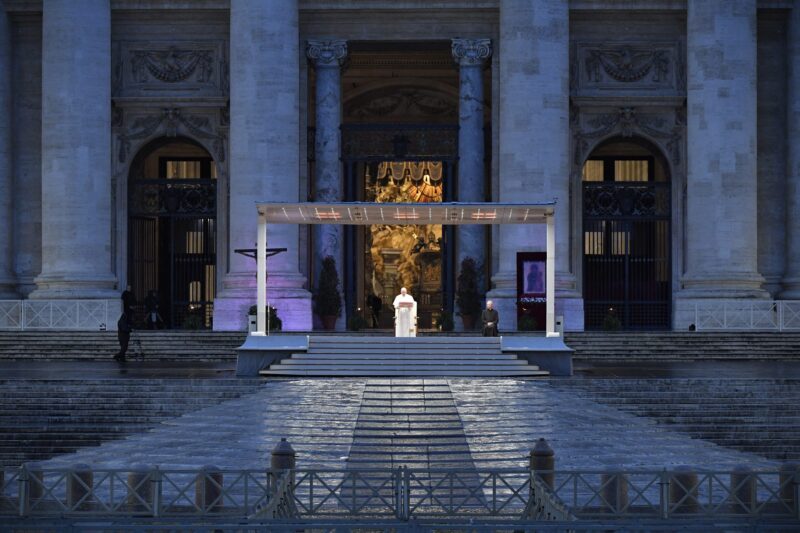
Like many Toronto Catholics, I began my observance of Holy Week this year in front of my family’s television, watching the Cardinal’s celebration of Palm Sunday in St. Michael’s Cathedral. A little over a week earlier, on March 27, I sat transfixed in front of my laptop computer as the pope pronounced a special Urbi et Orbi blessing to an eerie, empty St. Peter’s Square. My devotional life has moved nearly entirely online.
Catholics, of course, are not unique in this respect. Consider an “e-Satsangh” hosted on Facebook Live by the New York City-based Hindu movement Sadhana on April 2. In this event, a pandit offered a ritual puja in his apartment, presenting Sanskrit verses, water and other offerings to several Hindu deities well suited to the present crisis. These included the elephant-headed god Ganesha from a local temple in Flushing, New York; Arogya Lakshmi, the Goddess in the form of mother, health and power; and Sudarshana Vasudeva Dhanvantari, the god Vishnu in the form of a medicine healer. Following the puja, from a different apartment, one of Sadhana’s co-chairs guided virtual participants in a short meditation and hymns for the flourishing of all living beings. Discussion followed, ranging from the visceral—one participant sought advice on grieving the loss of a friend to COVID-19—to broader questions of advocacy and political organization. The focus here was on action: pragmatic service to those who are vulnerable, and also ritual action for their health and well-being.
Still more direct is the approach taken by residents of the Indian city of Mumbai, according to a widely circulated report. There, it seems, the Novel Coronavirus has been personified as an antigod or demon (asura). On the eve of the popular festival of Holi, effigies of this antigod—called Coronasur—were created and ritually destroyed, in an effort to halt the virus.
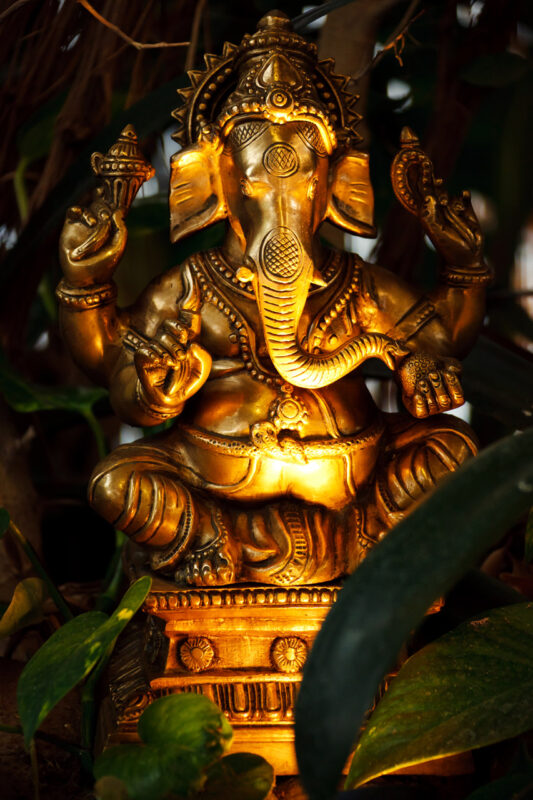
As a Catholic, I admit some discomfort with these rites, at several levels. But, also as a Catholic, I am obliged to approach such discomfort with an attitude of dialogue and exchange, rather than fear or condemnation. What might I learn from my Hindu neighbours about being a person of faith in this time of pandemic?
I think that the examples of Sadhana and even the Coronasur effigy offer an important reminder that Catholics, no less than Hindus, believe in the authentic power of ritual prayer. When Pope Francis raised the Blessed Sacrament and pronounced the Urbi et Orbi blessing on March 27, he was flanked by two icons that had defeated plagues in the past, Mary Salus Populis Romani and the Crucifix of San Marcello. This was a spiritual blessing, to be sure, an indulgence for those unable to receive the Rite of Reconciliation. But it was also an invocation of the power of God to intervene on behalf of those who are sick, and to arrest the devastation of COVID-19.
In the present crisis, some voices on the secular left and the religious right have called persons of faith to make a false choice: to follow the recommendations of public health officers, or to trust in the power of our shared prayer. Most Catholics, like most Hindus, refuse this choice. We embrace both the best science and the deep wisdom of our ritual traditions.
And so we vacate our churches and temples, and even St. Peter’s Square, to “flatten the curve.” But that need not, and cannot, stop us from persisting in our prayers. In this, Catholics, Hindus and many other others stand together, even while we are alone.
Read other InsightOut posts.
University of St. Michael’s College President David Sylvester is pleased to announce the appointment of Dr. John McLaughlin to a two-year term as Interim Dean of the Faculty of Theology, effective July 1, 2020.
Dr. McLaughlin served as the Faculty’s Interim Dean in the 2014-15 academic year prior to Dr. Ginther’s arrival.
“St. Michael’s is fortunate to have such a capable administrator with a strong familiarity and history in the Faculty” says Dr. Sylvester. “Dr. McLaughlin’s presence in the Dean’s office will help make this process seamless, and I look forward to working with him in this role.”
A professor of Old Testament/Hebrew Bible, Dr. McLaughlin earned a BA from St. Thomas University in Fredericton, NB before enrolling at the University of Toronto, where he earned an MA in Philosophy. He then studied Theology and Scripture at St. Michael’s Faculty of Theology, earning an MDiv and a PhD.
Professor McLaughlin joined the St. Michael’s faculty in 2002 after teaching for seven years at Wheeling Jesuit University in Wheeling, West Virginia. He is an Associate Member of the Graduate Faculty with the Department of Near and Middle Eastern Civilizations at U of T, and is a past President of the Canadian Society of Biblical Studies. He currently serves on the Editorial Board of the Journal of Hebrew Scriptures and as an Associate Editor of the Catholic Biblical Quarterly.
Current Dean Dr. James Ginther completes his five-year term on June 30 of this year. After a 12-month research leave, Dr. Ginther, a mediaevalist and historical theologian, will return to the Faculty to teach and conduct research.
Dr. Sylvester has expressed his gratitude for Dr. Ginther’s service over the course of his term in the Dean’s office. “I would like to thank Dr. Ginther for his tremendous service to our community as a member of the President’s Advisory Group and Senior Administration team, in his leadership within the Toronto School of Theology, and in many other collaborative initiatives, including in his field of expertise at the Pontifical Institute of Medieval Studies and the Centre for Medieval Studies,” he says. “I look forward to Jim’s return to campus following his leave and to his renewed leadership at the University.”
Fr. Gustave Noel Ineza, OP, is a doctoral student at St. Michael’s Faculty of Theology. Born and raised in Rwanda, he lived through the 1994 genocide against the Tutsi and went into exile for a month in what was then Zaire. His family left the refugee camps and returned to Rwanda after three members of his family developed cholera. He studied in the minor seminary and joined the Dominican Order in 2002. He studied Philosophy in Burundi, and Theology in South Africa (SJTI/Pietermaritzburg) and the UK (Blackfriars/Oxford). Ordained in 2014, he worked for Domuni (www.domuni.eu) and was a chaplain to university and high school students. In 2018, he came to Canada to pursue studies in Christian-Muslim dialogue. He is currently reading on post-colonial approaches to the taxonomies assigned to religious traditions (Muslims and Christians) by colonial powers in Rwanda.
In Solidarity with the Suffering
When it was announced in Canada that COVID-19 was knocking at the door, multitudes rushed to shopping malls to buy as many provisions as they could, to be “prepared” for the pandemic. One item in particular was a major target of the worried crowds: toilet paper. Looking at images of people with trolleys full of toilet paper, one thought came to mind: “People are planning to eat a lot.”
I was reluctant to write this post because it is not easy to introduce a distressing subject in the middle of a global lockdown caused by a pandemic. It would be adding distress to distress. However, anyone interested in humanitarian crises has to know that disasters differ in intensity.
As I write this reflection on April 7, the whole world has started commemorating the Rwandan Genocide against the Tutsi, one of the worst genocides of the history of the world. Twenty-six years ago, in 100 days, about a million people died in a genocide, yet the rest of the world seemed disinterested by — or unaware of — what was happening there. Nations sent contingents of soldiers to Rwanda to remove their citizens from what the world knew to be genocide while at the same time trying to ignore the plight of the Tutsi for reasons no one has yet managed to logically explain to me.
After the genocide, masses of Rwandans moved to what was then Zaire – now, the Democratic Republic of Congo – seeking refuge. For a couple of weeks, we thought the world did not know that Rwanda existed. I was 11 years old.
Today, as the world closes in on itself to fight a ruthless pandemic, it is easy to forget there were ongoing crises around the world before COVID-19. No one forgot, I suppose, that Syria was in the middle of a bloody war, that Yemen never saw the end of another almost internationally ignored horrific conflict.
As a young child in Rwanda during the genocide, I would spend the day looking up at the sky to see if planes would bring United Nations troops. A few months later, in the refugee camps, I saw UN workers and knew we would get food soon if cholera did not first decimate my family, as three members were already infected. There was hope because, at that age, I knew that there were not so many crises going on in the world. I can imagine there is nothing as frightening as knowing that you may die soon of hunger or be killed, and that no one will even know about it because the whole world is afraid of something you consider a minor threat to you in light of all the other challenges and threats you face. Today, the UN relief agency UNHCR and other humanitarian organizations are reminding people that crises are still happening around the world and that charitable people should not forget those who are hungry, in refugee camps,or being persecuted because they belong to minorities.
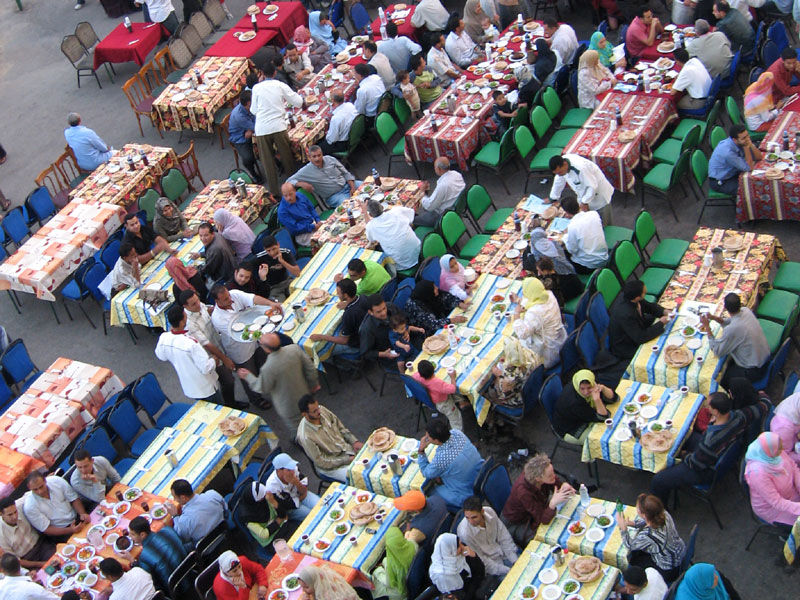
Consider this pandemic as experienced by poverty-stricken families in extremely poor countries. After the confinement began in Canada, it took only a couple of days to have African countries announce total lockdowns. In most African countries, a lockdown means staying inside your compound-house, your hut, or just in a small house that hosts more than eight people. A five-week confinement without a job for a family of five is nothing less than a death sentence. Fortunately, some countries have started distributing food, but very few people manage to get it. Worse, all those without homes and who had relied on charitable people’s provisions will have to find other means to feed their families. The city of Cairo has announced that the famous charity tables (mawa’ed al rahman) that adorn the streets during Ramadan for poor people to eat after a day of fasting were not going to be set this year. Having been in Cairo during the 2012 Ramadan month and having shared food at Al Abbasiah and Midan Al Tahrir with people from all strata of society, I understand how this will impact poor communities.
It would be inconsiderate to end without mentioning another shared worry for African people around the world. Two French doctors, Dr. Jean-Paul Mira, head of the Intensive Medicine and Intensive Care units at Cochin Hospital, and Professor Camille Locht, director of research at INSERM, discussed on a French talk show the plausibility of testing COVID-19 vaccines on the African continent. The suggestion raised an outcry from many who did not grasp there are many other places where testing is in progress. The overall perception from both ordinary people and many African celebrities, including the WHO’s Director-General Mr. Tedros Adhanom Ghebreyesus, was that Africa would once again be that continent where people are considered lab-rats, where foreign countries go to test their unsure economic and political theories, drugs, or just to dump hazardous industrial wastes. The WHO Director-General called those French doctors’ attitudes a colonial hangover. Whatever intention those doctors had, their statements were inappropriate enough to worry an entire continent and all those who care for its inhabitants. Would that mean that when a vaccine is finally discovered African countries will still need to overcome trust issues before making it available to their people?
As we struggle to accommodate the strenuous new routines caused by home confinement, let us think of all those dealing with COVID-19 while facing greater and deadlier calamities. May solidarity with those who suffer be the major lesson we may take from these distressing times.
Read other InsightOut posts.
Because Sunday Mass has been cancelled due to the coronavirus pandemic, Dr. Darren Dias, O.P., has shared his homily for this, the Fifth Sunday of Lent.
Dr. Dias teaches in St. Michael’s Faculty of Theology, specializing in Trinity, Religious Diversity, and teaching methods. He is currently working of a SSHRC funded project with colleagues Gilles Routhier (Laval) and Michael Attridge (St Michael’s) entitled: “One Canada Two Catholicism: Divergent Evolutions in the Catholic Church in Quebec And Ontario, 1965–1985.”
Tears of Compassion
John 11:1-45
“Jesus began to weep” is the shortest verse in the NRSV English translation of the New Testament. Yet this short verse says something terribly important about Jesus and his solidarity with us in our moments of difficulty and suffering.
In John’s Gospel account, Jesus’ friend Lazarus is ill and Jesus is summoned to his side by his sisters, Martha and Mary. But instead of hurrying to be with them, he waits another two days. He says that the death of Lazarus is an occasion for Jesus to be glorified. Jesus confidently refers to Lazarus’ death as “merely sleeping” and even says, “I’m glad I was not there so you may believe.” Jesus is strangely sanguine about his friend Lazarus’ death.
But as Jesus’ gets closer to the tomb, he becomes increasingly emotional. Twice, the Gospel lection says, “Jesus was greatly disturbed.” And then he began to weep. But why how do we account for this change of emotional state? One moment he seems placid and confident and the next he weeps. Does Jesus not think he will be able to “awaken” Lazarus anymore? Does Jesus suddenly doubt the life of the resurrection? Or the power of God to be glorified? Why the change?
In the Gospel lection, we read that “When Jesus saw Mary weeping, and the Jews who came with her also weeping, he was greatly disturbed in spirit and deeply moved…Jesus began to weep.” It was in his encounter with those who suffered loss and were grieving that Jesus began to weep. He is not weeping for Lazarus. He is weeping with, sharing in the suffering of others. Compassion is the source of Jesus’ tears.
Though Jesus is confident in his belief in the life of the resurrection, it doesn’t negate the real suffering of those who loved Lazarus, his sisters Mary and Martha, their friends, and Jesus himself. At the coming celebration of the Lord’s Passion on Good Friday we will read about Jesus in the letter to the Hebrews: “For we do not have a high priest who is unable to sympathize with our weaknesses, but one who has similarly been tested in every way.”
Compassion comes from the Latin word “to suffer with.” We often experience the suffering of others, whether vicariously or else because we have memories of similar suffering. Suffering is part of our human condition. And solidarity in suffering reveals the depth of our humanity.
The current COVID-19 crisis reminds us how interconnected the human family really is. We are “deeply moved” by the dedication of medical professionals and other front line workers. When I’ve gone to the store to buy necessities, I’ve been struck by the friendliness and dedication of workers in drugstores and grocery stores in very difficult circumstances. We are “disturbed in spirit” by the lack of ventilators for all those who may need them. We “weep” at the deaths of so many around the world, and of their families who are unable to bury them at this time. We are experiencing a deep sense of togetherness around the globe because we are all affected, and we all wait with some anxiety, for an unknown future. As we stand at the entry of the tomb, we ask what will Easter look like this year.
Our Gospel lection today reminds us that the God of life is not unaffected by our situation. Indeed “the Christ, the Son of God, the one coming into the world,” our “high priest” weeps with us, with compassion for the suffering, anxious, sorrowful and grieving.
Because Sunday Mass has been cancelled due to the coronavirus pandemic, Dr. Darren Dias, O.P., has shared his homily for this, the Fourth Sunday of Lent.
Dr. Dias teaches in St. Michael’s Faculty of Theology, specializing in Trinity, Religious Diversity, and teaching methods. He is currently working of a SSHRC funded project with colleagues Gilles Routhier (Laval) and Michael Attridge (St Michael’s) entitled: “One Canada Two Catholicism: Divergent Evolutions in the Catholic Church in Quebec And Ontario, 1965–1985.”
Finding God in Challenging Times
John 9:1-41
Amid this global COVID-19 pandemic, isolation and physical distancing are necessary to diminish the spread of the virus. In our time we can definitely understand the link between illness and isolation. In Jesus’ time, illness, and particularly something like blindness, was believed to be a punishment for the sins of one’s parents or ancestors. Thus, the question of the disciples to Jesus about the man born blind: “Who sinned this man or his parents?” Of course, Jesus’ answer is neither one; the very question misses the point. The man born blind would have been marginalized because his blindness was thought to be the product of divine punishment and so he would have been excluded from the normal network of social relations. We read that he had to beg for his livelihood. Like many other healing accounts, when Jesus heals this man he not only cures him physically but removes the reason for him to be excluded and isolated from his community. Jesus heals him and tells him to purify himself in the pool of Siloam so that he might be re-born into his community.
In the narrative the man born blind is cured of his blindness but only gradually begins to see. When initially questioned by Jesus’ critics about who opened his eyes, the man responds rather journalistically by recounting the events as they happened, not even mentioning Jesus by name. When pressed his questioners ask, “what do you say about him?” The man responds with the conviction: “He is a prophet.” His questioners react with a strong judgment against Jesus, calling him a sinner because he works on the Sabbath. Yet again they ask the man how is it that he now sees. Seemingly frustrated by their criticism of Jesus — and with firm conviction — the man says that Jesus is not a sinner but one who obeys and worships the true God of Israel and to whom God listens. The man’s questioners, those in power and authority, are scandalized that this poor beggar, a man born in sin else he would not have been blind, someone neither named nor vouched for by his own parents, would dare to teach them and so “they drove him out.” The man born blind, cured by Jesus, about to leave the isolation of his blindness behind, on the cusp of entering into social relationships, is driven out of the community he was never really a part of but longed to have a place. It is at this point, a low point for the man who has just been healed of his blindness, that Jesus seeks him out and finds him. In the brokenness and vulnerability of the man born blind, someone who has just gone from marginal to outcast, Jesus shares himself by revealing who he is: I am he, the one speaking to you is the Son of Man. Jesus chooses to reveal his true identity not to the powerful but to the outcast. Because of this intimate moment the man can finally answer the question that had been put to him throughout the narrative about the person who cured him. The man now sees who Jesus really is.
In our Gospel selection today the man born blind, though he had a powerful experience of healing, is only gradually able to see God’s vivid presence in his midst in the person of Jesus Christ. In these days, weeks and even months ahead, many will experience the difficulty of isolation and loneliness, and be challenged to see the God who seeks us and finds us in our vulnerability and fear. But just as Jesus revealed God’s presence in his very person, maybe God’s presence reveals itself to us in the midst of this present crisis: in the selfless dedication of medical workers; in the store workers who ensure our access to food and other supplies; in neighbours who check in on the elderly or vulnerable; in our prayerful solidarity with those who are ill from the virus.

If there’s a club for people holding three degrees from St. Mike’s, move over and make space for the newest triple alumna, Rosemary Boissonneau.
Rosemary will be awarded her MA in Theological Studies from St. Michael’s Faculty of Theology on Saturday, Nov. 9, 2019, having received a Master of Theological Studies in 2017, and a BA, with a major in French and a minor in English, in 1987.
“It was interesting when I came back to St. Mike’s (in 2011) because I was a mother and a teacher and my oldest was in university herself,” she recalls. “What I found was the same hospitality, the same sense of welcome as my undergrad days, but because the Faculty of Theology is small, the sense of community was more pronounced, the sense of Catholicity more informed.
“There’s a real sense of identity and, given the size of the place, it’s easy to get to know people.”
The faculty impressed her for multiple reasons. One of the first courses she took when she returned to school was with Old Testament scholar Dr. John McLaughlin, who, as Rosemary describes, “sets rigorous standards” not only for the content of work submitted but also in his expectations regarding the mechanics of papers. They were standards, she notes, that she applied to all subsequent work to ensure she was meeting the McLaughlin bar and making the most of her education.
There was the fact that classroom topics would be addressed from a range of viewpoints, whether it was one of feminist theology or eco-theology, as well as the expectation that students would use inclusive language as much as possible.
She had the opportunity to learn the workings of a university by serving a term as a student representative on the Collegium, St. Michael’s board overseeing governance of the university.
And then there was Eco-theology Faith and Practice, a week-long course held at the Villa St. Joseph Retreat Centre in Cobourg, taught by Sisters Linda Gregg and Mary Rowell, CSJ. The course confirmed Rosemary’s interest in eco-theology, and led her to studies with eco-theologian Dr. Dennis O’Hara at St. Michael’s Elliot Allen Institute for Theology and Ecology.
“I always cared about the environment but the summer after Laudato Si’ came out I saw Dennis on a panel, which included a talk about the need for climate activism, and since I was working half-time to complete my studies, I felt I had the time to get involved.”
Her goal was to combine spirituality with justice, and that led to her work with ClimateFast, a volunteer organization whose goal is to encourage politicians to take greater – and faster – action on climate change, as well as work with #FridaysforFuture, the group behind the student climate strike.
It also played a hand in her MTS thesis, entitled The Christological Symbolism of Water in the Gospel of John.
“Rosemary is not merely intelligent but also thoughtful and morally motivated. She cannot only grasp complex ideas but she reflects on them in order to integrate them with other knowledge that she has gained,” says Dr. O’Hara. “This invariably prompts her to action, to reframe her own life and encouraging others to follow suit in their own way. She will willingly pay the price for a right course of action. This is why most professors relish her presence in class.”
Reflecting on her time at the Faculty, Rosemary says it enhanced her worldview.
A deeper understanding of Scripture, for example, has “helped me articulate what I believe,” she notes.
It has also left her an even busier woman, because even though she’s back to teaching full-time, she’s finding it impossible to set aside the volunteering she started when she was working reduced hours to complete her studies.
As she talks about finding a way to balance the rest of her life with the possibility of returning to do doctoral work, there’s little doubt she’ll find a way.
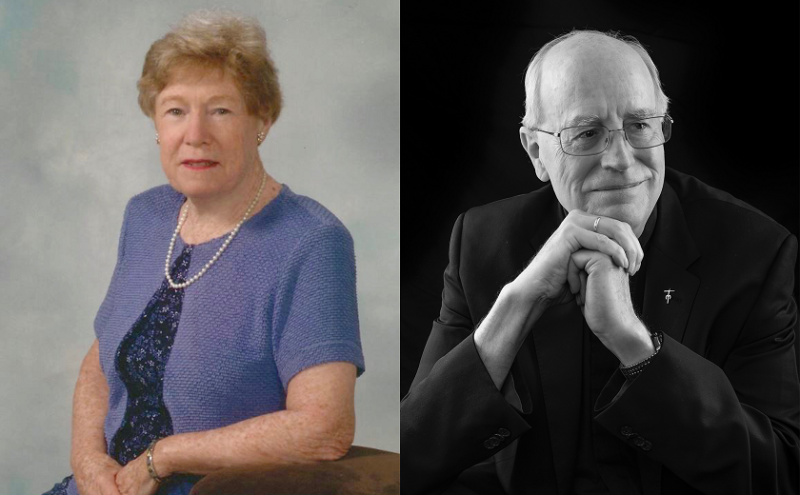
At the Faculty of Theology and Continuing Education Division’s 2019 Fall Convocation, not only will new scholars receive degrees qualifying them to conduct high-level research and teach, but two already-accomplished scholars will also receive special honours in recognition of their longstanding contributions. This year’s honorary degree recipients are Dr. Catherine B. Shannon and Dr. James Heft, SM (Marianist), both prolific researchers, writers and educators whose work embodies the ideals of the University of St. Michael’s College.
Dr. Shannon graduated from St. Michael’s with a B.A. in History in 1960, and went on to become a historian of Northern Ireland. In addition to her research on the historical roots of partition and the Northern Irish conflict, she worked to organize conferences and symposia during the 1980s and 1990s to promote dialogue between nationalist and unionist politicians. She has written on the impact of the conflict on Northern Irish women, and convened two conferences where women from Northern Ireland and the Republic discussed their aspirations for peace and their roles in achieving it.
In addition to her scholarship and advocacy, Dr. Shannon has served as a guest historian for museum and historical society exhibits. She has also served on the Executive Board of the American Conference of Irish Studies for over a decade, and has served as president of the Eire Society of Boston and the Charitable Irish Society of Boston.
Dr. Heft is a priest in the Society of Mary and has been a leader in Catholic higher education for over three decades. He received his MA in 1971 and his PhD in 1977 from the Faculty of Theology at St. Michael’s. For years, he served in a variety of teaching and administrative roles at the University of Dayton, where he chaired the Theology department before working as provost and then university chancellor. He departed in 2006 to found the Institute for Advanced Catholic Studies at the University of Southern California in Los Angeles.
The author or editor of 13 books on topics ranging from intellectual humility and interreligious dialogue to Catholic higher education, Dr. Heft has also published over 175 articles and book chapters. His book Catholic High Schools: Facing the New Realities (Oxford, 2011) was listed as a best-seller in a recent Oxford catalogue, and a new book on the future of Catholic higher education is under review with the same press. In recognition of his long and distinguished service to Catholic higher education, in 2011 the Association of Catholic Colleges and Universities made Dr. Heft the recipient of the Theodore M. Hesburgh award.
For their many contributions and accomplishments, Dr. Shannon will be conferred with a Doctor of Sacred Letters, honoris causa and Dr. Heft will be conferred with a Doctor of Divinity, honoris causa on Saturday, November 9 during a joint convocation for the Faculty of Theology and Continuing Education Division at St. Basil’s Church. A reception will follow in Fr. Madden Hall.
A list of all past recipients of honorary degrees from the University of St. Michael’s College can be found here.
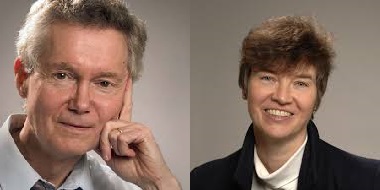
Dr. Margaret O’Gara was a doctoral candidate and Dr. Michael Vertin a professor of philosophy at St. Mike’s when the two wed at St. Basil’s Church in 1976. Over the course of 36 years of marriage not only did each become a legendary professor at the Faculty of Theology, with Dr. O’Gara known around the world for her work in ecumenism and Dr. Vertin for his expertise in Bernard Lonergan, but they amassed a remarkable – and sizeable – library.
Now in the process of downsizing following Dr. O’Gara’s death in 2012, Dr. Vertin has donated an estimated 900 books from the couple’s individual and shared collections to this year’s Friends of the Kelly Library book sale. The sale runs Sept. 24 to 28 in Carr Hall (100 St. Joseph St.).
The works donated from the couple’s library, carefully packed up by Dr. Vertin and delivered to volunteers in 40 bankers boxes, include books on everything from ecclesiology and ecumenism to scripture, patristics, and the philosophy of religion. Many of the items resided for years on simple pine book cases that Dr. O’Gara had built herself, an accomplishment, Dr. Vertin notes, that she felt quite pleased about.
When asked, Dr. Vertin notes there were some items he was unable to part with, including his 25-volume series on Lonergan, complete with its “red U of T Press binding.”
The annual used book sale, organized by the Friends of the John. M. Kelly Library, is designed to raise funds for the library, with proceeds earmarked for such projects as physical improvements, technology upgrades, and adding to collections.
Along with the Vertin/O’Gara donation, this year’s sale will feature a range of shopping options from first editions and art books through to academic works and pleasure reads.
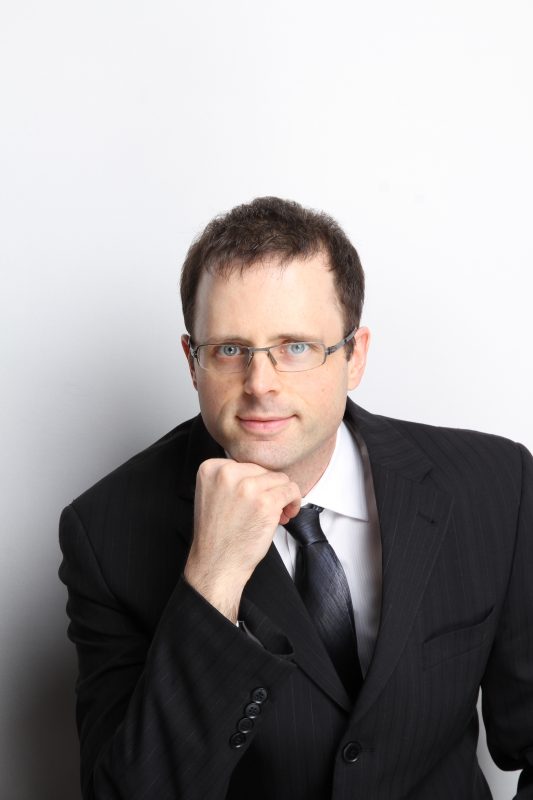
Faculty of Theology Dean Dr. James Ginther is delighted to announce that Dr. Jean-Pierre Fortin will be joining the faculty as Assistant Professor in Practical Theology and Pastoral Formation. Dr. Fortin takes up his position July 1, 2019, and will begin teaching in the Fall semester.
“Jean-Pierre’s work at the Institute of Pastoral Studies at Loyola makes him an ideal fit for us,” says Dr. Ginther. “His research profile and involvement in ecumenical dialogue will also be of great value to our community.”
Dr. Fortin’s most recent book is titled Grace in Auschwitz: A Holocaust Christology, and he is currently working on a book on the spiritual history of grace for Fortress Press. His research focusses on religious concerns and questions of 21st-century Christians.
Mentored as a student by world renowned St. Mike’s theologian Dr. Margaret O’Gara, Dr. Fortin earned an M.A. and a PhD in theology from St. Michael’s. He also holds a doctorate from Université Laval in Quebec City in the philosophy of science and a Licentiate in Sacred Theology from Regis College in Toronto.
As well as teaching at Chicago’s Loyola University, Dr. Fortin has also taught at Université de Sherbrooke in Quebec.
Coming to teach at St. Mike’s “constitutes a tremendous honour and opportunity to bear witness to the quality of the education I received,” Dr. Fortin says.
The duties of the practical theology position include teaching the Theology of Ministry and Reflection Seminar classes, as well as overseeing field placements. Field placements are an essential aspect of the Master of Divinity and Master of Religious Education programs at the Faculty, allowing students to practice under supervision the pastoral skills they have learned in the classroom and then come back to reflect on what they have learned about their abilities.
Dr. Fortin’s experience in the scholarship and teaching of spiritual direction will also enhance the Faculty’s pastoral formation program. “I hope to be able to inspire students to engage in a transformative search for truth leading to a new way of life in and for God,” he says.

